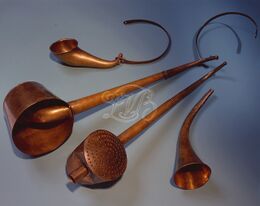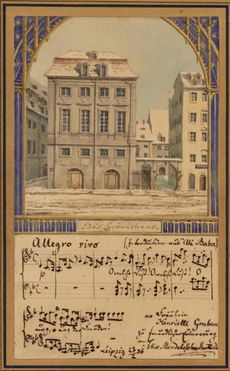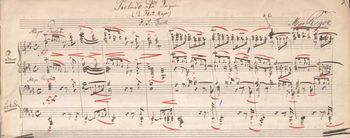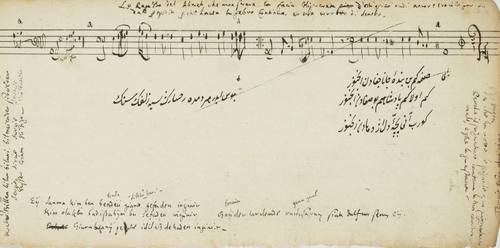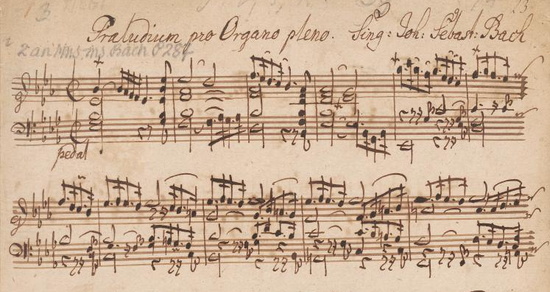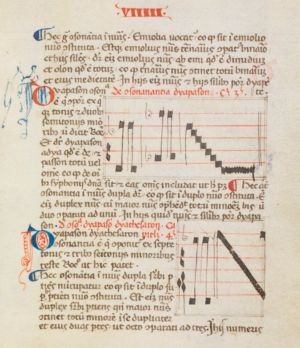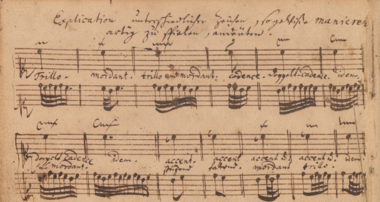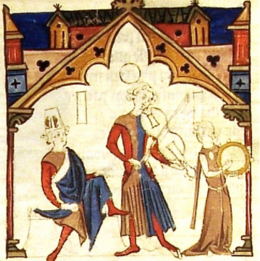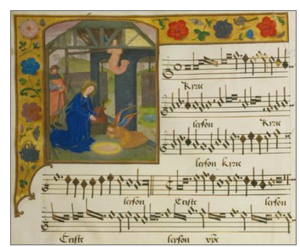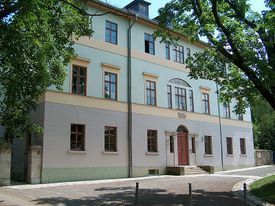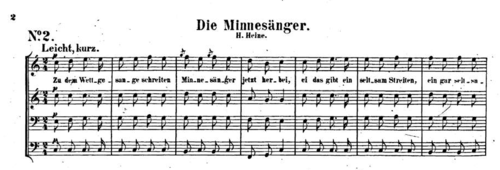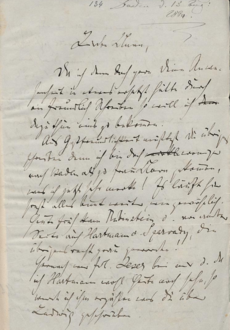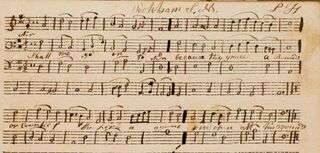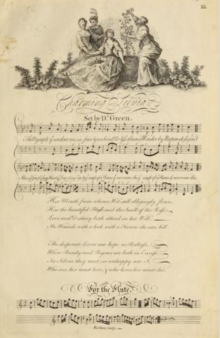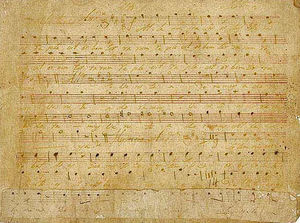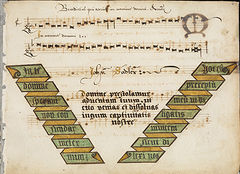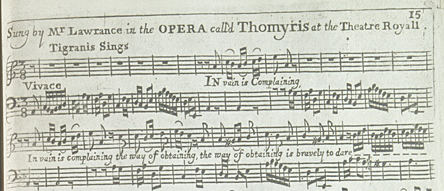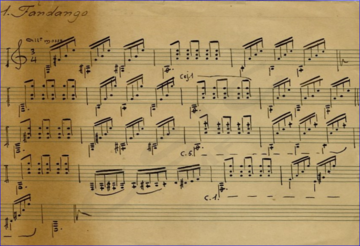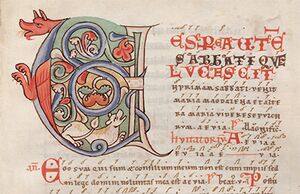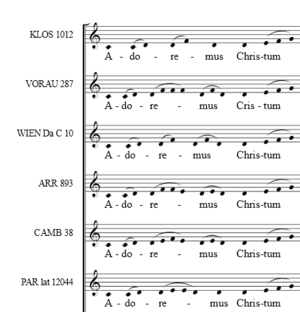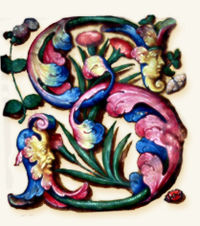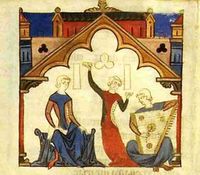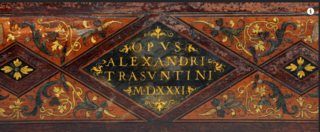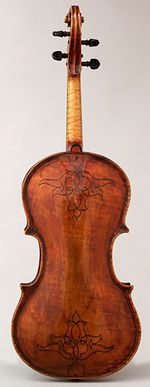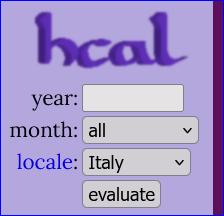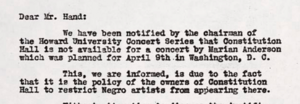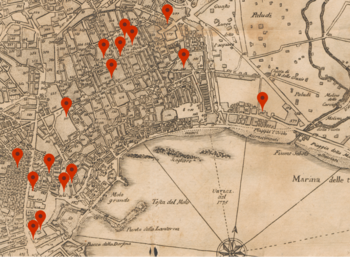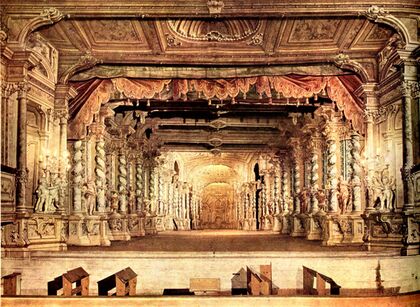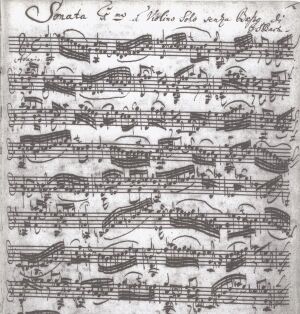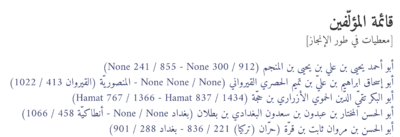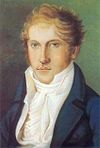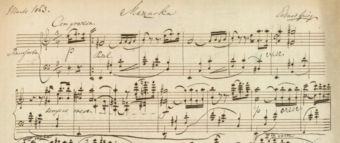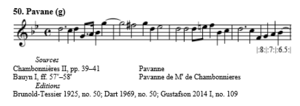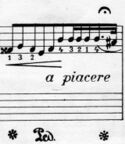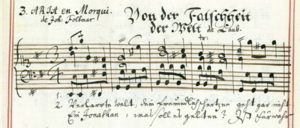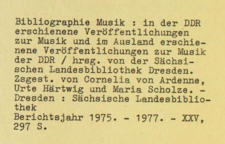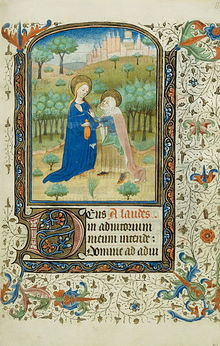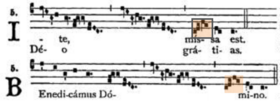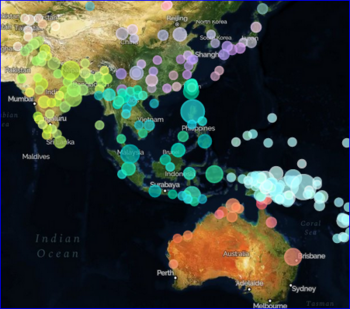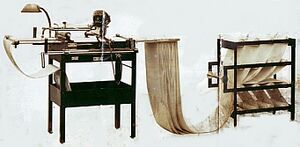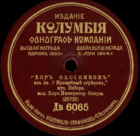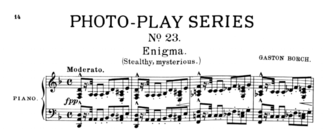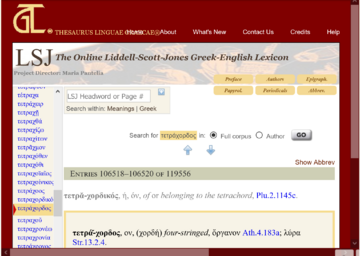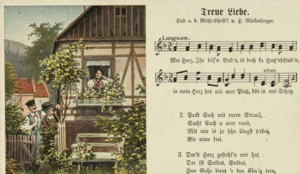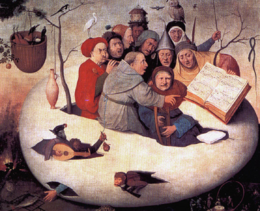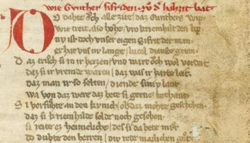Difference between revisions of "Links for Digital Musicology"
| (256 intermediate revisions by 2 users not shown) | |||
| Line 1: | Line 1: | ||
| − | This wiki provides links to substantial open-access projects of use to musicologists | + | This wiki provides links to substantial open-access projects of use to musicians and musicologists. For older projects that are not readily accessible online see [http://wiki.ccarh.org/wiki/ADAM ADAM]: Archive of Digital Applications in Musicology. For curated digital editions, see [http://wiki.ccarh.org/wiki/EVE_%28Electronic_and_Virtual_Editions%29 EVE]: Electronic and Virtual Editions. For a partitioned view, please see [http://wiki.ccarh.org/wiki/Digital_Resources_for_Musicology Digital Resources in Musicology]. |
| − | |||
| − | |||
| − | |||
| − | |||
| − | |||
| − | |||
| − | |||
| − | |||
| − | |||
| − | |||
| − | |||
| − | |||
| − | |||
| − | |||
| − | |||
| − | |||
| − | |||
| − | |||
| − | |||
| − | |||
| − | |||
| − | |||
| − | |||
| − | |||
| − | |||
| − | |||
| − | |||
| − | For | ||
| − | |||
| − | |||
| − | |||
| − | |||
| − | |||
| − | |||
| − | |||
| − | |||
| − | |||
| − | |||
| − | |||
| − | |||
| − | |||
| − | |||
| − | |||
| − | |||
| − | |||
| − | |||
| − | |||
| − | |||
| − | |||
| − | |||
| − | |||
| − | |||
| − | |||
| − | |||
| − | |||
| − | |||
| − | |||
| − | |||
| − | |||
| − | |||
| − | |||
| − | |||
| − | |||
| − | |||
| − | |||
| − | |||
| − | |||
| − | |||
| − | |||
| − | |||
| − | |||
| − | |||
| − | |||
| − | |||
| − | |||
| − | |||
| − | |||
| − | |||
| − | |||
| − | |||
| − | |||
| − | |||
| − | |||
| − | |||
| − | |||
| − | |||
| − | |||
| − | |||
| − | |||
| − | |||
| − | |||
| − | |||
| − | |||
| − | |||
| − | |||
| − | |||
| − | |||
| − | |||
| − | |||
| − | |||
| − | |||
| − | |||
| − | |||
| − | |||
| − | |||
| − | |||
| − | |||
| − | |||
| − | |||
| − | |||
| − | |||
| − | |||
| − | |||
| − | |||
| − | |||
| − | |||
| − | |||
| − | |||
| − | |||
| − | |||
| − | |||
| − | |||
| − | |||
| − | |||
| − | |||
| − | |||
| − | |||
| − | |||
| − | |||
| − | |||
| − | |||
| − | |||
| − | |||
| − | |||
| − | |||
| − | |||
| − | |||
| − | |||
| − | |||
| − | |||
| − | |||
| − | |||
| − | |||
| − | |||
| − | |||
| − | |||
| − | |||
| − | |||
| − | |||
| − | |||
| − | |||
| − | |||
| − | |||
| − | |||
| − | |||
| − | |||
==Digitized Music Manuscripts== | ==Digitized Music Manuscripts== | ||
| + | {{DRM_manuscripts}} | ||
| − | === | + | ==Digitized Score Reprints== |
| − | + | {{DRM_reprints}} | |
| − | |||
| − | |||
| − | |||
| − | |||
| − | |||
| − | |||
| − | |||
| − | |||
| − | |||
| − | |||
| − | |||
| − | |||
| − | |||
| − | |||
| − | |||
| − | |||
| − | |||
| − | |||
| − | |||
| − | |||
| − | |||
| − | |||
| − | |||
| − | |||
| − | |||
| − | |||
| − | |||
| − | |||
| − | |||
| − | |||
| − | |||
| − | |||
| − | |||
| − | |||
| − | |||
| − | |||
| − | |||
| − | |||
| − | |||
| − | |||
| − | |||
| − | |||
| − | |||
| − | |||
| − | |||
| − | |||
| − | |||
| − | |||
| − | |||
| − | |||
| − | |||
| − | |||
| − | |||
| − | |||
| − | |||
| − | |||
| − | |||
| − | |||
| − | |||
| − | |||
| − | |||
| − | |||
| − | |||
| − | |||
| − | |||
| − | |||
| − | |||
| − | |||
| − | |||
| − | |||
| − | |||
| − | |||
| − | |||
| − | |||
| − | |||
| − | |||
| − | |||
| − | |||
| − | |||
| − | |||
| − | |||
| − | |||
| − | |||
| − | |||
| − | |||
| − | |||
| − | |||
| − | |||
| − | |||
| − | |||
| − | |||
| − | |||
| − | |||
| − | |||
| − | |||
| − | |||
| − | |||
| − | |||
| − | |||
| − | |||
| − | |||
| − | |||
| − | |||
| − | |||
| − | |||
| − | |||
| − | |||
| − | |||
| − | |||
| − | |||
| − | |||
| − | |||
| − | |||
| − | |||
| − | |||
| − | |||
| − | |||
| − | |||
| − | |||
| − | |||
| − | |||
| − | |||
| − | |||
| − | |||
| − | |||
| − | |||
| − | |||
| − | |||
| − | |||
| − | |||
| − | |||
| − | |||
| − | |||
| − | |||
| − | |||
| − | |||
| − | |||
| − | |||
| − | |||
| − | |||
| − | |||
| − | |||
| − | |||
| − | |||
| − | |||
| − | |||
| − | |||
| − | |||
| − | |||
| − | |||
| − | |||
| − | |||
| − | |||
| − | |||
| − | |||
| − | |||
| − | |||
| − | |||
| − | |||
==Repertory- and Genre-Based Digitization Projects== | ==Repertory- and Genre-Based Digitization Projects== | ||
| + | {{DRM_genre}} | ||
| − | == | + | ==Structured Databases== |
| − | + | {{DRM_databases}} | |
| − | |||
| − | |||
| − | |||
| − | |||
| − | |||
| − | |||
| − | |||
| − | |||
| − | |||
| − | |||
| − | |||
| − | |||
| − | |||
| − | |||
| − | |||
| − | |||
| − | |||
| − | |||
| − | |||
| − | |||
| − | |||
| − | |||
| − | |||
| − | |||
| − | |||
| − | |||
| − | |||
| − | |||
| − | |||
| − | |||
| − | |||
| − | |||
| − | |||
| − | |||
| − | |||
| − | |||
| − | |||
| − | |||
| − | |||
| − | |||
| − | |||
| − | |||
| − | |||
| − | |||
| − | |||
| − | |||
| − | |||
| − | |||
| − | |||
| − | |||
| − | |||
| − | |||
| − | |||
| − | |||
| − | |||
| − | |||
| − | |||
| − | |||
| − | |||
| − | |||
| − | |||
| − | |||
| − | |||
| − | |||
| − | |||
| − | |||
| − | |||
| − | |||
| − | |||
| − | |||
| − | |||
| − | |||
| − | |||
| − | |||
| − | |||
| − | |||
| − | |||
| − | |||
| − | |||
| − | |||
| − | |||
| − | |||
| − | |||
| − | |||
| − | |||
| − | |||
| − | |||
| − | |||
| − | |||
| − | |||
| − | |||
| − | |||
| − | |||
| − | |||
| − | |||
| − | |||
| − | |||
| − | |||
| − | |||
| − | |||
| − | |||
| − | |||
| − | |||
| − | |||
| − | |||
| − | |||
| − | |||
| − | |||
| − | |||
| − | |||
| − | |||
| − | |||
| − | |||
| − | |||
| − | |||
| − | |||
| − | |||
| − | |||
| − | |||
| − | |||
| − | |||
| − | |||
| − | |||
| − | |||
| − | |||
| − | |||
| − | |||
| − | |||
| − | |||
| − | |||
| − | |||
| − | |||
| − | |||
| − | |||
| − | |||
| − | |||
| − | |||
| − | |||
| − | |||
| − | |||
| − | |||
| − | |||
| − | |||
| − | |||
| − | |||
| − | |||
| − | |||
| − | |||
| − | |||
| − | |||
| − | |||
| − | |||
| − | |||
| − | |||
| − | |||
| − | |||
| − | |||
| − | |||
| − | |||
| − | |||
| − | |||
| − | |||
| − | |||
| − | |||
| − | |||
| − | |||
| − | |||
| − | |||
| − | |||
| − | |||
| − | |||
| − | |||
| − | |||
| − | |||
| − | |||
| − | |||
| − | |||
| − | |||
| − | |||
| − | |||
| − | |||
| − | |||
| − | |||
| − | |||
| − | |||
| − | |||
| − | |||
| − | |||
| − | |||
| − | |||
| − | |||
| − | |||
| − | |||
| − | |||
| − | |||
| − | |||
| − | |||
| − | |||
| − | |||
| − | |||
| − | |||
| − | |||
| − | |||
| − | |||
| − | |||
| − | |||
| − | |||
| − | |||
| − | |||
| − | |||
| − | |||
| − | |||
| − | |||
| − | |||
| − | |||
| − | |||
| − | |||
| − | |||
| − | |||
| − | |||
| − | |||
| − | |||
| − | |||
| − | |||
| − | |||
| − | |||
| − | |||
| − | |||
| − | |||
| − | |||
| − | |||
| − | |||
| − | |||
| − | |||
| − | |||
| − | |||
| − | |||
| − | |||
| − | |||
| − | |||
| − | |||
| − | |||
| − | |||
| − | |||
| − | |||
| − | |||
| − | |||
| − | |||
| − | |||
| − | |||
| − | |||
| − | |||
| − | |||
| − | |||
| − | |||
| − | |||
| − | |||
| − | |||
| − | |||
| − | |||
| − | |||
| − | |||
| − | |||
| − | |||
| − | |||
| − | |||
| − | |||
| − | |||
| − | |||
| − | |||
| − | |||
| − | |||
| − | |||
| − | |||
| − | |||
| − | |||
| − | |||
| − | |||
| − | |||
| − | |||
| − | |||
| − | |||
| − | |||
| − | |||
| − | |||
| − | |||
| − | |||
| − | |||
| − | |||
| − | |||
| − | |||
| − | |||
| − | |||
| − | |||
| − | |||
| − | |||
| − | |||
| − | |||
| − | |||
| − | |||
| − | |||
| − | |||
| − | |||
| − | |||
| − | |||
| − | |||
| − | |||
| − | |||
| − | |||
| − | |||
| − | |||
| − | |||
| − | |||
| − | |||
| − | |||
| − | |||
| − | |||
| − | |||
| − | |||
| − | |||
| − | |||
| − | |||
| − | |||
| − | |||
| − | |||
| − | |||
| − | |||
| − | |||
| − | |||
| − | |||
| − | |||
| − | |||
| − | |||
| − | |||
| − | |||
| − | |||
| − | |||
| − | |||
| − | |||
| − | |||
| − | |||
| − | |||
| − | |||
| − | |||
| − | |||
| − | |||
| − | |||
| − | |||
| − | |||
| − | |||
| − | |||
| − | |||
| − | |||
| − | |||
| − | |||
| − | |||
| − | |||
| − | |||
| − | |||
| − | |||
| − | |||
| − | |||
| − | |||
| − | |||
| − | |||
| − | |||
| − | |||
| − | |||
| − | |||
| − | |||
| − | |||
| − | |||
| − | |||
| − | |||
| − | |||
| − | |||
| − | |||
| − | |||
| − | |||
| − | |||
| − | |||
| − | |||
| − | |||
| − | |||
| − | |||
| − | |||
| − | |||
| − | |||
| − | |||
| − | |||
| − | |||
| − | |||
| − | |||
| − | |||
| − | |||
| − | |||
| − | |||
| − | |||
| − | |||
| − | |||
| − | |||
| − | |||
| − | |||
| − | |||
==Portals and Search Engines for Music== | ==Portals and Search Engines for Music== | ||
| + | {{DRM_portals}} | ||
| − | + | ==Resources for Music Theory== | |
| − | + | {{DRM_music_theory}} | |
| − | |||
| − | |||
| − | |||
| − | |||
| − | |||
| − | |||
| − | |||
| − | |||
| − | |||
| − | |||
| − | |||
| − | |||
| − | |||
| − | |||
| − | |||
| − | |||
| − | |||
| − | |||
| − | |||
| − | |||
| − | |||
| − | |||
| − | |||
| − | |||
| − | |||
| − | |||
| − | |||
| − | |||
| − | |||
| − | |||
| − | |||
| − | |||
| − | |||
| − | |||
| − | |||
| − | |||
| − | |||
| − | |||
| − | |||
| − | |||
| − | |||
| − | |||
| − | |||
| − | |||
| − | |||
| − | |||
| − | |||
| − | |||
| − | |||
| − | |||
| − | |||
| − | |||
| − | |||
| − | |||
| − | |||
| − | |||
| − | |||
| − | |||
| − | |||
| − | |||
| − | |||
| − | |||
| − | |||
| − | |||
| − | |||
| − | |||
| − | |||
| − | |||
| − | |||
| − | |||
| − | |||
| − | |||
| − | |||
| − | |||
| − | |||
| − | |||
| − | |||
| − | |||
| − | |||
| − | |||
==Historical Audio and Video (Film)== | ==Historical Audio and Video (Film)== | ||
| − | + | {{DRM_audio_video}} | |
| − | |||
| − | |||
| − | |||
| − | |||
| − | |||
| − | |||
| − | |||
| − | |||
| − | |||
| − | |||
| − | |||
| − | |||
| − | |||
| − | |||
| − | |||
| − | |||
| − | |||
| − | |||
| − | |||
| − | |||
| − | |||
==Historical Maps== | ==Historical Maps== | ||
| + | {{DRM_maps}} | ||
| − | == | + | ==Early Newspapers== |
| − | + | {{DRM_newspapers}} | |
| − | |||
| − | |||
| − | |||
| − | |||
| − | |||
| − | |||
| − | |||
| − | |||
| − | |||
| − | |||
| − | |||
| − | |||
| − | |||
| − | |||
| − | |||
| − | |||
| − | |||
| − | |||
| − | |||
| − | |||
| − | |||
| − | |||
| − | |||
| − | |||
| − | |||
| − | |||
| − | |||
| − | |||
| − | |||
| − | |||
| − | |||
| − | |||
| − | |||
| − | |||
| − | |||
==Music Magazines== | ==Music Magazines== | ||
| + | {{DRM_magazines}} | ||
| − | == | + | ==Large Humanities Digital Corpora== |
| − | + | {{DRM_texts}} | |
| − | |||
| − | |||
| − | |||
| − | |||
| − | |||
| − | |||
| − | |||
| − | |||
| − | |||
| − | |||
| − | |||
| − | |||
| − | |||
| − | |||
| − | |||
| − | |||
| − | |||
| − | |||
| − | |||
| − | |||
| − | |||
| − | |||
| − | |||
| − | |||
| − | |||
| − | |||
| − | |||
| − | |||
| − | |||
| − | |||
| − | |||
| − | |||
| − | |||
| − | |||
| − | |||
| − | |||
| − | |||
| − | |||
| − | |||
| − | |||
| − | |||
| − | |||
| − | |||
| − | |||
| − | |||
| − | |||
| − | |||
| − | |||
| − | |||
| − | + | ===Austrian Music lexicon (Oesterreichisches Musiklexikon online [OEML])=== | |
| − | + | Website: [https://www.musiklexikon.ac.at/ml/projekt.htm Austrian Music Lexicon/Oesterreichisches Musiklexikon online] | |
| − | + | A great diversity of materials and formats is included here. Most cover pages lead to lists and bibliographies. Each article has its own DOI (Digital Object Identifier). The full-text search is very useful but not always comprehensive. Some articles are tied to current concert life and contain links to online ticket sales. | |
| − | ==== | + | ==Image Banks and Iconography== |
| + | {{DRM_images}} | ||
| − | + | ==Copyright== | |
| + | {{DRM_copyright}} | ||
| − | + | ==About== | |
| + | {{DRM_credits}} | ||
Latest revision as of 23:26, 20 September 2022
This wiki provides links to substantial open-access projects of use to musicians and musicologists. For older projects that are not readily accessible online see ADAM: Archive of Digital Applications in Musicology. For curated digital editions, see EVE: Electronic and Virtual Editions. For a partitioned view, please see Digital Resources in Musicology.
Contents
- 1 Digitized Music Manuscripts
- 1.1 By Composer
- 1.2 Ludwig van Beethoven: Beethoven-Haus, Bonn
- 1.3 Beethoven Autographs Online
- 1.4 Beethovens Werkstatt (Beethoven's Workshop)
- 1.5 Johannes Brahms Institute
- 1.6 Web Archive Anton Bruckner
- 1.7 John Cage Living Archive
- 1.8 The Aaron Copland Collection (Library of Congress)
- 1.9 Materials pertaining to Edvard Grieg
- 1.10 Handel's Messiah and other virtual "page-turners" from the British Library
- 1.11 Handel autographs and other music manuscripts
- 1.12 Michael Haydn Manuscripts
- 1.13 Gustav Mahler Autograph Manuscripts
- 1.14 Felix Mendelssohn Materials (Library of Congress)
- 1.15 Carl Orff Autograph Manuscripts
- 1.16 Max Reger Autograph Manuscripts
- 1.17 Cipriano de Rore: Illuminated Choirbook from the Court of Albrecht V
- 1.18 The Arnold Schönberg Center
- 1.19 Schubert Online
- 1.20 Strauss Online
- 1.21 Richard Strauss: Musical Autographs
- 1.22 Verdi Online
- 1.23 Georg Josef Vogler Music Manuscripts
- 1.24 Richard Wagner: Notebooks, music manuscripts, and correspondence
- 1.25 Robert Ward Papers
- 1.26 Manuscripts of Ermanno Wolf-Ferrari
- 1.27 By Collection
- 1.28 Corpus Musicae Ottomanicae (CMO)
- 1.29 Digital Collections in the Berlin State Library
- 1.30 Digitized Manuscripts in the University and Regional Library Darmstadt
- 1.31 Rare Music Manuscripts in the British Library
- 1.32 E-codices: The Virtual Manuscript Library of Switzerland
- 1.33 Early Keyboard Manuscripts at Yale University
- 1.34 Fragmentarium
- 1.35 Gaffurius Codices Online
- 1.36 Handrit: Historical (Music) Manuscripts from Iceland
- 1.37 Integrated Database for Early Music (IDEM)
- 1.38 The Juilliard Manuscript Collection
- 1.39 Music Gifts for the Russian Emperors
- 1.40 Music Manuscripts in the Bavarian State Library
- 1.41 The Moldenhauer Archives (Contemporary Music in Manuscript)
- 1.42 Music Manuscripts in the Marciana National Library (Venice)
- 1.43 Music Manuscripts Online
- 1.44 Nuova Biblioteca Manoscritta (NBM)
- 1.45 ORFEUS: The Post-Tridentine Music of Silence in the Cloister of S. Bento de Castris, Evora
- 1.46 Music Treasures Consortium
- 1.47 POLONA
- 1.48 Saxon State Library (SLUB), Dresden: Royal Private Music Collection
- 1.49 Saxon State Library (SLUB): Court Music in Dresden
- 1.50 Slovenian Digital Library
- 1.51 Spanish Digital Library (Biblioteca Nacional Hispanica)
- 1.52 By Repertory
- 1.53 Cambridge Lute Books
- 1.54 Cantigas Medievais Galego-Portuguesas
- 1.55 Cantus Planus
- 1.56 Musica restaurata
- 1.57 Polish Benedictine Music
- 1.58 Scottish Fiddle Tunes (Collections)
- 1.59 Swedish Musical Heritage
- 2 Digitized Score Reprints
- 2.1 By Composer
- 2.2 Ludwig van Beethovens Werke
- 2.3 Brahms Institute: Digital Archive
- 2.4 Chopin's First Editions Online (CFEO)
- 2.5 Jagiellonian Digital Library: Chopin holdings
- 2.6 University of Chicago: Chopin Early Editions
- 2.7 Online Chopin Variorum Editions (OCVE)
- 2.8 Georg Friedrich Händels Werke]
- 2.9 Franz Liszt Musikalische Werke
- 2.10 Jean-Baptiste Lully Collection (University of North Texas)
- 2.11 Felix Mendelssohn Bartoldys Werke
- 2.12 Neue Mozart Ausgabe Online
- 2.13 Ignaz Pleyel Early Editions
- 2.14 Franz Schuberts Werke
- 2.15 Robert Schumann Werke
- 2.16 Tomás Luis de Victoria
- 2.17 By Collection
- 2.18 Monuments of German Music, Series 1
- 2.19 Monuments of German Music, Series 2 (Bavaria)
- 2.20 Duben Collection Database Search
- 2.21 Eastman School of Music/Sibley Music Library
- 2.22 Gaspari Online (Bologna Conservatory)
- 2.23 Printed Music in the Bavarian State Library
- 2.24 Printed Music in the Prussian State Library
- 2.25 By Publisher
- 2.26 Nicolas Du Chemin: Chansons Nouvelles
- 2.27 Sheet Music Collections and Miscellanies
- 2.28 University of Michigan list of sheet music collections
- 2.29 The Sheet Music Cconsortium: A one-stop shop for cross-collection access
- 2.30 African American Sheet Music
- 2.31 American Sacred Music
- 2.32 American Vernacular Music Manuscripts
- 2.33 Archive of Popular American Music
- 2.34 The Drs. Whitby Music Collection
- 2.35 Historic American Sheet Music HASM (Duke University)
- 2.36 Irish Sheet Music Archives
- 2.37 Lester Levy Sheet Music Collection
- 2.38 Lilly Library Sheet Music Collections
- 2.39 Music for the Nation: American Sheet Music 1870-1885
- 2.40 Netherlands Radio Music Library
- 2.41 Nineteenth-Century American Sheet Music (NcASM)
- 2.42 Nineteenth-Century California Sheet Music
- 2.43 St. Petersburg Score Collection
- 2.44 University of North Carolina (UNC)
- 2.45 University of Toronto Music Faculty Collection
- 2.46 World War I Sheet Music
- 2.47 Yiddish Sheet Music
- 3 Repertory- and Genre-Based Digitization Projects
- 3.1 Instrument-specific Collections
- 3.2 The International Harp Archives
- 3.3 Liturgical Music
- 3.4 Global Chant Database: See Search Engines
- 3.5 Brazilian Sacred Music (Mariana Museum of Music)
- 3.6 Liber Usualis
- 3.7 The Sarum Rite
- 3.8 Sequentia
- 3.9 Drama (with music)
- 3.10 Records of Early English Drama (REED Online)
- 3.11 Part-books and Choir Books
- 3.12 Early Music (Anthologies) Online
- 3.13 Bologna Partbooks (secular music)
- 3.14 Chant and Polyphony at the Munich Digitization Center (MDZ)
- 3.15 The Trent Codices (Fifteenth-Century Polyphony)
- 3.16 Tudor Partbooks
- 3.17 Jazz
- 3.18 Jazzomat Research Project
- 3.19 Opera
- 3.20 Early Nineteenth-Century Opera
- 3.21 Opera in Italy, Austria, and Germany (1770-1830)
- 3.22 Other Genres and Traditions
- 3.23 American Vernacular Music Manuscripts (ca. 1730-1910)
- 3.24 Singing upon the Note (Early Music for Vocal Improvisation)
- 3.25 Gospel Music History Archives
- 3.26 Arthur Kleiner Collection of Silent Movie Music
- 3.27 Lute Online Resources Portal (LORP)
- 3.28 Partitura organum
- 3.29 Renaissance Music in Croatia
- 3.30 Silent Film Scores and Arrangements (Library of Congress)
- 3.31 The Spirituals Database
- 3.32 Institutional Histories
- 3.33 Boston Handel and Haydn Society
- 3.34 Boston Symphony Orchestra Archives
- 3.35 New York Philharmonic Leon Levy Digital Library
- 3.36 Performance History
- 3.37 Stockhausen Concerts Database
- 3.38 Bio-bibliographical resources
- 3.39 Sorabji Resource Site
- 4 Structured Databases
- 4.1 Secular Vocal and Folksong Repertories
- 4.2 Bodleian Library Broadside Ballads Catalogue
- 4.3 Books of Hispanic Polyphony (BHP)
- 4.4 César: French Theatrical Database
- 4.5 Catalogue de la Chanson Française à la Renaissance (Chanson Database)
- 4.6 CLORI: Archive of the Italian Cantata
- 4.7 Deutsches Volksliedarchiv (German Folksong Archive)
- 4.8 Early American Sacred Music
- 4.9 EASMUS: Early American Secular Music and its European Sources
- 4.10 English Broadside Ballad Archive
- 4.11 HUAPALA: Hawaiian Lyrics and Hula Archives
- 4.12 Loire Valley Chanson Sources
- 4.13 Old English Songs
- 4.14 Fondo de Música Tradicional (Traditional Music of Spain)
- 4.15 VolksLiedWerke (Austrian Folksong Database)
- 4.16 Sacred and Liturgical Music
- 4.17 Antiphonale Synopticum
- 4.18 CANTUS Manuscript Database: A Database for Latin Ecclesiastical Chant
- 4.19 Cantus Fractus Database (Projetto Raphael)
- 4.20 Cantus Planus Austria
- 4.21 Cantus Planus Regensburg
- 4.22 Cantus Ultimus
- 4.23 ChantDigger
- 4.24 Comparatio (Chant Comparison)
- 4.25 Corpus Pulcriorem Invenire (CPI-I): Online catalogue of Conductus poetry and musical settings
- 4.26 Differentiae Database
- 4.27 Digital Analysis of Chant Transmission (DACT)
- 4.28 Fontes Cantus Bohemiae
- 4.29 Gregorien
- 4.30 Hungarian Chant Database
- 4.31 Hymn Tune Index
- 4.32 Mass Database (Mainz)
- 4.33 Mass, Office, and Holy Week Music Printed in Italy (1518-1770)
- 4.34 Medieval Music Manuscripts, Austria
- 4.35 Medieval Music Database (MMD)
- 4.36 Motet Database (1475-1600)
- 4.37 Motets printed in France (Motet imprimé en France 1647-1789)
- 4.38 Musica Sacra
- 4.39 Musicat
- 4.40 Plainchant Sources in Poland (Cantus Planus in Polonia)
- 4.41 Portuguese Early Music (PEM) Database
- 4.42 Printed Sacred Music Database
- 4.43 Psalm Database (Psalmendatenbank)
- 4.44 RELICS (Renaissance Liturgical Imprints)
- 4.45 Slovak Early Music Database (Cantus Planus in Slovakia)
- 4.46 Spanish Early Music Manuscripts (Musica Hispanica)
- 4.47 Instrumental Music
- 4.48 The Clarinet Quintet
- 4.49 Classical String Quartets
- 4.50 Hof-Musik (Court Music)
- 4.51 Jazzomat Research Project (Weimar Jazz Database)
- 4.52 Instrument Makers and Collections
- 4.53 Boalch-Mould Online: A research database of harpsichords and clavichords, 1440–1925
- 4.54 Liuteria Bresciana: Brescian Instrument Makers
- 4.55 MINIM-UK
- 4.56 Music Instrument Museums Online (MIMO)
- 4.57 National Music Museum
- 4.58 The Piano in Polish Collections
- 4.59 Polish Folk Instruments
- 4.60 Historical and Liturgical Calendars
- 4.61 Historical Calendars of Europe (HCAL)
- 4.62 Liturgical Calendars
- 4.63 Performers and Musical Personnel
- 4.64 Marian Anderson: Diaries and Notebooks
- 4.65 Musico Napolitano (Neapolitan Musician)
- 4.66 Other Rubrics
- 4.67 British Music Festivals Repertoire (1695-1940)
- 4.68 European Theatre Architecture (EUTA)
- 4.69 Germania Sacra
- 4.70 Medici Archive Project
- 4.71 Reid Concerts
- 4.72 Composer/Theorist Documentation
- 4.73 Bach Digital
- 4.74 Max Bruch Archive
- 4.75 Irving Berlin Collection (Library of Congress)
- 4.76 Arrigo Boito Papers (Archivio Boito Digitale)
- 4.77 Aaron Copland Collection (Library of Congress)
- 4.78 Fux Online
- 4.79 Handel Reference Database
- 4.80 Lassus Manuscript Database
- 4.81 Mozart Correspondence
- 4.82 Mozart Family: Letters and Documents (1755-1879)
- 4.83 In Mozart's Words
- 4.84 Mozart: New Documents
- 4.85 Ricordi Historical Archives: Verdi Correspondence and Memorabilia
- 4.86 Saramusic (Arabic manuscripts and texts on music)
- 4.87 Schenker Documents Online
- 4.88 Franz Schubert Online
- 4.89 Ludwig Senfl Online
- 4.90 Louis Spohr Correspondence
- 4.91 Giuseppe Verdi Correspondence (Braidense Library)
- 4.92 Digitized Manuscripts and Early Printed Music
- 4.93 Danish National Digital Sheet Music Archive
- 4.94 Darmstadt University and State Library Digital Manuscript Collection
- 4.95 Early Music Online
- 4.96 National Library of Scotland
- 4.97 Singakademie Music Archives
- 4.98 Online Thematic Catalogues and Indices
- 4.99 The Bizet Catalogue
- 4.100 Benjamin Britten Thematic Catalogue
- 4.101 Chambonnières: A Thematic Catalogue
- 4.102 Frescobaldi Thematic Catalogue Online
- 4.103 GWV - Graupner-Werke-Verzeichnis (Thematic Catalogue of the Works of Christoph Graupner)
- 4.104 J.P.E. Hartmann Catalogue (Thematic-Bibliographic Catalogue of His Works)
- 4.105 Franz Liszt: Digital Liszt Sources and Works Catalog)
- 4.106 Catalogue of Carl Nielsen's Works
- 4.107 Johann Adolph Scheibe: A Catalogue of his Works
- 4.108 Printed music resources
- 4.109 Prices of Music at Breitkopf & Härtel
- 4.110 Verzeichnis deutscher Musikfrühdrucke / Catalogue of early German printed music
- 4.111 Ethnomusicology
- 4.112 OSMIKON
- 4.113 Philippine Indigenous Instrument Sounds (Katunog)
- 4.114 UNC Middle Eastern Music
- 4.115 Tunisian Recordings (CMAM)
- 4.116 Resources for Chronology
- 4.117 Music Bibliography in the German Democratic Republic
- 4.118 Hofmeister XIX
- 4.119 Libretto Portals
- 4.120 Corago Project
- 4.121 Corniani-Algarotti Libretto Collection
- 4.122 Russian Opera Libretti
- 4.123 Albert Schatz Collection (Library of Congress)
- 4.124 VifaMusik Libretto Portal
- 4.125 Index to Opera and Ballet Sources Online
- 5 Portals and Search Engines for Music
- 5.1 Cantorales de la Biblioteca Nacional de Espana
- 5.2 Cantus Index
- 5.3 Dutch Song Database and Search Engine (Nederlandse Liederenbank)
- 5.4 E-manuscripta
- 5.5 Europeana: Search Engine for European (Music) Sources
- 5.6 European History Primary Sources
- 5.7 Gallica
- 5.8 Global Chant
- 5.9 Index to Opera and Ballet Sources Online
- 5.10 The Internet Culturale
- 5.11 OSMIKON
- 5.12 Machaut (Mirador) Viewer
- 5.13 Munich Digital Manuscript Collection
- 5.14 MusicBrainz
- 5.15 Musiconn Score Search
- 5.16 Musiekschatten (Music Treasures)
- 5.17 Open Music Library
- 5.18 Peachnote Music n-Gram Viewer
- 5.19 RISM: Répertoire International des Sources Musicales
- 5.20 Schoenberg Database of Manuscripts
- 5.21 SIMSSA
- 5.22 Song Helix (repertory search)
- 5.23 Themefinder: Musical-incipit search
- 5.24 Vocal Music Instrumentation Index (VMII)
- 5.25 World Digital Library
- 6 Resources for Music Theory
- 7 Historical Audio and Video (Film)
- 7.1 Archives Sonores CREM-CNRS
- 7.2 Berliner Gramophone Disc Collection (Archives at Yale)
- 7.3 Center for the History and Analysis of Recorded Music (CHARM Archive)
- 7.4 CHARM
- 7.5 Classical Discography
- 7.6 Cylinder Preservation Project, UCSB
- 7.7 DEKKMMA (Sound Archive of the Royal Museum for Central Africa)
- 7.8 The Edison Recorded Sound Archive
- 7.9 The Emile Berliner Collection (Library of Congress)
- 7.10 Gharamophone
- 7.11 The Glenn Gould Archive
- 7.12 The Global Jukebox
- 7.13 Historical Tenors
- 7.14 Internet Archive 78RPMs
- 7.15 Ivey Collection of Electronic Music (Peabody Conservatory)
- 7.16 Mirskey Collection of Salon Orchestra and Silent Film Music
- 7.17 The National Jukebox (US)
- 7.18 New Zealand Pianola Site
- 7.19 O'Neill Cylinder Recordings
- 7.20 Player Piano (Pianola) Project, Stanford University
- 7.21 Russian Records
- 7.22 Silent Film Sound and Music Archive
- 7.23 Robert Shaw Chorale
- 7.24 Trachtman Roll Scanning
- 7.25 ViFaMusik Audio Collections
- 7.26 The Virtual Gramophone: Canadian Historical Sound Recordings
- 8 Historical Maps
- 8.1 AfricaMap
- 8.2 Bodleian Libraries Digital Collections (Maps)
- 8.3 British Historical Maps
- 8.4 China Historical GIS
- 8.5 Georeferencer
- 8.6 Getty Thesaurus of Geographic Names
- 8.7 Munich Digitalization Center (Maps)
- 8.8 Old Maps Online (OMO)
- 8.9 Pelagios (Graeco-Roman Antiquity)
- 8.10 David Rumsey Map Collection (Stanford University)
- 8.11 Perry-Castañeda Historical Maps (University of Texas)
- 9 Early Newspapers
- 10 Music Magazines
- 11 Large Humanities Digital Corpora
- 11.1 Deutsches Textarchiv (German Text Archive)
- 11.2 Collaborative Digital Libraries Gateway
- 11.3 Early English Books Online (EEBO)
- 11.4 European History Primary Sources
- 11.5 Medieval Nordic Text Archive (MNTA)
- 11.6 Oxford Text Archive (OTA)
- 11.7 Perseus Digital Library
- 11.8 Packard Humanities Institute Early Texts
- 11.9 Rousseau Online
- 11.10 TextGrid Repository
- 11.11 Théâtre classique (Classic Theater)
- 11.12 Thesaurus Linguae Graecae (TLG)
- 11.13 Austrian Music lexicon (Oesterreichisches Musiklexikon online [OEML])
- 12 Image Banks and Iconography
- 12.1 Beethoven (Life and Works)
- 12.2 Bildpostkarten (Historical music postcards)
- 12.3 The Digital Image Archive of Medieval Music (DIAMM)
- 12.4 Digital Scriptorium
- 12.5 Early Music Sources: Iconography Database
- 12.6 Iconoteca (Portraits of Musicians, Bologna)
- 12.7 Index of Christian Art
- 12.8 Joconde (Musical Objects and Images)
- 12.9 Joseph Muller Collection of Music and Other Portraits, New York
- 12.10 The Louvre Museum
- 12.11 Manuscriptorium
- 12.12 Medieval Manuscripts Online
- 12.13 Prometheus Image Database
- 12.14 PRoMS (The Production of Reading of Musical Sources)
- 12.15 Emblems
- 12.16 Emblematica Online
- 12.17 French Emblems at Glasgow
- 12.18 Medieval Legends with Music
- 12.19 The Carmina Burana
- 12.20 Songs of the Nibelungen
- 12.21 Watermark Databases
- 12.22 The Bernstein Consortium
- 12.23 WILC: Watermarks in Incuabula printed in the Low Countries (WILC)
- 12.24 WZIS: Watermark Information System
- 13 Copyright
- 14 About
Digitized Music Manuscripts
Digitized collections of unpublished materials.
By Composer
Ludwig van Beethoven: Beethoven-Haus, Bonn
Website: http://www.beethoven-haus-bonn.de/sixcms/detail.php?template=startseite_digitales_archiv_de
The digital archive at the Beethoven-Haus, Bonn, contains manuscripts, sketches, letters, pictures, sample sound recordings, and much else. Beethoven lived here, and the physical museum also houses his instrument collection. A recently funded project involving the Beethoven-Haus and the Musikhochschule in Detmold will develop an ambitious "Beethoven Werkstaat" project taking viewers through the development of individual works by way of sketches and editions.
Beethoven Autographs Online
Website: http://www.bu.edu/beethovencenter/beethoven-autographs-online
Boston University's Beethoven Center offers several tools for Beethoven scholars and performers. Among them Beethoven Autographs Online is a one-stop shop for rare materials ranging from fragments, sketches, and cadenzas to complete manuscripts of full scores from libraries and private collections across Europe and North America. Its reference system conflates diverse work-numbering schemes into one easily searchable whole.
Beethovens Werkstatt (Beethoven's Workshop)
Website: http://beethovens-werkstatt.de/demo/index.html
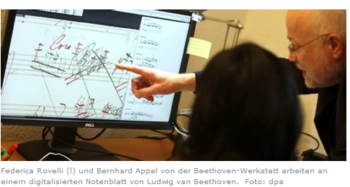
The ambitious Beethovens Werkstatt project, officially launched in 2014, will between now and 2030 reconstruct (with images and critical notes) the path of development of Beethoven's works from inception to completion. This project is based on the composer's sketch books, which in the digital version are to be carefully annotated with the help of the Music Encoding Initiative [MEI], a markup language for the encoding of musical sources facilitating their citation in critical editions. Bernhard Apel (Beethoven-Haus, Bonn) and Joachim Veit (Musikwissenschaftliches Institut, Detmold/Padlerborn) are the project directors. Johannes Kepper (Edirom project) is centrally involved in the technical development of both Werkstatt and MEI. The link above shows a prototype browser for viewing both manuscript iterations and modern notation for variants in the first movement of Beethoven's C-Minor Piano Sonata Op. 111 in Variants 14–17 (Beethoven-Haus BH 71).
Johannes Brahms Institute
Website: http://www.brahms-institut.de/web/bihl_digital/autographe.html
The Brahms Institute in Lübeck hosts a composite site for autographs, early editions, letters, and other kinds of documentation associated with Brahms. In this last category are such things as concert programs and fragments of music, drawings, and photographs of and by his associates.
See also the Johannes Brahms organization site.
Web Archive Anton Bruckner
Website: http://www.bruckner-online.at
The multi-faceted Anton Brucker web archive at the Austrian Academy of Sciences contains 26,000 images of the composer's autographs and early copies plus 6000 images of early prints. An associated database cites c. 10,000 works and related literature. The project is managed by Robert Klugseder. Online editions prepared with Edirom are in preparation.
John Cage Living Archive
Website: http://exhibitions.nypl.org/johncage/manuscripts
The New York Public Library for the Performing Arts, in collaboration with the John Cage Trust and the publisher C. F. Peters, hosts this sampler of Cage's physically diverse manuscripts. At a glance the reader can see the broad diversity of Cage's approaches--arithmetical, schematic, electronic, and aleatoric. A search engine has filters for video, manuscript, and ephemeral material. Video contributions of performances of Cage's music are actively sought via this form.
The Aaron Copland Collection (Library of Congress)
Website: http://www.loc.gov/collection/aaron-copland/about-this-collection
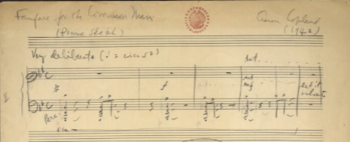
The Aaron Copland Collection, available at the Library of Congress, is an exceedingly rich one that contains every imaginable kind of evidence of the composer's long life (1900–1990)—manuscripts, sketches, typescripts for talks, personal photographs (roughly 5,000 of them), childhood mementos, and letters. Apart from photos, 981 other items can be found here.
Materials pertaining to Edvard Grieg
Website: http://bergenbibliotek.no/digitale-samlinger/grieg/english
Shortly before his death Edvard Grieg (1843-1907) arranged for the donation of all his music, letters, and related materials to the Bergen Public Library. The origins of the digitization project date back to 1993, the 150th anniversary of Grieg's birth. Grieg had a deep interest in recording technologies of his time. Starting in 1903 he made nine recordings of his music (on 78s), player-piano rolls from live-performance (Ludwig Hupfeld's Phonola and Welte-Mignon), and the Aeolian Company. For the last he suggested tempo mappings.
Handel's Messiah and other virtual "page-turners" from the British Library
Websites: See below.
The British Library's Virtual Books website contains a number of important manuscripts, the folios of which can be "turned" by the user. In addition to the autograph score of Handel's Messiah, "Sumer is icumen in", the Old Hall manuscript, the manuscript for Book II of J. S. Bach's Well Tempered Clavier, a Purcell anthem for the coronation (1685) of James II, sketches for Beethoven's Sixth ("Pastoral") Symphony, Elgar's "Enigma" Variations, and Mozart's musical diary (Zweig MS 63) are set up in similar fashion. A listing of other viewable musical works can be found here.
Handel autographs and other music manuscripts
The British Library completed the digitization of 38 Handel autograph manuscripts in 2016. They are accessed through the Library's "catalogs, archives, and manuscripts" website, where the user may limit the date range (slider at the bottom of the form). An author search for "Handel autographs" (currently yielding 168 hits) picks up unrelated miscellany, while a search for Handel alone produces a list of 103 titles. Items listed range from definitive scores of myriad operas, oratorios, cantatas, and other vocal and choral works to miscellaneous pieces (especially arias) collected by John Christopher Smith, Handel's copyist.
Among other composers represented, we find 311 manuscripts associated with the Bach family (52). Searches for other composers yield these figures: Thomas Arne (57), Giovanni Bononcini (58), William Boyce (115), William Byrd (141), Joseph Haydn (239), Orlando de Lassus (48), Benedetto Marcello (52), Wolfgang Amadeus Mozart (297), Pierluigi Palestrina (99), Giovanni Paisiello (84), Henry Purcell (233), and Alessandro Scarlatti (84), Franz Schubert (95), and William Walton (374).
The Handel autographs all have live links (2016), while many other listings currently contain catalog information. Holdings responding to composer searches may also yield correspondence, deeds, and other personal papers.
Michael Haydn Manuscripts
Website: http://daten.digitale-sammlungen.de/~db/ausgaben/uni_ausgabe.html?projekt=1384445203
181 comprehensive titles from the Bavarian State Library. The heavy emphasis on liturgical music reflects Haydn's lifetime involvement in church music, mainly in Salzburg and Vienna.
Gustav Mahler Autograph Manuscripts
Website: http://daten.digitale-sammlungen.de/~db/ausgaben/uni_ausgabe.html?projekt=1384445807
30 volumes of autograph manuscripts by Gustav Mahler are housed in the Bavarian State Library (Munich). Offerings include Das Knaben Wunderhorn, sketches for three symphonies, and Mahler's correspondence with Emil Hertzka.
Felix Mendelssohn Materials (Library of Congress)
Website: http://www.loc.gov/collections/felix-mendelssohn
The Library of Congress holds a collection of miscellaneous Mendelssohn memorabilia that includes letters, lithographs, printed, and manuscript music. The illustration here shows a watercolor of the Gewandhaus, Leipzig, by Mendelssohn from the scrapbook of Henriette Grabau, a singer who appeared there when Mendelssohn conducted in 1836. The musical except beneath it comes from the Cherubini's opera Ali Baba. Manuscripts of the Lieder ohne Wörte and the Octet, as well as drawings from his travels in Italy, are among the holdings.
Carl Orff Autograph Manuscripts
Website: http://daten.digitale-sammlungen.de/~db/ausgaben/uni_ausgabe.html?projekt=1384446061&l=de
This collection of manuscript materials (91 titles) documents the musical career of Carl Orff (1895–1982). It includes, Lieder, stage works, modern arrangements of Monteverdi operas, and other materials. Because of continuing copyright restrictions, many items can be consulted only on site in the Bavarian State Library. Nonetheless the detailed listing is valuable in documenting the range of Orff's interests and activities.
Max Reger Autograph Manuscripts
Website: http://daten.digitale-sammlungen.de/~db/ausgaben/uni_ausgabe.html?projekt=1384445879&l=de
The music of Max Reger (1873–1916) occupies a unique place in the keyboard repertory of its time. His organ works are better known than his other music—concertos, Lieder, choral works, and a clarinet quintet. Forty titles are viewable here.
Cipriano de Rore: Illuminated Choirbook from the Court of Albrecht V
Website: http://daten.digitale-sammlungen.de/~db/0010/bsb00103729/images/index.html
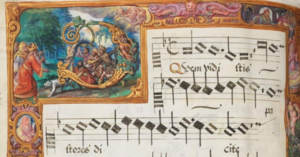
The brilliant colors and generous proportions of this choirbook, illuminated by Hans Mielich (1516-1573) for the Court of Albrecht V of Bavaria are stunning to behold. It is dated 1559. The books includes portraits of the duke, Duchess Anna, and of the composer. Rore (c. 1515-1565) was mainly active in Italy. He moved to Munich from Ferrara in the summer of 1559, which suggests that the bulk of the motets found here were composed prior to his arrival. Two volumes of his motets had been published in Venice in the 1540s. A further one followed in 1563.
The Arnold Schönberg Center
Website: http://www.schoenberg.at/index.php/en
The Arnold Schönberg Center in Vienna holds a cornucopia of Schönberg memorabilia that extends to film footage of the composer's real-world experiences such as being briefly employed as an auto salesman, his "contacts" list, and personal photographs, provides an online list of works, biographical sources, and information on performing rites. Autograph fair copies, sketches and drafts of Schönberg's compositions; autograph manuscripts and other primary sources for Schönberg’s theoretical writings and literary works; writings on musical pedagogy, as well as lectures and teaching materials; early printed copies of Schönberg’s works, including autograph annotations, performance instructions, and revisions; personal documents; Schönberg’s complete library; programs, reviews, posters; photographs and audiovisual documents all form part of the collection.
Schubert Online
Website: http://www.schubert-online.at
Schubert Online offers combined access to a total of 636 autograph scores, letters, and other documentation on Schubert. Much of the work was facilitated by the Vienna Science and Technology Fund [WWTF or Wiener Wissenschafts-, Forschungs- und Technologiefonds]. Digitized holdings come from Vienna's City Hall [Rathaus], the Austrian National Library, the State Library of Berlin, and the National Library of Norway, with intellectual contributions from the Music and Psychology program in Cologne and the Musicology Institute at the University of Vienna. Full-text search is supported for the letters. Deutsch Numbers are used to identify the manuscripts.
Strauss Online
Website: http://www.digital.wienbibliothek.at/nav/classification/301934
The music of three Johanns (father, son, uncle), one Josef, and one Eduard is represented at this website based at the city library of Vienna. More than 300 works are available here. Almost 200 of them are by Johann Strauss the younger, the waltz king. A few sketches, operettas, marches et al. are included. The minor Strausses composed polkas as well as other short instrumental pieces. Eduard's Theorie der Musik from c. 1845-50 can be downloaded here. An online catalogue of the library's printed works is available here.
Richard Strauss: Musical Autographs
Website: http://daten.digitale-sammlungen.de/~db/ausgaben/uni_ausgabe.html?projekt=1384446235
Among these 84 titles are numerous sketches, fragmentary compositions, and Lieder. The originals are held in the Bavarian State Library.
Verdi Online
Website: http://www.verdi.san.beniculturali.it/verdi/?lang=it
The Verdi Online collaboration hosts diverse materials--libretti, letters, portraits and figurines, bibliography, discography, and large quantites of background information about places and people associated with Giuseppe Verdi.
Georg Josef Vogler Music Manuscripts
Abbe Vogler (1749–1814) left a substantial collection of manuscripts (75 titles) that includes chamber and sacred music, concertos and symphonies, plus several items that relate to his opera Castor et Pollux.
Richard Wagner: Notebooks, music manuscripts, and correspondence
This collection of unpublished materials from the archive of the Bavarian State Opera brings Wagner's goals and working habits into our midst. Under 170 rubrics it documents the composer's movements, collaborators, and evolving ideas about music and role of music in society. They also give a more rounded view of his range of interests than many published accounts.
Robert Ward Papers
Website: https://archives.lib.duke.edu/catalog/wardrobert
Robert Ward was an American composer primarily of operas, instrumental works, and symphonic choral works. He won the 1962 Pulitzer Prize in Music for his opera, The Crucible, which remains his best-known work. His exceptionally long life (1910-2012) enabled him to compose for 95 years! Ward studied at the Eastman School of Music in the 1930s and subsequently taught at Columbia University, North arolina School of the Arts, and Duke University.
Manuscripts of Ermanno Wolf-Ferrari
Website: http://daten.digitale-sammlungen.de/~db/ausgaben/uni_ausgabe.html?projekt=1384446335&l=de
Ermanno Wolf-Ferrari (1876–1948) followed the path of aspiring students of his time in examining the details of earlier composers' practices. This collection of his manuscripts (175 titles) includes transcriptions of keyboard works by J. S. Bach, sketches of operas, concertos, symphonies, comic operas, a passion, sonatas, string quartets, and other chamber music.
By Collection
Corpus Musicae Ottomanicae (CMO)
Website: https://www.uni-muenster.de/CMO-Edition/cmo/cmo.html
This recently announced project (2020) to digitize and transcribe manuscripts of Middle Eastern Music, named the Corpus Musicae Ottomanicae (CMO), concentrates on musical materials originating in the Middle East in the seventeenth through nineteenth centuries. A digital critical edition based on the collection is being prepared under the auspices of the Institute for Arabic and Islamic Studies at the Westphalian University in Münster, DE. Detailing of musical performance practices is an intended area of focus. ʿAlī Ufuḳī, sold to the sultan's court in Istanbul as a slave in the seventeenth century, was a rapt student of culture who gathered vast quantities of information about language and customs during his many years at court. He transliterated texts and notated melodies provide offer glimpses of style ad substance that are rare, for in general music was not notated. Custom required the music to be read from right to left.
Digital Collections in the Berlin State Library
Website: http://digital.staatsbibliothek-berlin.de/suche/?DC=musik
The 7,348 digitized music items at the Berlin State Library website include manuscripts, prints, libretti, poetic texts for Lieder, and much else. Of interest to Beethoven scholars are the composer's conversation books (1820, 1825, 1826). Other offerings include writings by and about https://en.wikipedia.org/wiki/Richard_Wagner Richard Wagner}; music in manuscript by Franz Liszt; letters to Clara Schumann by Johannes Brahms (and many others); prints, manuscript, and letters by Felix Mendelssohn; and copious amounts of eighteenth-century music, some of it in nineteenth-century manuscript copies.
Digitized Manuscripts in the University and Regional Library Darmstadt
Among the 2,909 music manuscripts in the music section of this heterogeneous collection, those of Christoph Graupner play a major role. (See the Graupner entry under Thematic Catalogues.) Most of the items come from the long eighteenth century, when they sustained the life of the court and the city. Other composers of note include Attilio Ariosti, Jo. Chr. Bach, Georg Benda, Jo. Friedrich Fasch, Jo. Gottlied Graun, Jo. David Heinichen, G. Ph. Telemann, Abbé G. J. Vogler, and several nineteenth-century masters.
Rare Music Manuscripts in the British Library
Website: http://www.bl.uk/onlinegallery/onlineex/musicmanu
See the Old Hall manuscript, Purcell's coronation anthem for James II, an excerpt from Handel's Messiah, Bach's autograph for Book Two of the Well-Tempered Clavier, Mozart's thematic catalogue of his composition, Beethoven's sketches for the Sixth Symphony ("Pastoral"), and much else. (Music manscripts make up just one part of the holdings viewable at this portal.)
E-codices: The Virtual Manuscript Library of Switzerland
Website: http://www.e-codices.unifr.ch/en
In many ways e-codices, the Virtual Manuscript Library of Switzerland, is an unsurpassed example of maximal access to fundamental but rarely seen sources. Currently serving almost 1,400 parchments and manuscripts, its online existence began in 2007. Its value to musicology owes partly to a tight coupling between early histories of music and the sources on which these accounts were often based. The digital apparatus is very clearly articulated, and it search by many rubrics is possible. Access to color images of the materials long known only from running-text summaries of them enables users to pose new questions of interpretation. Users can construct new juxtapositions and concatenations of source details in relationships that could not previously be explored. An annotation tool enables users to highlight pertinent findings. e-codices is based on like-named software, which holds the distinction of running equally well on mobile and non-mobile platforms. An author list is available here.
Among its many riches to be found are these rare items:
- Writings of Hucbaldus (840–930) from the Benedictine abbey at Einsiedeln.
- The Ars contrapunctus of Philippe de Vitry (1291–1361) from the Benedictine abbey at Einsiedeln.
- Fragment (in Latin) of a writing by Moses Maimonides (1135–1204).
Recent software enhancements and links for the e-codices newsletter are available. A tablet viewer also exists.
Early Keyboard Manuscripts at Yale University
The Beinecke Library at Yale University holds substantial collections of music manuscripts, not all of it digitized to date. Highlights include not only notebooks for members of the Bach family but also chorale settings, manuscripts by Alessandro Scarlatti, seventeenth-century English music for instrumental ensembles, and transcriptions by Ezra Pound. The Orbis catalogue linked includes a wide range of items.
Fragmentarium
Website: https://fragmentarium.ms
Fragmentarium is not so much a single project as a global effort in digital restoration to locate, identify, and, where possible enhance nominally lost fragments of medieval manuscripts. The material is not exclusively musical, but since music was an adjunct to medieval manuscripts, Fragmentarium's availability to music scholars is an important resource. Fragmentarium is based at the Universiuty of Fribourg (CH) and is directed by Christoph Früeler. As of May 2022 it included nearly 3,000 items.
Gaffurius Codices Online
Website: https://www.gaffurius-codices.ch/s/portal/page/home
Franchinus Gaffurius (1451–1522) was a noted music theorist whose compositions, largely associated with his tenure as maestro di cappella at the Milan Cathedral, are little known. The Gaffurius Codices Online is devoted to inventorying the four Libroni containing the sacred vocal music he composed at this time, which coincided with the peak of Milan's Sforza rulers. (Leonardo da Vinci enjoyed a great deal of patronage from the Sforza family.) Gaffurius was a near contemporary of Josquin des Prez. The chief focus of this project is on the motets contained in the four large volumes. The contents will be captured in IIIF images suitable for sophisticated uses in a digital environment. A database containing important metadata will be developed in conjunction with the imaging. A digital critical edition is intended at a later time. the Gaffurius project is being developed by the Schola Cantorum Basiliensis in conjunction with the Swiss National Science Foundation.
Handrit: Historical (Music) Manuscripts from Iceland
Website: http://handrit.is/en/Handrit
This collection from the National and University Library, Reykjavik, contains historical manuscripts from Iceland. To find music, select Browse, Keywords, Arts, Music. Sources range from the 15th through 19th centuries.
Integrated Database for Early Music (IDEM)
Website: http://www.idemdatabase.org/alamire
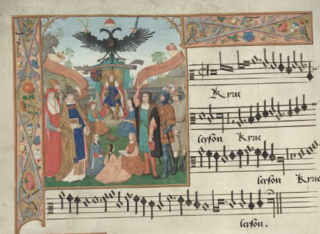
The Integrated Database for Early Music (IDEM), seated in the Musicology Research Unit (Katholieke Universiteit, Leuven), is an interdisciplinary, multifaceted database of manuscripts and printed books. Under the auspices of the Alamire Foundation, an international center for the study of music in the Low Countries, IDEM focuses on the musical heritage of these countries from the early Middle Ages until 1800.
The IDEM collection of digital images is coordinated with a central database of primary sources. Images are digitized by the Alamire Digital Lab, which provides high-technology photography at its Centre in Leuven, where state-of-the-art equipment allows musical sources to be photographed following strict quality requirements.
The Juilliard Manuscript Collection
Website: http://juilliardmanuscriptcollection.org/composers
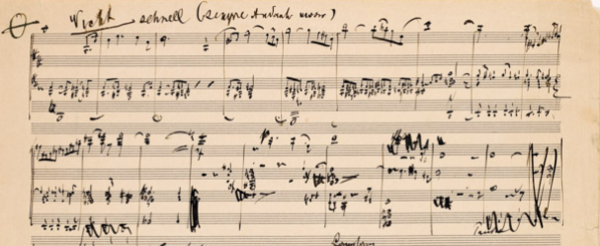
Among its 221 music manuscripts posted online, the Juilliard School possesses many unexpected items and substantial coverage of twentieth-century British and American composers (Samuel Barber, Frank Bridge) and many European composers whose music was popular in the US. Other collections represented at Juilliard include the collections of pianist Arthur Rubinstein and the popular composer of musicals Meredith Wilson (1902–1984).
Music Gifts for the Russian Emperors
Website: http://expositions.nlr.ru/MusicalManuscripts/eng/project.php
The National Library of Russia has made available this carefully curated collection of music given to Romanov emperors by visitors from France, Italy, Germany, and elsewhere. Many holdings come from Russia, where Western European music was introduced early in the eighteenth century. Holdings come from the 18th–20th centuries. Some of the music was brought by foreign teachers (e.g., Vincenzo Manfredini) for the royal progeny. Many works were provided with dedications to the emperors. Czech and Austrian music flowed copiously into Moscow at the end of the eighteenth century. A "Festival Song" by Felix Mendelssohn has a particularly interesting history, which is related here. The digitized pieces are linked to a database containing information about the social context and pertinent musical detail. The list of manuscripts (using Cyrillic script) can be found here, while a search engine (Roman script) is here. Drop-down lists contain listing in both Cyrillic and Roman, as appropriate, while the popup keyboard facilitates Cyrillic input. Source descriptions are in Russian.
Music Manuscripts in the Bavarian State Library
This rich collection of 2,697 digitized manuscripts is well endowed with music of the eighteenth and nineteenth centuries. Sample holdings include Alessandro Scarlatti's Missa Clementina, Antonio Caldara's sacred cantata "Gesu Cristo condannato", sacred vocal music by Michael Haydn, Handel's Deidamia, works by Karl Ditters von Dittersdorf, Dallapiccola, stage works by Richard Strauss, manuscripts of Carl Orff, and much other music.
The Moldenhauer Archives (Contemporary Music in Manuscript)
Website: http://memory.loc.gov/ammem/collections/moldenhauer/index.html
The Moldenhauer Archives began with the focus of teaching music history through primary sources. Its founder was Hans Moldenhauer (1906-1987) made the collection a memorial after his wife, Rosaleen, and donated it to the Library of Congress and eight other libraries including the Paul Sacher Stiftung (Basel), others in Cambridge MA, Evanston IL, Munich, Vienna, Zurich, and two in the state of Washington with which the Moldenhauers had personal connections--Washington State University and Whitworth College in Spokane. Its 3,500 manuscripts and letters, while representing a history of music and musical notation from ancient to recent times, is particularly valuable for its autographs of the latter. An online guide documents its contents, in many cases with essays on individual holdings.
Music Manuscripts in the Marciana National Library (Venice)
Website: Internet Culturale: Music Manuscripts in the Marciana National Library
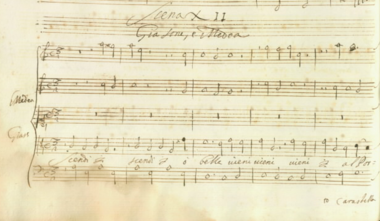
The Library of St. Mark (or Biblioteca Nazionale "Marciana") in Venice holds acquisitions that have been accumulating since the sixteenth century. Following guidelines widely shared across music libraries in Italy, it has digitized music manuscripts that are most closely tied to Venice's musical history. These include many important sources for seventeenth-century Venetian opera (Francesco Cavalli, Domenico Freschi, Giovanni Legrenzi, Carlo Pallavicino, P.A. and M.A. Ziani (operas can be accessed by act); 66 volumes containing cantatas of the eighteenth century by Benedetto Marcello (471 titles) and his nemesis Antonio Lotti; minuets by Baldassare Galuppi; and all the keyboard sonatas of Domenico Scarlatti (358 titles).
Music Manuscripts Online
Website: http://www.themorgan.org/music
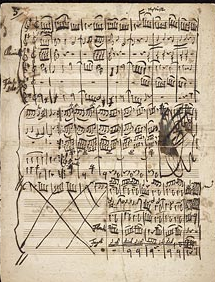
This collection of more than 700 manuscripts at the Morgan Library (New York) comes chiefly from eighteenth- to early twentieth-century composers (including but not limited to J. S. Bach, Beethoven, Brahms, Cherubini, Chopin, Debussy, Fauré, Gershwin, Glinka, Gluck, Handel, Haydn, Herbert, Liszt, Mahler, Massenet, Mendelssohn, Meyerbeer, Mozart, Mussorgsky, Paër, Pergolesi, Puccini, Saint-Saëns, Schubert, Schumann, and Wagner). An integrated browsing tool takes the viewer through music prints and manuscripts. The Library has recently made available its Goode EReader. Readers may now download images of manuscripts not currently under copyright. Searchable composer and manuscript lists facilitate individual searches.
Nuova Biblioteca Manoscritta (NBM)
Website: https://www.nuovabibliotecamanoscritta.it/catalogo.html
The Nuova Biblioteca Manoscritta (New Manuscript Library) is a regional resource for locating (and somertimes viewing) manuscripts from the modern Venetian state. It contains almost 30,000 items, but fewer than 500 of these contain music. Many other regional resources in Italy (e.g., Florence, Lombardy) and national catalogues are listed in online catalog of the Biblioteca Scuola Superiore Normale.
ORFEUS: The Post-Tridentine Music of Silence in the Cloister of S. Bento de Castris, Evora
Website: http://www.orfeus.pt
Thirteen choirbooks from the sixteenth to the eighteenth centuries in the monastery of S. Bento de Castris, Evora (Portugal), have been digitized by CIDEHUS, the Interdisciplinary Centre for History, Culture, and Societies. Luis Hennriques directs the project. The choirbooks are described individually here.
Music Treasures Consortium
Website: http://lcweb2.loc.gov/diglib/ihas/html/treasures/treasures-home.html
This aggregation includes both manuscript and out-of-copyright printed sources in more than a dozen institutions in the US, UK, and Germany. The browsing pages links users to the individual collections. The material is highly diverse but comes principally from the nineteenth century.
POLONA
Website: http://polona.pl
Polona presents the digital collections of the National Library of Poland. Digitized manuscripts and printed music are available. Registered website users can save materials to their own collections. Printed music can be found under Biblioteka, then Nuty. Manuscripts can be found under Biblioteka, then Rękopisy; from there, go to the filters and select Gatunek, then rękopisy muzyczne. Filters are available for authors, publishers, languages, form/genres, keywords, and century.
Saxon State Library (SLUB), Dresden: Royal Private Music Collection
This rich collection of the Wettin court, starting from the time of August the Strong and continuing to 1896, when it was donated to the Royal Library, is rich in holdings of sacred vocal music and Italian opera. Today it resides in the Saxon State and University Library (SLUB in the German ordering). The online holdings have been subdivided into these components:
The Opera Archive, which includes libretti, scores, and extracts, is currently being digitized. It overlaps the collaborative project Opera in Italy and Germany (1770-1830). This collection contains roughly 650 operas and opera extracts from the years 1764 to 1900. The private collections of court and church music include 750 manuscripts from the years 1697-1763.
Saxon State Library (SLUB): Court Music in Dresden
Website: http://hofmusik.slub-dresden.de
The current familiar name of this collection, Schrank II, is the name of the cabinet in which this important collection was long stored. It is a rich collection of instrumental music, mainly from the eighteenth century. Much of it is in the hand of Johann Georg Pisendel, an intrepid transcriber and collector of Italian (particularly Venetian) instrumental music. It contains 1,795 listings in 1750 physical manuscripts. By clicking on the highlighted text in the first sentence of the description users can download a spreadsheet with a full listing of holdings, most of which are digitized and are linked to the RISM OPAC.
Slovenian Digital Library
Website: http://www.dlib.si
The Digital Library of Slovenia includes in its Pictures section scans of music (and articles about music) published in Slovenia. Select notno gravido from the left frame on the Pictures tab. Dates of sheet-music publication range from 1862 to 1930, with a strong concentration in the late 1920s. Songbooks, especially from the first decade of the twentieth century, are also numerous.
Spanish Digital Library (Biblioteca Nacional Hispanica)
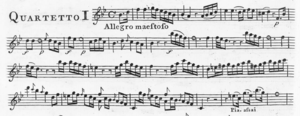
This heterogeneous collection of digitized materials--26,788 manuscripts and 4,347 printed sources--is impressive in its chronological and cultural range. Contains some eighteenth-century music for strings (Boccherini, Sacchini, et al.) and many sources from the late 19th and early 20th centuries.
By Repertory
Cambridge Lute Books
Website: http://cudl.lib.cam.ac.uk/view/MS-DD-00005-00078-00003/1
This link takes you to the second of four lute books compiled by Mathew Holmes and preserved in the Cambridge University Library. Its companions are the Cosens Lute Book and a volume of fragments of Elizabethan music for lute. Holmes was a singer at Christ Church, Oxford, and at Westminster Abbey. Cosens was a nineteenth-century owner of this collection of sixteenth-century music.
Cantigas Medievais Galego-Portuguesas
Website: http://cantigas.fcsh.unl.pt/manuscritos.asp
This website provides links to collections of manuscripts containing cantigas of Gallic and Portuguese origin. Many are preserved in the Vatican Library. The contents of each source is indexed, with full texts given in many cases. A sample folio is shown for each source. Titles are listed online.
Cantus Planus
Website: https://www.cantusplanus.at/de-at
In distinction to the Cantus Planus project focused on chant indexing (from the 1980s through today, under the auspices of the International Musicological Society), this website, operating under the auspices of the Austrian Academy of Sciences in Vienna, with a base at the Austrian National Library, provides a sophisticated array of digital tools and repositories for the study of medieval music. The scope of the project embraces six parts:
- Cantus Planus Austria: the primary web platform for the choral music in Austria
- Nationalbibliothek: Medieval music sources in the Austrian National Library
- Fragmente: Fragments of medieval music in the Austrian National Library
- Austriaca: Information on music manuscripts in Austrian libraries
- Text and Music Recognition: automatic recognition, transcription, and text acquisition of textual content in choral sourcces
- Bilddatenbank: an image bank of medieval music manuscripts.
Robert Klugseder directs the project.
Musica restaurata
Website: http://www.vaticanlibrary.va/home.php?pag=in_evidenza_art_00187
Illuminated manuscripts associated with the Low Countries in the Vatican Library can be viewed in high resolution owing to the generous support of the Alamire Foundation (Leuven, Belgium). The contents at the end of 2012 totaled 13,500 images. The image shown here comes from the workshop of Pierre Alamire (c. 1470–1536). Alamire's workshop produced many important manuscripts of the music of Johannes Ockeghem, Josquin des Prez, Adriano Willaert, and Pierre de la Rue. Alamire was a vendor of manuscripts who also used his innocent musical pursuits to conceal his operations as a spy for King Henry VIII. Manuscripts from his workshop can be found in several other European venues including Munich, Vienna, Brussels.
Polish Benedictine Music
Website: http://chrum.studiokropka.pl/st_test
This multifaceted project provides digitized images of sacred and liturgical music from Benedictine convents in the environs of Krakov. The musical sources are primarily from the 16th and 17th centuries. In addition to searchable digitized images, it also contains considerable metadata and many links to related resources as well as analytical information. An English translation is in progress.
Scottish Fiddle Tunes (Collections)
Website: http://hms.scot
More than 200 books of airs, reels, hornpipes, and strathspeys are reproduced at this website at the University of Glascow. Search by title, genre etc is facilitated in an associated databse. Some sources contain period annotations. The bulk are notated on two staves in the manner of keyboard music.
Swedish Musical Heritage
Website: http://www.swedishmusicalheritage.com
The Swedish Musical Heritage website represents an ongoing collaboration to make available all out-of-copyright music by Swedish composers. The alphabetical database of holdings is easily searched. It provides filters for instrumentation, composer's gender, century, and duration of each recording. Materials served include reproductions of scores, recordings of radio broadcasts, biographical information, and other related holdings of several musical institutions. Many Swedes were employed abroad, especially in Germany, and much foreign music found its way to Sweden via Germany.
Digitized Score Reprints
Out-of-copyright editions reproduced in their entirety. Grouped by composer, collection (i.e. within a library or a series), publisher and sheet music (subjects variable, usually from one institution).
By Composer
Ludwig van Beethovens Werke
The first collected edition of Beethoven's music was published by Breitkopf & Härtel, in Leipzig, between 1862 and 1888. This set contains 269 titles—symphonies, concertos, chamber music, Lieder, folksong arrangements, and much more.
Brahms Institute: Digital Archive
Website: http://www.brahms-institut.de/web/bihl_digital/archiv_index.html
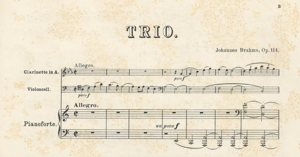
This website of the Brahms Institute in Lübeck (Germany) currently (2016) contains 42,000 images spreading across autograph manuscripts, early prints, photographs, concert programs, and personal documentation.
Chopin's First Editions Online (CFEO)
Website: http://www.cfeo.org.uk/about/description.html
This composite website, based at Royal Holloway College, London, serves more than 5,500 page images of early editions of Chopin's music. The project is headed by John Rink, with the collaboration of numerous holding institutions including the Bibliiothèque Nationale de France (Paris), the Bodleian Library (Oxford), the British Library (London), the University of Chicago, and the Chopin Institute (Warsaw). The separate listings below also function independently. The aim of the umbrella site is to facilitate close examination of sources in diverse collections and to coordinate early prints of Chopin's music with the Annotated Catalogue of Chopin's First Editions.
Jagiellonian Digital Library: Chopin holdings
Website: http://jbc.bj.uj.edu.pl/dlibra/collectiondescription?dirids=186
Featuring 17 volumes of Chopin's piano music at Jagiellonian Library in Kraków. The sites are under development.
University of Chicago: Chopin Early Editions
Website: http://chopin.lib.uchicago.edu
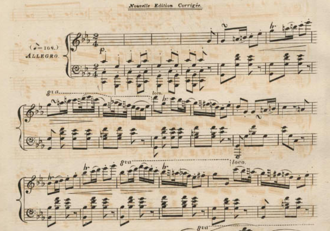
For an easy-to-consult listing of printed music by Chopin in the University of Chicago library, it is hard to surpass the Chopin Online Chopin Online Catalog. Citations are based on the library's shelfmarks, but since the music is digitized, users will have no difficulty in locating what they seek.
Online Chopin Variorum Editions (OCVE)
Website: http://www.ocve.org.uk/index.html
Not so much a single project as a whole constellation of Chopin-related research projects, John Rink's Chopin Variorum investigates such things as the work concept in Chopin's time and provides an annotated catalogue of first editions. Both are coordinated with The Complete Chopin: A New Critical Edition, printed in London (2004).
Georg Friedrich Händels Werke]
The Handel Gesellschaft edition of the composer's works (105 titles) was published by Breitkopf & Härtel between 1885 and 1902. It contains all but a few of the major works known today, sometimes with variants of arias or choruses that were excluded in later editions. [For earlier sources see "Lully" below.]
Franz Liszt Musikalische Werke
Website: http://daten.digitale-sammlungen.de/~db/ausgaben/uni_ausgabe.html?projekt=1193812455
This collected edition of Franz Liszt's works (35 volumes) was published by Breitkopf & Härtel, Leipzig. Although the first volume appeared in 1870, the others appeared between 1900 and 1936. Symphonies, symphonic poems, works for piano and orchestra, Liszt's music criticism, and little-known arrangements are included. The picture at the left shows Liszt's residence from 1848 to 1861, while he was director of court music. Today the Liszt Haus serves as a museum.
Jean-Baptiste Lully Collection (University of North Texas)
Website: http://www.library.unt.edu/collections/music/lully
Twenty-six scores of Lully's best-known dramatic settings are preserved in the music collection of the University of North Texas (Denton TX). Together with arrangements and variants of works by Lully in the 182 holdings of the Virtual Rare Book Room a broad basis for study of Lully's milieu is available here. Dates of works in the broader collection extend to late in the nineteenth century. Among holdings that fall outside this description are a 1743 print of Handel's Alexander's Feast, the first printed edition (1767) of Handel's Messiah, the first version of George Grove's 4-volume Dictionary of Music and Musicians, London, 1879–90, and Girolamo Gigli's original libretto (1689) for an opera called La fede ne' tradimenti, which enjoyed many settings in Italy.
Felix Mendelssohn Bartoldys Werke
This collected edition (162 titles) of Mendelssohn's music was issued by Breitkopf & Härtel. String quartets, quintets, chamber music for clarinet and basset horn, piano trios, works for piano and cello, a fantasy on the Irish song "The last rose of summer" (Op. 15) and many other little-known pieces of chamber music can be found here together with more familiar fare.
Neue Mozart Ausgabe Online
Website: http://dme.mozarteum.at/DME/nma/start.php?l=4
A fully digitized version of the Neue Mozart Ausgabe has been available online since 2006. Series and volumes follow exactly the Bärenreiter print. All elements of the printed exemplars (table of contents, score, critical report) are present. Letters, documents, and libretti will be added by the Digital Mozart Edition at the Mozarteum, Salzburg, in cooperation with the Packard Humanities Institute. This is the only recent collected edition of the works by a major composer currently offered online.
Ignaz Pleyel Early Editions
Website: http://digital.lib.uiowa.edu/pleyel
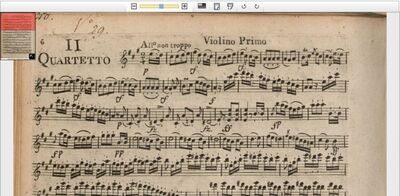
The late musicologist Rita Benton made an exhaustive study of Pleyel's editions (c. 1800) of the early string quartet literature. In the library named after her, more than 200 early editions and manuscripts give some sense of the scope of Pleyel's career as both a composer and a music publisher in the era of Haydn, Boccherini, and other notable composers of chamber music. In editions of chamber music for strings Pleyel also brought out piano pedagogy books and piano trios.
Franz Schuberts Werke
Website: http://daten.digitale-sammlungen.de/~db/ausgaben/uni_ausgabe.html?projekt=1259652551
The collected works of Franz Schubert, as published by Breitkopf & Härtel, Leipzig, 1884-1892. 53 volumes, including symphonic and piano works, choral works, theater pieces, piano four-hands arrangements, and song cycles.
Robert Schumann Werke
The works as edited by Clara Schumann and others. This series was published in Leipzig by Breitkoft & Härtrel between 1881 and 1893. The illustration shows the start of "Die Minnesänger" for four male voices, No. 2 from Schumann's Sechs Lieder.
Tomás Luis de Victoria
Website: http://www.tomasluisvictoria.es/en/content/center
The Centro d' Estusios Tomás Luis de Victoria (CEV) is a comprehensive one aimed at promoting greater familiarity with the music of the noted Spanish composer (1548-1611). To this end it offers a catalog and numerous reprints together with notices of events, podcasts, and a biography of the composer. Its website is optimized for mobile access (via smartphones and tablets).
The bibliographical apparatus is very clearly organized, and the CEV's integration of its diverse resources is a model of sensible organization. Since nearly all of Victoria's music is sacred vocal, the liturgical positioning of individual works is indicated. Links to texts, translations, and sources are fully covered. Some modern editions are credited to CPDL and IMSLP (in most cases relying on Pedrell's edition (Thomae Ludovici Victoria Abulensis Opera omnia), Leipzig 1902–13), while others are newly edited. It has links for discussion forums, facsimiles, monographs, and a discograhy.
Victoria entered musical life as a chorister in Ávila Cathedral, received his formal education and early professional experience in Rome, and upon his return to Spain (1577) entered the service of Dowager Empress Maria of Austria (daughter of Charles V, wife of Maximilian II, and mother of two other emperors) in Madrid. A priest, Victoria preferred convent life and declined several invitations to assume a more conspicuous post. His works consist mainly of masses (including parodies), motets (some sorrowful), Magnificats, Lamentations for Holy Week, and other species of liturgical music. Their performance attracted many listeners to the empress's convent.
By Collection
Monuments of German Music, Series 1
This 53-volume anthology of German music of the seventeenth and eighteenth centuries greatly increased familiarity with the music of Buxtehude, Telemann, J. Ch. F. Bach, Melchior Franck, Hasse, Scheidt, Stoltzer, and many others.
Monuments of German Music, Series 2 (Bavaria)
The second series of this well-known anthology, focused on Bavaria, emphasizes music associated with the Bavarian courts resident in Munich and (through composers such as Dell'Abaco) in exile in Brussels. Also represented are Stamitz, Haßler, Pachelbel, Pez, Steffani, Toeschi, and others. Published in 36 volumes (1901–1926).
Duben Collection Database Search
Website: http://www2.musik.uu.se/duben/Duben.php
The Düben Collection Database Catalogue is a digitised catalogue presenting meta-data and scanned facsimiles of the Düben Collection, a large and important collection of musical manuscripts and prints from the 17th and early 18th centuries. The compilation of the catalogue was initiated in 1987 and is a collaboration between Uppsala University and the University of Rochester.
Eastman School of Music/Sibley Music Library
Website: https://urresearch.rochester.edu/viewInstitutionalCollection.action?collectionId=63
The constantly growing digital collection of the Sibley School of Music is heterogeneous. It includes printed scores, manuscripts, and books—all of them in the public domain under U.S. copyright law. A large percentage of its holdings (currently 22,500 items) come from 19th- and early 20th-century America. Many items are unique.
Gaspari Online (Bologna Conservatory)
Website: http://www.bibliotecamusica.it/cmbm/tools/pro_dig.asp
The Gaspari Catalogue of holdings in the Bologna Conservatory is a resource well known to students of Italian music. It describes the heterogeneous holdings of what is now formally called the Museo Internazionale e Biblioteca della Musica di Bologna (the International Museum and Music Library of Bologna). Composed of multiple underlying libraries and collections, its holdings range from early liturgical sources to music of the twentieth century, from correspondence to musical instruments from earlier centuries to 4,000+ opera libretti (the Corago Project), most searchable from this start site. Under the same umbrella one can also find c. 400 portraits of musicians, mainly from nineteenth-century lithographs (as with Maria Malibran, shown at the right) and the voluminous eighteenth-century correspondence of Giambattista Martini, also edited in book form by Anne Schnoebelen.
Two collections--Corago (see under Libretti) and Ritratti di Musicisti (Musicians' Portraits: see under Image Banks/Iconoteca)--are listed separately.
Printed Music in the Bavarian State Library
This collection of 3,379 titles includes a large number of works from the eighteenth and early nineteenth centuries (Krebs, Türk, Danzi, Mendelssohn, and others). It also holds impressive early printed music, including Pierre Attaignant's seminal collection of Trente e six chansons musicales (1530), use of which is restricted to study. Clemens non Papa, Croce, Lassus, Rore, Vecchi, Wert, and Willaert are much in evidence, as are the publications of Pierre Phalèse the Elder.
Printed Music in the Prussian State Library
Among its treasures, the Prussian State Library in Berlin has recently uploaded (2016) 8,445 digital reprints covering a wide array of musical genres. Some obvious categories are music theory (including obscure tutors on harmony and counterpoint), folk music circulating in earlier centuries, musical dictionaries, comic operas, , hymns, psalm settings, spiritual songs, and a vast number of letters by composers. Our illustration shows one from Brahms, writing in Baden, to Clara Schumann, 15 August 1864. The exchange starts in 1855 and continues into the early 1890s. The date range is from the early sixteenth century to the early twentieth.
By Publisher
Nicolas Du Chemin: Chansons Nouvelles
Website: http://ricercar.cesr.univ-tours.fr/3-programmes/EMN/Duchemin/index.htm
Sixteen sets of books published by Parisian printer Nicolas Du Chemin between 1549 and 1568 are reproduced here in a collection that includes facsimiles, modern transcriptions, scholarly commentaries, and tools for research.
Sheet Music Collections and Miscellanies
University of Michigan list of sheet music collections
Website: http://guides.lib.umich.edu/c.php?g=282790&p=1884296
Sheet music denotes single pieces of music that were published prolifically in the US in parallel with the rise of the recording industry. Most items are for piano and voice, but popular songs were often transposed for several ranges. Many large collections survive in university libraries, and among them several are fully digitized. Redundancies in single-title listings are common, but in general each collection represents nearby publishers disproportionately.
The Sheet Music Cconsortium: A one-stop shop for cross-collection access
Website: http://digital2.library.ucla.edu/sheetmusic
This comprehensive search across many collections is made available by UCLA. The aggregate number of listings is truly staggering. Across 53 linked, indexed collections, we found close to 300,000 listings (April 2023). Most listed collections are in the US, but some inclusions come from the United Kingdom and Australia. This large aggregate corpus produces many redundancies, but sometimes the minute differences (or year, place, or cover art) are very informative. A search for Carrie Jacobs-Bond's "Perfect Day" produced almost 9,500 potential matches, with the earliest examples coming from 1910.
African American Sheet Music
Website: http://library.brown.edu/cds/sheetmusic/afam/index.html
The browsing facility for Brown University's online collection (1454 titles) is very easy to use. Some of the material (e.g. "Music Theater, 1865–1910) is also accessible at the Library of Congress "American Memory" website. Some uses are restricted.
American Sacred Music
This collection of digitized hymnals from the Mills College Music Library recalls the college's origins in 1851, on the heels of the California Gold Rush. The dates of the publications extend from 1833 to 1917.
American Vernacular Music Manuscripts
Website: https://archive.org/details/americanmusicmanuscripts
Murfreesboro, TN, the home of what is now called Middle Tennessee University, was a nexus of popular music-making before jazz established itself in Nashville. This collection of manuscript resources (c. 1730–1910) is full of miscellany but also offers documentation not available anywhere else. For most users the archive.org link given above will be more accessible than the university's Center for Popular Music server. To date 333 shelfmarks (many of them collections) have been uploaded. George Allen's "Reels, Clogs, Hornpipes, Jigs" is representative.
Archive of Popular American Music
Website: http://digital.library.ucla.edu/apam
UCLA's stupendous collection of popular music (450,000 items) is searchable by name, title, date, and cover art subject and several other categories of information. Covers only are scanned.
The Drs. Whitby Music Collection
Website: https://archive.org/details/whitbymusic?&sort=-downloads&page=3
This Canadian collection (1,339 items) at the University of Western Ontario (Waterloo) consists mainly of instrumental music from the nineteenth century. Titles in music theory and pedagogy are abundant. Some unusual anthologies including George Bickham's Musical Entertainer (1740), a collection of arias with obbligato flute parts, are found among its eighteenth-century holdings.
Historic American Sheet Music HASM (Duke University)
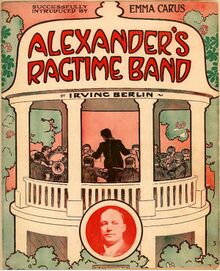
Website: http://library.duke.edu/digitalcollections/hasm
Duke University's Historic American Sheet Music collection (3,000+ titles) spans the time-period 1850–1920. It includes a song-lyrics index, has tabbed browsing, and provides helpful background on the sheet-music printing industry in the US. HASM is also linked to the Library of Congress's American Memory project. It has particular value for matching references in early film music, ragtime, and piano-rolls, that is for repertories that were known principally by ear. Searchable by subject, instrumentation, and illustrator as well as more usual parameters.
Irish Sheet Music Archives
Website: http://irishsheetmusicarchives.com/About-Us.htm
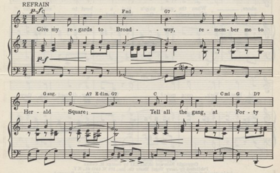
The Irish Sheet Music Archives website is the home of the online sheet music collections found in the Ward Irish Music Archives located in Milwaukee, Wisconsin. It enables searching, viewing, and in the majority of cases downloading its more than 5,000 scores of Irish and Irish-American sheet music. Those wishing to locate scores in the public domain (and therefore downloadable) are best off starting here, where the copyright status, instrumentation, and other details are clearly shown. Specialty subsections contain songs by George M. Cohan (1878-1942) and Harry Lauder (1870-1950), bagpipe pieces arranged for piano, and songs from the first world war.
Lester Levy Sheet Music Collection
Website: http://levysheetmusic.mse.jhu.edu
The Lester S. Levy Sheet Music Collection, based at Johns Hopkins University, contains 29,000 pieces (1780–1980). It is rich in popular music from the nineteenth century, particularly surrounding the years of military conflicts—the war of 1812, the Civil War (1861-65), and the First World War (1914–18). The collector wrote several books on specific subjects within the collection.
Lilly Library Sheet Music Collections
Website: http://www.indiana.edu/~liblilly/collections/sheetmusic.shtml

These collections at Indiana University are very large. Collectively they hold more than 275,000 pieces of American sheet music. Available materials can be searched with the In Harmony search page.
Music for the Nation: American Sheet Music 1870-1885
Website: http://www.loc.gov/collection/american-sheet-music-1870-to-1885/about-this-collection
This Library of Congress collection comes from copyright registrations. It is complemented by sheet-music repertories for the years 1820–1860 and the Civil War years that immediately followed.
Netherlands Radio Music Library
Website: http://www.muziekschatten.nl/action/category?id=1&order=composer&letterPage=v
This treasury of the Netherlands Radio Music Library in Hilversum contains nearly 5000 scores of classical, choral, light, and popular music (including manuscripts). Users can download and print PDF files from the Flash window. They are invited to upload their own sound recordings of the music they downloaded. Most "classical" works are by Dutch composers, and some are arrangements of scores originating elsewhere. Popular sheet music is chiefly from the late nineteenth and earlier twentieth centuries. Since the search pages are only in Dutch, a good starting point is the composer index.
Nineteenth-Century American Sheet Music (NcASM)
Website: http://www2.lib.unc.edu/dc/sheetmusic/index.html
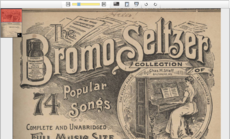
This University of North Carolina website holds almost 7500 digitized pieces from 1815 (music from the opera The Devil's Bridge to 1945 (an edition of Chopin's Polonaise Op. 53) as well as letters pertinent to holdings. The online catalogue search offers many options. Holdings include songs with piano accompaniment to duets, trios, and four-part glees.
Nineteenth-Century California Sheet Music
Website: http://people.ischool.berkeley.edu/~mkduggan/neh.html
The original holdings consisted of 2700 pieces published in California between 1852 and 1900. A further collection of 700 pieces was added in 2007. The project is maintained at the University of California, Berkeley. The pieces represent a wide range of Western US and native American traditions. Some sound, video, and MIDI files are also available.
St. Petersburg Score Collection
Website: http://www.jewishmusic-asjm.org/database-the-st-petersburg-score-collection.html
This collection located in St. Petersburg is maintained by the American Society for Jewish Music. Many published titles are in German and Russian. Publication took place in Kiev, New York, and several places between them.
University of North Carolina (UNC)
Website: https://archive.org/details/uncmus?&sort=-downloads&page=2
The UNC collection (3000+ items) represents categories of popular and religious music in use in the South Central US between 1880 and 1920. In addition, excerpts and short scores for operatic material and pedagogical material make up almost half the holdings. Robert Planquette's three-act comic opera Les Cloches de Corneville is currently the most viewed item. Beyond scans, this recourse offers 10 other download formats including epub, Kindle, Daisy (for print-disabled users), and many more.
University of Toronto Music Faculty Collection
Website: https://archive.org/details/facultyofmusic
The University of Toronto Music Faculty digitization project makes available more than 4,500 items reflecting, overall, the distribution of topical interests relating to music in Canada. The collection is evenly divided between sheet music and now-rare books. The pedagogical emphasis is pronounced. One of the most heavily used items is Theodore F. Freylinghuysen's Tonic Sol-Fa Music Reader (1890), published under his pseudonym Seward.
World War I Sheet Music
Website: http://www.loc.gov/collection/world-war-i-sheet-music/about-this-collection
This collection at the Library of Congress contains almost 14,000 items, all of which are fully digitized. The materials include not only conventional prints but also privately published and unpublished (amateur) material.
Yiddish Sheet Music
Website: http://library.brown.edu/cds/sheetmusic/yiddish/about.html
This special collection at Brown University contains roughly 2,000 items. Much of it represents the Yiddish-language musical stage in Russia around around 1900. Holdings include works by Bores Thomashefsky, the grandfather of Michael Tilson Thomas.
Repertory- and Genre-Based Digitization Projects
Repertory- and genre-based projects are difficult to classify. They may integrate highly diverse materials into the study of a single subject. Currently listed: digitized sources for chant, part- and choir-books, and opera.
Instrument-specific Collections
The International Harp Archives
Website: https://archive.org/details/byuinternationalharparchive
The International Harp Archives at Brigham Young University contains more than 3,000 items consisting of original works, arrangements, and ensemble music involving the harp. Some titles belong to classical pieces popular a century ago, pedagogical material, music from the British Commonwealth and the United Kingdom, and children's songs.
Liturgical Music
Global Chant Database: See Search Engines
Brazilian Sacred Music (Mariana Museum of Music)
Website: http://www.mmmariana.com.br/site
The multi-faceted website of the Mariana Museum of Music concentrates on three sacred repertories (music for Pentecost, Mass, and Holy Saturday)used in Brazil from colonial times into the twentieth century. Its heterogeneous holdings include printed scores, manuscripts, and recordings. Works are findable by many rubrics in the database section. Some explanatory information is available in Word and PDF formats here. As the online materials explain, much of the sacred music of earlier times has not been preserved because of signal historical events (e.g. the route of the Jesuit order in 1759, the vulgarization of mass texts by the Vatican II Council in the 1960s). A major part of the project involves restoration of poorly preserved materials.
Liber Usualis
Website: http://ddmal.music.mcgill.ca/liber/#p=1
The Liber Usualis is the practical guide to chants for the Christian liturgical year. Although often considered to be ancient, it was first published in its present form in the middle of the nineteenth century. Some further accretions have occurred in recent decades. The Liber contains two cycles for the Christian year: one for the Ordinary (feasts whose liturgical needs are held in common) and one for the Proper of the Saints (feasts that are individualized in their liturgical requirements). Texts (in Latin) and music were widely paraphrased in liturgical music of the Renaissance. This version is searchable.
The Sarum Rite
Website: http://hmcwordpress.mcmaster.ca/renwick/about
This multifaceted website developed by William Renwick under the aegis of the Gregorian Institute of Canada provides both academic and performing editions of texts and music associated with the Sarum Rite. Its contents have been collected from medieval manuscripts and numerous printed books of the 16th and early 17th centuries. (The Rite was replaced by the English Book of Common Prayer under Elizabeth I.) Texts in Latin are available in English translation. Sound files are linked to individual links in the index to each Office. Metadata associated with these materials is available at a separate site at McMaster University.
Sequentia
Website: http://sequentia.huma-num.fr
Sequentia is an online database of ecclesiastic chant during the early modern era (from the beginning of the Counter-Reformation until around 1840–1850). It involves scholars from three French research organizations and is steered by an international group of scholars. Sequentia offers a summary description of liturgical books and a thesaurus of liturgical feasts, but also some details that have not yet been developed in existing databases of liturgical chant. among its long-term aims is the full description of musical pieces contained in the sources, comprising text incipit, possible textual authorship, musical incipit or psalmodic formula, possible melodic authorship, mode and ambitus, possible author of the melody, location within the liturgy (feast, office, rubric), genre, and location within the source.
Drama (with music)
Records of Early English Drama (REED Online)
Website: https://ereed.library.utoronto.ca
REED Online represents the second phase of this venerable (ongoing) series of documents reporting performance-related details of acting (sometimes with music) in England, Wales, and Scotland. The project is based at the University of Toronto. The online version provides many search filters and default word searches operate in OR mode and support searches for multiple words given in parentheses. A clear, concise critical apparatus is provided. Some words pertaining to music have been "translated to modern English from archaic forms.
Part-books and Choir Books
Early Music (Anthologies) Online
These 327 printed anthologies, held in the British Library (London), were originally microfilmed for the RISM AI project. Because of its heavy coverage of sixteenth-century prints (a high proportion of which were anthologies), it contains many real treasures—large numbers of madrigals, much of the early printed music for lute, and numerous prints in which almost all the works are by an important composer (Buus, Croce, Rore, Willaert). Seventy-seven volumes contain chansons. A smattering of treatises, e.g. Girolamo Diruta's Il Transilvano, can also be found here.
Bologna Partbooks (secular music)
The holdings of the Museo internazionale e biblioteca della musica (formerly the Civico Museo Bibliografico Musicale) of Bologna are particularly rich in partbooks of the sixteenth and seventeenth centuries. Among the 339 prints found here (served by the same library but originating in the Dipartimento di Musica e Spettacolo of the University of Bologna) many secular items and some sacred vocal music can be found.
Chant and Polyphony at the Munich Digitization Center (MDZ)
Website: https://www.digitale-sammlungen.de/en/ Munich Digitiztion Center
A number of projects focused on specific kinds of music, chiefly from the later Middle Ages and the Renaissance, have been amalgamated with large quantities of non-musical material under the songle URL given here. Users equipped with specific references will be betterserved than those wishing to browse. Among the once separate projects are these:
- German chant and choir books emphasized south German liturgical resources from the fifteenth century.
- Munich Choir Books (mainly 16th century) was particularly strong in its holdings of music by
Lassus [1] the Bavarian court (Munich), which reached a peak of activity that resulted in the substantial repertory preserved in choir books. The layout of parts in a large-format choir book enables singers to see their parts while standing around the book. The 199 choir books in this digitized collection contain sacred (Isaac, Josquin, Senfl) and secular music as well as fragmentary works and an anonymous Tractatus de musica. Holdings from local monasteries and private collections have been included.
- Printed Sources of Polyphonic Music of the Sixteenth and Seventeenth Centuries contains printed (primarily vocal) music in the Bavarian State Library (with ttles in Latin, German, French, Italian, Spanish et al.). Under its earlier identity it contained 1371 publication titles including chansons, madrigals, psalms, masses, motets, hymns, sacred songs, and early instrumental music (sonatas, balletti et al.). Representative items are of foreign origin are Purcell's Orpheus Brittanicus (London, 1698) and Schmelzer's Arie per il balletto a cavallo (a horse ballet given for the wedding of emperor Leopold I and Princess Margherita of Spain, Vienna, 1667).
The Trent Codices (Fifteenth-Century Polyphony)
This important collection of anonymous music of the fifteenth century (Codici musicali Trentini del Quattrocento) is uniform in presentation, with most works employing a choir-book layout. Paper texture is well captured in the digitizations, which are highly consistent graphically. The number of titles is 1863. Few titles are attributed. Those that are come mainly from Guillaume Dufay (105 titles), Gilles Binchois (52), and John Dunstaple (30). The originals are preserved in the Castello di Buonconsiglio, Trent (IT).
Tudor Partbooks
Website: http://www.tudorpartbooks.ac.uk
This collaboration between the Universities of Oxford and Newcastle (funded by the UK Arts and Humanities Research Council) aims to restore and make available online all extant manuscripts of Tudor polyphonic music from c.1510-1590 preserved in partbook format. Its particular focus is on the manuscript copies (and their legacies) of John Sadler (1513-c. 1591/2), John Baldwin (1560-1615), and their predecessors. Researchers from Oxford (Kathryn Butler, Julia Craig-McFeely) and Newcastle (Magnus Williamson, Daisy Gibbs) will rely on contributions from volunteers to help develop the virtual resources. Technical challenges include Tudor reliance on high-acid inks and their detrimental effects on physical preservation of their copies. Digital tools are employed to restore lost elements of the physical sources. A principal [Christ Church Oxford] source of the Baldwin partbooks is described in DIAMM, with further details in the Christ Church overview. Music by William Byrd and Thomas Tallis figure prominently in the holdings. Sample modern editions made from the partbooks are available online.
Jazz
Jazzomat Research Project
Website: https://jazzomat.hfm-weimar.de
The Jazzomat project has aggregated several related projects to its website. The Weimar Jazz Database contains 476 transcriptions from jazz solos in recordings. The representation scheme takes account of many subtleties associated with jazz idioms (e.g. "median deviation of fundamental frequency from standard equal-tempered pitch"). Given this level of precision, characteristics unique to one artist should be identifiable. Broad characteristics (form of song, genre of solo) are also recorded. The underlying audio material is also provided with substantial metadata.
Jazzomat links with other resources where useful: MusicBrainz Identifier for track IDs, originating Sonic Visualizer file for melodic types, etc.
To study jazz in the context of other monophonic transcriptions, a searchable database combining materials from the EsAC and Pop libraries have been amalgamated with the Jazzomat transcriptions. For a sample of the possibilities created, please see "Parker's Pitch Patterns".
Opera
Early Nineteenth-Century Opera
Website: http://blogs.law.harvard.edu/loebmusic/2015/05/06/newly-digitized-early-19th-century-opera
This website in the Loeb Music Library at Harvard University features vocal scores mainly from Paris (Spontini, Auber, Rossini) and Neapolitan works by Donizetti.
Opera in Italy, Austria, and Germany (1770-1830)
Website: https://web.archive.org/web/20190403122127/http://www.oper-um-1800.uni-mainz.de/
Die Oper in Italien und Deutschland zwischen 1770 und 1830 (Opera in Italy and Germany between 1770 and 1830). This archived project (previously hosted at the University of Cologne) contained an array of resources for the study of operas that were contemporaneous with the life of Ludwig van Beethoven (1770–1827), who found his attempts to succeed in the world of opera frustrating. Prior to archiving, the archive accounted for 483 manuscripts, reproductions of printed libretti for every work listed, and an extensive metadata apparatus for basic information on composers, performances, and sources. the links are not currently operational. Wolf-Dieter (romance languages) and Wolfram Steinbeck (musicology) are the project leaders.
Other Genres and Traditions
American Vernacular Music Manuscripts (ca. 1730-1910)
Website: http://popmusic.mtsu.edu/ManuscriptMusic
This cooperative project representing digital collections from the American Antiquarian Society and the Center for Popular Music at Middle Tennessee State University holds much promise for mapping the past of American traditional music. Holdings range from shape-note tune books and devotional pieces to marches, music for figured dances, for circuses, for regimental corps, and for a wide range of utilitarian pieces penned by amateurs for an unknown occasion. Additionally, it holds many bound books of manuscripts prepared by teachers and pupils, in most cases for instruction to European settlers in nineteenth-century America.
Singing upon the Note (Early Music for Vocal Improvisation)
Website: https://contrapunto.ch
The flow of simply notated music (chant, patterned basses, folk tunes) at the dawn of the Renaissance gave rise to arts of improvisation. This resource offers short, notated pieces that formed the basis of endeavors to teach vocal improvisation.
Gospel Music History Archives
Website: http://digitallibrary.usc.edu/cdm/landingpage/collection/p15799coll9
This umbrella website at the University of Southern California aims at durable preservation of materials in fragile collections. Its contents come from the Gospel Music History Project, the Center for Religion and Civic Culture, the Archives of African American Music and Culture (Indiana University), and USC collections. Contributions are welcome.
Arthur Kleiner Collection of Silent Movie Music
Website: https://www.lib.umn.edu/scrbm/kleiner
The Arthur Kleiner Collection of Silent Movie Music at the University of Minnesota contains roughly 700 silent films. In 1939 Alfred Kleiner, an immigrant from Vienna, was named director of the New York Museum of Modern Art's film festival. After retirement (1967) he continued his work in Minnesota. Scores and recordings with expired copyrights are accessible online.
Lute Online Resources Portal (LORP)
Website: https://www.lutesociety.org/lute-portal/annotated-catalogue-of-historical-lute-manuscripts
LORP is a starting point for prints, manuscripts, and databases specific to music for lute, and in some cases also for guitar and vihuela. The search engine at Early Music Sources especially helpful.
Partitura organum
Website: http://partitura.org
Partitura organum shares contributed scores of organ music. Typesetting is unified in Lilypond and edited with Frescobaldi. PDFs and MP3 files are available for most works. Users may leave comments.
Renaissance Music in Croatia
Website: http://ricercar.cesr.univ-tours.fr/3-programmes/EMN/Croatie/index.htm
This collection, directed by Ennio Stipcevic, Philippe Vendrix, and Vasco Zara, is served under the auspices of the Ricercar project in Tours with the cooperation of the University of Zegreb. Music in manuscripts, prints, and other sources by Croatian composers are listed and offered in modern transcriptions. MIDI files accompany some entries. (Some included sources are held elsewhere.) The chanson is the genre that links the Croatian materials to the French materials, although the materials currently loaded favor madrigals. Some of the materials are sacred and/or instrumental music. A Roman missal (Venice, 1485-86) is also included.
Silent Film Scores and Arrangements (Library of Congress)
Website: https://www.loc.gov/collections/silent-film-scores-and-arrangements/about-this-collection
This Library of Congress Collection, assembled between 1904 and 1928, contains more than 3,000 items. Most come from sheet music publishers in the US and Europe, but some submissions came from individual seeking copyright protection. (The US Copyright Office is housed in the Library of Congress.) The attitude towards matching the music to the film is suggested by this note inside Vol. 1 of the Remick Collection (1914), "...over 100 dramatic, descriptive and characteristic numbers suitable for any theatrical performance or exhibition requiring incidental music."
The Spirituals Database
Website: http://www.spirituals-database.com
The searchable Spirituals Database provided searchable information on over 1,600 tracks from recordings of spirituals written for solo voice. It was developed and maintained by Randye Jones. Now under contract with a publisher, the online repertory has been replaced with an extensive video history of the genre.
Institutional Histories
Boston Handel and Haydn Society
Website: https://handelandhaydn.org/performance-database
This site represents a complete performance history of this venerable society. It also serves the continuing needs of the society, including ticket sales, videos of past performances, and background information. The historical repertory mentions items that no one would normally associate with a society of this nature including first US performances of European classics (Verdi's Requiem, Bach's B-Minor Mass). Digitized concert programs (1818-2016) can be found at this link.
Boston Symphony Orchestra Archives
Website: https://www.bso.org/brands/bso/about-us/historyarchives/archival-collection.aspx
This heterogeneous website covers the full apparatus of a well-known orchestra, including programs, photographs, specially commissioned works, premieres. The orchestra was established in 1881. The database can be searched by performance, artist, and repertory.
New York Philharmonic Leon Levy Digital Library
Website: http://archives.nyphil.org
A comprehensive site containing images, scores marked up by famous conductors, correspondence, concert programs, and much else. In addition to recreating much of the concert life of New York in the nineteenth and twentieth centuries, the archive provides open data access. Scholars are already digging into subscriber information of past decades.
Performance History
Stockhausen Concerts Database
Website: http://sbkw.net/gesang
Although the focus (1952-1972) is somewhat narrow, this website (in beta from 2015) shows the enormous interest in the music of Karl-Heinz Stockhausen (1928-2007) during those decades and where it was most popular. An early associate of the Darmstadt School, Stockhausen's musical interests ranged broadly and spread to vocal and electronic music in the 1960s. Links to complementary databases are planned.
Bio-bibliographical resources
Sorabji Resource Site
Website: http://www.mus.ulaval.ca/roberge/srs
This extensive repository of (often tabular) data on the life, music, and writings of the English composer, pianist, critic, and writer on music Kaikhosru Shapurji Sorabji (1892-1988) is maintained by Marc-André Roberge at the Université Laval Marc-André Roberge at the University Laval, Québec (CA).
Structured Databases
Most databases currently used are focused on a single subject. The methods by which they are structured is widely varied. Sites in which the material is predominantly textual are listed below. Text and image are integrated on some sites. Sites that focus on images with only sparse metadata are listed above. Among subjects listed here here: catalogues, inventories, and thematic indices; letters and treatises; instrument makers; ethnomusicological sources; and image archives.
Secular Vocal and Folksong Repertories
Bodleian Library Broadside Ballads Catalogue
Website: http://www.bodley.ox.ac.uk/ballads/project.htm
The Bodleian broadside ballads project, which was developed mainly from 1995 to 2000, spans the history of the genre. A search form enables users to access the allegro Catalogue of Ballads by sheet or ballad title, first line, and tune name as well as publisher, date, and other parameters.
Books of Hispanic Polyphony (BHP)
Website: https://hispanicpolyphony.eu
Books of Hispanic Polyphony IMF-CSIC (BHP), hosted in Barcelona by the Institució Milà i Fontanals of the Spanish National Research Council (IMF-CSIC), serves as a comprehensive research tool concerning manuscript and printed polyphony books in Spain and books elsewhere containing Hispanic polyphony. Its initial coverage is for the 15th-20th centuries, but it had no chronological imitations. BHP does not provide images of the sources, unless holding institutions provide them. In these cases BHP incorporates the appropriate links (e.g. to the Biblioteca Digital Hispánica, covering books at the Biblioteca Nacional de España in Madrid). BHP also incorporates links to descriptions of manuscripts in DIAMM, the Digital Image Archive of Medieval Music, to prints listed in Printed Sacred Music Database 1500-1800, to the Portuguese Early Music (PEM) database, and to other appropriate websites that could offer relevant information.
The main menu for “Sources” (1509 items), “Locations”, “Institutions” (392), “People” (1036), “Genres”, “Works” (4696), “Movements” (4750), “Documents” (96) and “Bibliography” (1034) gives a sense of the breadth of BHP; additional materials are continually being incorporated by the project’s team, directed by Emilio Ros-Fábregas; the webmaster is Jan Koláček.
César: French Theatrical Database
Website: https://cesar.huma-num.fr/cesar2
The Calendrier électronique des spectacles sour l'ancien régime et sous la révolution is a searchable database of personnel (broadly defined), titles, dates, venues, and pertinent treatises on the French theater of the seventeenth and eighteenth centuries. Among its most unusual holdings are its calendar of police reports from the revolutionary period. With over 400,000 items covering actors, playrights, venues, et al., CESAR covers the entire francophone world. This project was originated jointly at Oxford Brookes University by Barry Russell (1943-2003) and in Toronto by David Trott (1940-2005). It is now hosted at the l’Université Grenoble Alpes. A companion image bank currently draws on ten institutional collections.
Catalogue de la Chanson Française à la Renaissance (Chanson Database)
Website: http://ricercar.cesr.univ-tours.fr/3-programmes/basechanson
A search site with extensive metadata and musical incipits for a repertory of 10,000 works from the sixteenth century. Multiple settings of the same text have individual listings (e.g. "Susanne un jour" currently has 26 listings). Works can be searched by title, scoring, composer, source, location, and text. Instrumental arrangements of originally texted pieces are included. The site is cross-referenced to comprehensive secondary sources and modern editions. The project is directed by Annie Cœurdevey at Ricercar, the musicology research program of the Centre d'Études Supérieures de la Renaissance (CESR) at l'université François-Rabelais de Tours.
CLORI: Archive of the Italian Cantata
Website: http://www.cantataitaliana.it
CLORI, which hosts cantata texts, manuscript source citations, and images that show characteristics of handwriting, has a number of sponsors and collaborators including the Italian Musicological Society (SIdM in Italian), the University of Rome (Tor Vergata), the Italian Institute for Music History (IISM), and RISM. The project is headed by Teresa M. Gialdroni. Click the "ricerca" button to go to the search form.
Deutsches Volksliedarchiv (German Folksong Archive)
Website: http://www.dva.uni-freiburg.de/Deutsches_Volksliedarchiv
The German Folk Music Archive (in German) has evolved over a century (to 2014) as a central clearing house for folk songs from German-speaking lands. It contains several component parts including (1) a Lieder Lexicon in which folksong texts are listed alphabetically; (2) a listing of specific projects, mainly those with a critical dimension; and (3) a popular Song Lexicon.
Early American Sacred Music
Website: https://earlyamericansacredmusic.org
The focus of Early American Sacred Music is on choral music with sacred texts hand-copied or printed in America up to 1821. The European tradition is emphasized. Most of the sources are from New England. More than 300 secondary sources are represented. A number of historical archives and special collections within university archives are included.
EASMUS: Early American Secular Music and its European Sources
Website: http://www.colonialdancing.org/Easmes/Index.htm
This extensive canvas of secular music in the American colonies and early states (1589–1839) consists of a series of indices (titles, first lines, musical incipits [by scale degree], stressed notes, et al.). It was developed over the 1970s and 80s by Kate Van Winkle Keller, Robert Keller, Carolyn Rabson, Raoul F. Camus, and Susan Cifaldi. The contents include ballad operas, band music, song sheets, theater works, and the names of tunes played by musical clocks.
English Broadside Ballad Archive
Website: http://ebba.english.ucsb.edu
Six thousand English broadside ballads, mainly from the seventeenth century, are included in this comprehensive project extending to related artistic and cultural phenomena. It development continues through 2016.
HUAPALA: Hawaiian Lyrics and Hula Archives
Website: http://www.huapala.org
Under development since 1997, HUAPALA is a website consisting mainly of texts derived from recordings of Hawaiian traditional music. Its aim is to preserve the musical culture of the Hawaiian Islands through not only the lyrics but also associated artifacts. Some musical overlaps with Samoa and Tahiti allow for comparison of lyrics from the broader Polynesian world.
Loire Valley Chanson Sources
Website: http://www.goldbergstiftung.de/forum/index_de.php?a=forum&f=39
The Goldberg Foundation has set up a system of hyperlinks to digitized resources for this subsector of the chanson repertory. As a collaborative project, it is somewhat uneven in its offerings. In compensation, comments can be appended to listings.
Old English Songs
Website: http://athena.uky.edu/oes/intro.htm
This collection, housed at the University of Kentucky, was once owned by the double-bass player Domenico Dragonetti. The contents mainly consist of opera arias (Handel, Bononcini, Purcell) and cantatas (rather than folksongs or sea shanties) in scanned images.
Fondo de Música Tradicional (Traditional Music of Spain)
Website: http://musicatradicional.eu
The Fondo de Música Tradicional, hosted by the Institució Milá i Fontanals (IMF-CSIC) in Barcelona, includes more than 20,000 melodic transcriptions collected between 1944 and 1960 from regional oral traditions throughout Spain. Most music in the database [most in hand transcriptions, with a diatonic numerical encoding of the incipit] was compiled through efforts of the former Instituto Español de Musicología of CSIC. The website/database contains 10,000 unique pieces from more than 4,500 informants at 3,000 locations within Andalusia, the Balearic Islands, Castile-La Mancha, Castile and León Region, Catalonia, Extremadura, Galicia, Murcia Region and the Valencian community. The collection also includes old video and audio recordings. Additional materials are continually being incorporated by the project's team, directed by Emilio Ros-Fábregas. Independent musicians are invited to contribute their own materials.
VolksLiedWerke (Austrian Folksong Database)
Website: http://www.volksmusikdatenbank.at
The VolksLiedWerke is assembled from collections originating in Austria's states. Searches by title, personal name, or corporate name are possible. Supported by the Austrian National Library (Oesterreichische Nationalbibliothek) and other entities. Some regions have separate websites, such as this one for the Tyrol, where scores and recordings may also be found. Interface available in five languages.
Sacred and Liturgical Music
Antiphonale Synopticum
Website: http://gregorianik.uni-regensburg.de
The Antiphonale Synopticum project (currently in German only) is the most recent addition to the Cantus Index Network–a series of connected, online projects employing the same structure and methodology. Based at the Universität Regensburg, it is directed by Harald Buchinger. It seeks to support identification of textual and melodic variants. Antiphonale Synopticum and its networked partners operate under the guidelines of the Cantus Planus Study Group of the International Musicological Society, which include the free and open exchange of data in electronic form.
CANTUS Manuscript Database: A Database for Latin Ecclesiastical Chant
Website: http://cantus.uwaterlook.ca
Cantus is a large, steadily-growing resource containing inventories of medieval chant manuscripts and related analytical tools. Its original home was the Catholic University of America (Washington, DC) under Ruth Steiner. After a period at the University of Western Ontario (London) under Terence Bailey, the database was moved to the University of Waterloo where Debra Lacoste is the current project manager and Jan Koláček (Prague) is its web developer. It has recently expanded from inventories of antiphoners and breviaries to manuscript sources containing Mass chants, including sequences. By providing a searchable database of detailed information for (currently) over 160 medieval manuscripts and over 440,00 chants, the Cantus Manuscript Database is a useful digital archive for musicologists and other academic researchers, librarians, archivists, as well as performers of this early music. Users can search for chants by text, saints’ name or liturgical occasion, and Cantus ID number. Tools for browsing, analysis, and data-entry are provided. An introduction to the database can be found in a YouTube video by Lacoste (2014). The Cantus Manuscript Database is the flagship site in the Cantus Index Network–a series of connected, online projects employing the same structure and methodology. The Cantus Manuscript Database, Cantus Index, and its networked partners operate under the guidelines of the Cantus Planus Study Group of the International Musicological Society, which include the free and open exchange of data in electronic form.
Cantus Fractus Database (Projetto Raphael)
Website: http://www.cantusfractus.org
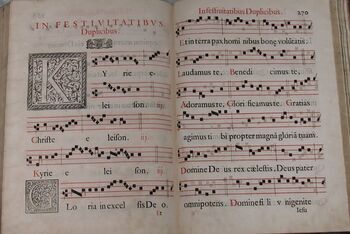
An abiding problem in chant research is the evaluation of rhythm and proportion. This website (in Italian) by Marco Gozzi explores interpretative methods for repertories that are viewable online in early prints and manuscripts. A search form facilitates the retrieval of examples by source location. Excellent leaf-by-leaf viewing tools are provided.
Cantus Planus Austria
Website: https://cantusplanus.at
Cantus Planus Austria is a significant constellation of resources including many digitized manuscripts of medieval chant, choir books, databases, and other materials related to church music of earlier times. Many of the sources are preserved in the Austrian National Library.
Cantus Planus Regensburg
Website: http://www-musikwissenschaft.uni-r.de/cantus
Cantus Planus Regensburg is a long-established web archive for medieval chant research. It includes downloadable data files and various databases, e.g. Post-Easter and Pentecost Alleluias, Responsories of the Dead (Ottosen), Advent Responsories (Hesbert), Medieval liturgical manuscripts in German and British libraries, and other pertinent tools such as David Hiley’s (et al) very useful medieval chant bibliographies. The project is directed by David Hiley and Robert Klugseder.
Cantus Ultimus
Website: https://cantus.simssa.ca/manuscripts/
Cantus Ultimus is a database of manuscript sources of digitized chants. Sources and their contents have been signaled by a network of chant researchers in Canada, the U.S., the U.K., and Europe. The database supports text searches by title, mode, feast, liturgical function, and folio number with each source.
ChantDigger
Website: http://www.oralhistoryofchant.ch/index.php/en/guided-tour
(Not currently maintained). The online implementation of Max Haas's lengthy investigation of chant variants is recent. After loading the data one can search either by text or by melody. A "canvas" offers a graph to map chant movement.
Comparatio (Chant Comparison)
Website: http://comparatio.irht.cnrs.fr
Comparatio, a member of the Cantus Index Network, presents transcriptions of selected chants in side-by-side views to facilitate the identification of liturgical traditions. It was developed at the Institut de recerche et d'histoire des textes (IRHT) of the Centre national de la recerche scientifique (CNRS) by Claire Maître. Comparatio and its networked partners operate under the guidelines of the Cantus Planus Study Group of the International Musicological Society, which include the free and open exchange of data in electronic form.
Corpus Pulcriorem Invenire (CPI-I): Online catalogue of Conductus poetry and musical settings
Website: http://catalogue.conductus.ac.uk
Mark Everist's CPI-I (Cantus pulcriorem invenire) contains almost 900 works found in 550 sources. The emphasis is on the poetry. A variety of ways to search it (by form, numbers of stanzas, lines per stanza, language, poet, and stanza rhyme structure) is available. Musical features (composer, notation, format) are also searchable. Sources listed are digitized and viewable online. Cross-listed to DIAMM and RISM.
Differentiae Database
Website: https://differentiaedatabase.ca
This searchable database is a component part of the CANTUS-related project Digital Analysis of Chant Transmission (see below).
Digital Analysis of Chant Transmission (DACT)
Website: http://dact-chant.ca
DACT presents itself as a repository for crowd-sourced fragments of liturgical chant. Many chant books were cannibalized in recent centuries to create Re-assmebling a complete book is a challenge. DACT offers an invitation to anyone possessing a leaf from a chant book to submit it to its fragment survey. The managers are eager to discover routes of transmission and geographical spread of such fragments. See also the entry on Fragmentarium under Digitized Music Manuscripts.
Fontes Cantus Bohemiae
Website: http://cantusbohemiae.cz
Fontes Cantus Bohemiae is a member of the Cantus Index Network–a series of connected, online projects employing the same structure and methodology. This site aims to inventory chant sources in Czech regions of Central Europe. Data representing 7,200 chants from the 12th-14th centuries have been uploaded to date in CANTUS-compatible formats.
FCB and its networked partners operate under the guidelines of the Cantus Planus Study Group of the International Musicological Society, which include the free and open exchange of data in electronic form.
Gregorien
Website: http://gregorien.info/en
Under the Répertoire tab of the Académie de Chant grégorien, the website Gregorien.info contains thousands of chant texts, their sources, and translations. The site is linked to the Cantus Index Network, and is now owned and directed by Inga Behrendt. The history of the development of the website is here. Gregorien.info and its networked partners operate under the guidelines of the Cantus Planus Study Group of the International Musicological Society, which includes the free and open exchange of data in electronic form.
Hungarian Chant Database
Website: http://gradualia.eu
The Hungarian Chant Database is a member of the Cantus Index Network–a series of connected, online projects employing the same structure and methodology. The Hungarian Chant Database stems from the earlier CAO-ECE (Corpus Antiphonalium Officii - Ecclesiarum Centralis Europae) work, which was designed to inventory and compare medieval Central European Office repertories. The component parts are these:
(1) CAO-ECE, the original component, was intended to facilitate studies of change in liturgical traditions over time and the study of other relationships within the liturgical Office of the middle ages.
(2) Gradualia, the newer component, brought similar capabilities to the medieval Mass but with greater attention to source material.
The HCD and its networked partners operate under the guidelines of the Cantus Planus Study Group of the International Musicological Society, which include the free and open exchange of data in electronic form.
Hymn Tune Index
Website: http://http://hymntune.library.uiuc.edu
The venerable Hymn Tune Index (HTI) has been developed over more than 40 years by Nicholas Temperley. Its initial aim was provide an index of all hymns with English-lnaguage lyrics up to the year 1900. At present the online part goes through 1820. Listing for the remainder of the nineteenth century are in progress. A full history is available here.
Hymn tunes have their own conventions of indexing, among which the metrical scansion of the verse(s) is prominent. Identical profiles are grouped together, facilitating a search by this rubric. Hymns can be search by name and by its HTI number; by title; by lyrics; by the name of a compiler; and by composer.
Temperley's work has produced the four-volume printed Hymn Tune Index published by Oxford University Press (1998); revisions to it can be found here. The online search capabilities have been developed at the University of Illinois since then.
Mass Database (Mainz)
Website: http://www.mdb.uni-mainz.de
Records for c.40,000 settings of the Ordinary of the Mass from 1400 to the present day. In process of migration (March 2014).
Mass, Office, and Holy Week Music Printed in Italy (1518-1770)
Website: http://sscm-jscm.org/instrumenta/instrumenta-volumes/instrumenta-volume-2
This online catologue by Jeffrey Kurtzman and Anne Schnoebelen in the Journal of Seventeenth-Century Music (JSCM) Instrumenta series contains 2,004 listings of printed music for the Mass and Office. The resource provides complete verbal material (title pages, dedications, prefaces, indices, contents by text incipits, liturgical and performance rubrics, and all other verbal material with the exception of full texts), most in diplomatic transcription, of all known prints of this repertoire. The remarks include format, sources consulted and other information of particular note. Entries, in pdf format, are fully searchable with lengthy indices of less obvious terms in all orthographical variants.
Medieval Music Manuscripts, Austria
Website: http://cantusplanus.at
The CantusPlanus.at website (officially entitled Musikalische Quellen des Mittelalters, or Musical Sources of the Middle Ages in the Austrian National Library), based at the Austrian Academy of Science, provides both detailed information on medieval music manuscripts in the Austrian National Library and basic information for manuscripts in all other Austrian libraries. Images for all manuscripts of the National Library plus full digitizations of some other special manuscripts (14,500 images) are provided. There is also access to the (manually-compiled) database of Constantin Schneider (1928), which addresses more than 1,650 sources. Several other data resources are included. Although not officially connected to the Cantus Index Network or Cantus Manuscript Database, several codices have been inventoried according to “Cantus” standards. The project leader is Robert Klugseder.
Medieval Music Database (MMD)
Website: http://www.lib.latrobe.edu.au/MMDB

The original database, a model of integrated presentation combined with independent search of text and music fields, was developed by John Stinson and John Griffiths at LaTrobe University (Australia) between 1987 and 1999, when the university's music department was closed. It was maintained over the next five years by the University Library and is still accessible (2014) at the above link. Plans to bring it under the umbrella of DIAMM are under discussion.
One of MMD's great strength, for students of liturgy, is the ability to scroll bilaterally through the temporal and sanctoral cycles, that is by feasts of the Ordinary and those of the Proper. Other supported search fields are text, composer, genre, manuscript, and melody. MMD is cross-referenced to the CAO database.
The musical examples in MMD were originally produced with Scribe software, also developed by Stinson and Griffiths (c. 1990). It encoded neumes and ligatures (mainly for fourteenth-century music) for printing on a color deskjet printer. It was designed for the DOS operating system and could export to the SCORE music-notation program. Jason Stoessel is continuing the development of the MMD.
Motet Database (1475-1600)
Website: http://www.arts.ufl.edu/motet/default.asp
Jennifer Thomas's guide to motets and Mass Propers in manuscript and printed sources from the period 1475-1600. 33,000 items, indexed section by section. Excludes Magnificats, Lamentations, canticles, and strophic hymns. Offers extensive scribal and source detail.
Motets printed in France (Motet imprimé en France 1647-1789)
Website: http://neuma.huma-num.fr/scorelib/corpus
This project within the NEUMA consortium currently contains a musical index with incipits (available in several formats) for almost 1,000 printed works. Notable composers represented in Campra, Couperin, Clérambault, and the Dutch polymath Constantijn Huygens together with motets by many little-known composers and several anonymous Noëls. Nathalie Berton-Blivet is the curator.
Musica Sacra
Website: http://musicasacra.com
This notable collection of scanned chant books includes the Liber Usualis and many other resources for modern use in traditional settings.
Musicat
Website: http://musicat.unam.mx/v2013/index.html
This website of the Seminario de Musica en la Nueva Espana y el Mexico Independiente, an international workgroup based in Mexico City, is a portal to two online, open-access databases of interest to musicologists, as well as an open-access digitized collection of 17th- and 18th-century music manuscripts from Mexico City Cathedral presented through agreement with the Universidad Nacional Autonoma de Mexico. These databases are in progress and growing:
- Musicat: Actas de Cabildo is a searchable compendium of references to music in cathedral documents in the period 1525-1828.
- Musicat: Catalogos de Musica is an OPAC catalog with musical incipits of manuscript and printed music at Mexican Cathedrals.
- Coleccion Estrada is a digitized collection of 122 manuscripts of 17th- and 18th- century Mexican music sources.
- Libros de coro is an online guide to the collection of choir books at Mexico City Cathedral. At present it includes 18,000 images.
Most pages contain explanations in both Spanish and English. The search page (in Spanish only) is found at http://musicat.unam.mx/nuevo/adabi_busqueda.php. Although works are predominantly sacred ones, many villancicos, pedagogical materials, and simple songs can also be found. Underlying literary sources are in Spanish, Latin, and African dialects found in sources. Tjhe databases are maintained by the Instituto de Investigaciones Esteticas of the Universidad Nacional de Mexico.
Plainchant Sources in Poland (Cantus Planus in Polonia)
Website: http://cantus.edu.pl
This member of the Cantus Index Network provides access to both Mass and Office sources in a range of libraries in Poland. It is based at the Polish Academy of Sciences in collaboration with other institutions and is directed by Bartosz Izbicki. Within Poland it is cross-linked with several music-bibliography sites. Cantus Planus in Polonia and its networked partners operate under the guidelines of the Cantus Planus Study Group of the International Musicological Society, which include the free and open exchange of data in electronic form.
Portuguese Early Music (PEM) Database
Website: http://pemdatabase.eu/compositions
The Portuguese Early Music Database (PEM) links Portuguese music manuscript listings with both RISM entries and the Cantus Manuscript Database (and its main catalogue, the Cantus Index). PEM is searchable by genre, feast, and composer. The digital holdings of the Centro de Estudios de Sociologia e Estética Musical consist overwhelmingly of short sacred vocal works found sources that are extremely fragile and therefore well served by digitization. Manuscripts are mainly from the 14th–16th centuries. All sources are reproduced in color. A full listing is here. PEM also maintains a list of links for early sacred-music projects. PEM and its networked partners operate under the guidelines of the Cantus Planus Study Group of the International Musicological Society, which include the free and open exchange of data in electronic form.
Printed Sacred Music Database
Website: http://www.printed-sacred-music.org/pages/indexes
This collection of metadata and musical incipits (1500-1800) has been developed over decades under the direction of David Bryant at the Fondazione Giorgio Cini Onlus, Venice, with significant contributions by many individual scholars, and is now served at the Institute of Musicology, University of Fribourg (CH) and implemented by the Swiss RISM office. Search by composers, publishers, musical incipits, and much else. The musical incipits are encoded in DARMS and are rendered in mensural notation. A series of catalogues is listed here.
Psalm Database (Psalmendatenbank)
Website: http://www.psalmmusic-database.de/index.php
The Psalmendatenbank has been developed in the Weimar-Jena musicology seminar under the direction of Helen Geyer. Contributors include Christian G. Grote, Michael Pauser, and Birgit Johanna Wertenson. Its focus is on psalm settings in Italian manuscripts of the seventeenth and eighteenth centuries.
RELICS (Renaissance Liturgical Imprints)
Website: http://quod.lib.umich.edu/r/relics
This database, hosted at the University of Michigan, contains entries on c. 14,000 sources of liturgical music printed through the year 1600. Started by David Crawford (1995) and continued by James Borders, the database contains entries from publications in France, Germany, and many other European countries. Coverage extends to multiple Roman Catholic rites and to Protestant and Jewish liturgies.
Slovak Early Music Database (Cantus Planus in Slovakia)
Website: http://cantus.sk
The Slovak Early Music Database is a member of the Cantus Index Network—a series of connected, online projects employing the same structure and methodology. The SEMD focuses on manuscript sources (some of them fragmentary) and some early prints from the eleventh to the sixteenth centuries. Based at the Slovak Academy of Sciences, it is directed by Eva Veselovská. The database, on which other Slovak institutions collaborate, currently offers over 300 items (manuscripts or fragments) which can be searched by title, feast, and other rubrics. Source images are available at high resolution. The Slovak Early Music Database and its networked partners operate under the guidelines of the Cantus Planus Study Group of the International Musicological Society, which include the free and open exchange of data in electronic form.
Spanish Early Music Manuscripts (Musica Hispanica)
Website: http://musicahispanica.eu
Spanish Early Music Manuscripts is a member of the Cantus Index Network–a series of connected, online projects employing the same structure and methodology. SEMM focuses on manuscript sources from medieval Spain, and endeavours to catalogue the “old Hispanic” chants in surviving antiphoners, breviaries, graduals and missals. Carmen Julia Gutiérrez is its project manager. SEMM and its networked partners operate under the guidelines of the Cantus Planus Study Group of the International Musicological Society, which include the free and open exchange of data in electronic form.
Instrumental Music
The Clarinet Quintet
Website: http://clarinetquintet.web.unc.edu
This online catalog is a continuing project to bring together all repertoire that exists for the clarinet quintet (defined as a string quartet plus a clarinet). The project seeks to offer complete, authoritative data relative to each composition and to demonstrate the totality of the genre. To that end, the site allows for, and welcomes, comments, verifiable corrections, and appropriate ancillary information that may help illuminate a better understanding of an individual work or the entirety of the repertoire.
This online catalog evolved from the personal catalog of Donald L. Oehler. Currently containing 600 works, it was developed over decades of a professional career. The project will continue to grow as works are regularly entered not only from Oehler's collected catalog listings but from the most recent and reliable data available for new works or newly discovered works. Currently (2015) the online catalog is approaching 400 entries." Each entry shows a facsimile of the first page and gives title concordances and other information about the work. The site's search boxes enables random access. Works can be grouped by period, country of origin, and key.
Classical String Quartets
Website: http://library.duke.edu/digitalcollections/quartets
This website may not represent the largest collection of this repertory, but it is the largest collection of digitized prints currently accessible online. Its contents are characterized as "rare and unusual" rather than mainstream. If you are looking for variety, consider Förster, Gassmann, Pixis, or Wranitsky (a small sampling of composers represented).
Hof-Musik (Court Music)
Website: http://www.hof-musik.de
Hof-Musik is not so much one database as a collection of resources for studying music and musicians (mainly instrumentalists) in the courts of Southwest Germany. It is based at the Heidelberg Academy of Sciences. Musicians are listed here, instrument makers [their metyhod here]. The number of smaller courts included is considerable. Some editions and facsimiles are also available.
Jazzomat Research Project (Weimar Jazz Database)
Website: http://jazzomat.hfm-weimar.de/index.html
Version 2.0 of the Weimar Jazz Database contains 456 transcriptions of solos by famous artists--John Coltrane, Dizzy Gillespie, Benny Goodman, Louis Armstrong, and many others. Hosted at the Hochschule für Musik Franz Liszt Weimar and headed by Klaus Frieler, it offers a Python Library (MeloSpyLib) for analytical purposes. In the database section, PDF scores give transcriptions for the solos. The search-tool Dig that Lick allows users to search the data for specific melodic patterns. The a statistical Feature History of Jazz facilitates feature mapping and scattering with user-selected constraints. JazzTube, developed at Erlangen University's AudioLabs, overlays YouTube videos with piano-roll notation of solos.
Instrument Makers and Collections
Boalch-Mould Online: A research database of harpsichords and clavichords, 1440–1925
Website: https://www.boalch.org
The designers of this website have given much thought to matters of organization. Early keyboard instruments were not mass-produced, and the range of differences from one to the next has been given due consideration. BMO is also unusual in accepting additions from private owners, which over time can produce a rounder picture of individual maker's achievements. The introductory video lays out the aims and organization of the material. Each instrument is assigned a BMO number to facilitate accurate citation. Among the useful details is a column giving the full range of the pitches produced (e.g. FF-f3 for the Hans Ruckers instrument in the Brussels Museum entered as BMO 111, dated c1612). This barely scratches the surface of the detail on offer, for one can quickly find many other precise specifications (e.g. dimensions, unusual features, previous owners) and in many cases photographs.
Liuteria Bresciana: Brescian Instrument Makers
Website: http://www.liuteriabresciana.it/pit001.htm
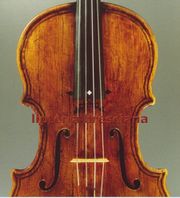
(Currently unavailable) Brescia was the first home of violin-making. So many of the early makers died in the plague of 1630-31 that Brescia was unable to regain its former glory. It exerted considerable influence on instrument-making in nearby Cremona, which flourished after 1650. Ugo Ravasio's former website (Liuteria Bresciana) covered the period from 1550 into until the mid-eighteenth century. His integration of archival documents, pictures of instruments, and a searchable database filled an important hole in our knowledge of the development of bowed string instruments. The great plague of 1630-1631 halved the Brescian population and nearly destroyed the instrument trade. The revival of this website is warmly anticipated.
MINIM-UK
Website: http://minim.ac.uk
MINIM is a composite online website (Musical Instrument Interface for Museums and Collections) for information, photographs and pertinent recordings of instruments in UK and Irish collections. With 20,000 listings, it is the largest repository of its kind in the UK and is managed by the Royal College of Music, London. Its central contributions come from the Royal College of Music, Edinburgh University, the Royal Academy of Music, and the Horniman Museum. Users may browse by collection or by instrument family. They may search by instrument name. Vivid illustrations are plentiful. MINIM is loosely linked with them pan-European MIMO project.
Music Instrument Museums Online (MIMO)
Website: http://www.mimo-international.com/MIMO
Music Instrument Museums Online (MIMO) is a multilingual, searchable site providing descriptions of individual musical instruments in curated collections worldwide. Its 55,000 items can be viewed by family or by location. Results can be filtered by date, place of production, and maker. Measurements and other details of each instrument are provided. Its iconographical value is very considerable. The spinet of 1610 by Vincenzo di Prato, pictured here, comes from Grassi collection in the museum of the University of Leipzig. MIMO's search engine adds new competencies by the week and currently supports more than a dozen languages including Chinese, Korean, and Basque (Euskara) as well as European languages and English.
National Music Museum
Website: http://orgs.usd.edu/nmm
The National Music Museum (Vermilion, South Dakota, US) possesses a highly diverse collection of instruments. It also houses a program on instrument conservation. The main components of the collections are (1) the Witten-Rawlins collection of Northern Italian (Brescian-Cremonese) strings from the seventeenth century, (2) an extensive group of instruments manufactured in the US in the nineteenth and twentieth centuries, and (3) a substantial collection of instruments from other parts of the world. The NMM provides links to many other little-known collections.
The Piano in Polish Collections
Website: http://www.piano.instruments.edu.pl/en/piano-makers
This website contains databases (with copious photographs) of historic collections, instruments, and ephemera in several Polish collections including the Museum of Industrial History in Opatowic, the Andrzej Szwalbe Collection in Ostromecko, and the Fryderyk Chopin Institutein Warsaw. Many of the photographs in the blog contain sketches, pastels, lithographs, and paintings of musicians at work.
Polish Folk Instruments
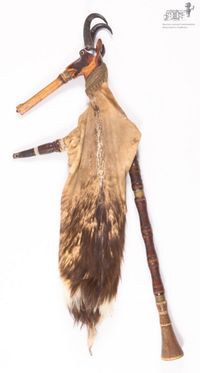
Website: http://instrumenty.edu.pl/en
The Museum of Folk Instruments in Szydłowiec, established in 1968, houses the largest collection of folk instruments in Poland and documents rich musical relationships with adjacent regions. Holdings date from the seventeenth century onward and currently number more than 2,000. The collection (which is housed in the Szydłowiecy-Radziwill Castle, is particularly rich in bowed instruments, cymbals, and bagpipes. Some links within the site provide sound files.
Historical and Liturgical Calendars
Historical Calendars of Europe (HCAL)
Website: http://hcal.ccarh.org
Those looking to reconcile modern dates with those in use before the Gregorian calendar was adopted can derive a correct translation here. Many more calendars were in use than those indicated here. Adoption of the Gregorian (modern Western) calendar occurred between 1582 and 1926. Standardized tools to generate early calendars (e.g. the Unix cal tool) ignore historical change and thus render incorrect results for some locales and periods of time.
Liturgical Calendars
Many sights offer these modern calendars with various degrees of refinement, but they are not appropriate for historical use. There can be local variations in the days of minor saints. See such sites as Liturgy Office (UK); the Liturgical Calendar Online; Greek Orthodox. Some cultures maintain separate civic and religious calendars and thus impose an additional level of complexity to the reconciliation of dates. Orthodox Jewish culture offers one example. In simpler circumstances, the Etz Hayim website offers instructive examples on the reconciliation of Christian and Jewish dating systems. The Muslim calendar is complicated in a global context because of its dependence on (the time of) the initial visibility of a new moon, in combination of adherents across many times zones. Additional cultures and religions, including Buddhism and Eastern Orthodoxy, are included in Santa Clara University's Calendars of the World's Religions website.
Performers and Musical Personnel
Marian Anderson: Diaries and Notebooks
Website: https://fromthepage.com/upenn/diaries-and-notebooks-of-marian-anderson
The digitization of Marian Anderson's diaries and notebooks awaits crowd-sourced transcription to make its content fully searchable. It is an enticing and extensive collection that captures an important chapter of American social as well as musical history. Anderson (1897-1993) spent most of her life in Philadelphia, and the preservation of this collection (more than 2,500 items) at the University of Pennsylvania suits it well. Performers' tussles with racial barriers paralleled those of sports figures in the middle decades of the twentieth century. The letter excerpted here documents a turning point both in Anderson's career and in what became a milestone in the Civil Rights Movements: having been prevented from appearing in Constitution Hall on Easter (April 9) in 1939, she sang on the steps of the Lincoln Memorial for a crowd of 75,000.
Musico Napolitano (Neapolitan Musician)
Website: http://musiconapolitano.unifr.ch
Musico Napolitano is a searchable database of references to musicians from Naples cited in letters, archival records, institutions, and other documentation. Based at the University of Fribourg, Switzerland, it has the aim of fleshing out bibliographies of migratory musicians whose biographies are not easily traceable. The website offers several rubrics to search by. These include rosters organized by name, role (or instrument), and institution. The map identifying the location of institutions is very useful. The website welcomes contributions of information.
Other Rubrics
British Music Festivals Repertoire (1695-1940)
Website: http://musicalfestivals.org
The Musical Festivals Database (MFD) provides a searchable database of repertory programmed in British festivals between 1695 and 1940. Many items come from the choral festivals that were popular in Britain in the eighteenth and nineteenth centuries. Results can quickly attest to the fickleness of taste, as specific locales, composers, and genres blinked on an off for brief periods.
European Theatre Architecture (EUTA)
Website: https://www.theatre-architecture.eu
Europe abounds in historical theaters, many associated with individual composers and repertories. This extensively illustrated resource combines historical detail with carefully composer photographs not only from the front stage view but also behind the scenes. It is presented in twelve languages with a button from automatic translation. Its centerpiece is the castle theater of Czesky-Krumlov (shown), which was begun in the 1660s, has been periodically closed, and once again offers Baroque opera.
Germania Sacra
Website: http://personendatenbank.germania-sacra.de/index/browse
Germania Sacra has several facets to what is essentially a database of personnel in German churches and monasteries from the medieval through early modern periods. Primary emphasis is placed on earlier period. The register of people (linked here) gives the flavor of the whole. It contains 4,000 listings (2016).
Medici Archive Project
Website: http://www.medici.org
The Medici Archive Project (MAP) is an ambitious effort to focus attention on the vast archives of the Medici Principiate (which endured from the early Renaissance until 1737) in the Florentine State Archives. It is conceived as a continuing project and has spawned several quasi-independent enterprises. The online database provides short transcriptions from across the entire documentary base. The project has thus far produced more than 300,000 digitized images of records from the Medici court. Its current activities emphasize lectures and the production of videos on specific topics related to the three centuries of rule by the family.
Reid Concerts
Website: http://www.reidconcerts.music.ed.ac.uk/content/home
This database of concerts (from 1841) itemizes musical programs given at many venues in the city of Edinburgh under the auspices of the the Reid School of Music in the University of Edinburgh. By itmeizing the contents of many of all preserved concert programmes, it attempts to chart the development and evolution of the ‘Reid Concerts’. Users may investigate composer, medium, genre, venue, date, or even professor in charge to cull specific profiles. The data collection overall enables the study of changes of taste and pedagogy as well as the constellation of pieces that make up concert programs. Begun in 2013, 'Reid Concerts' is still under development. (The School of Music is now a department within Edinburgh College of Art.)
Composer/Theorist Documentation
Bach Digital
Website: http://www.bachdigital.de/content/index.xml?lang=en
Bach Digital, based in Leipzig, is a one-stop shop for a catalogue of work by J.S. Bach (BWV); of scanned manuscripts; and of a database of manuscripts associated with the Bach family. When complete, it is intended to serve a wide variety of needs of scholars and interests of a wider music audience. An earlier Datenbank der Bach-Quellen (Database of Bach Sources) operates under the auspices of Göttingen's Johann-Sebastian-Bach Institute here.
Max Bruch Archive
Website: https://musikwissenschaft.phil-fak.uni-koeln.de/index.php?id=13144
This online archive documenting the life of Max Bruch (1838-1020) contains letters (c5000 of them), compositions, and other relevant materials. It was assembled at the University of Cologne between 2012 and 2021.
Irving Berlin Collection (Library of Congress)
Website: https://www.loc.gov/item/2012562128
This collection abounds in the artifacts of Berlin's long life (1895-1990). From scrapbooks of press clippings to account books for the Music Box Theater and family letters to copyright assignments we see the composer of "White Christmas" and "There's No Business like Show Business" in a constant swirl of activity. Most full scores, vocal scores, and sketches were transcribed by secretaries. Berlins' lyrics come from his own hand. For copyright reasons most items are unavailable until 2039.
Arrigo Boito Papers (Archivio Boito Digitale)
Website: https://opac.sbn.it
Arrigo Boito (1842-1918) was a composer but also a poet, novelist, and journalist who sometimes wrote under a pseudonym. His is best known today for his librettos for Verdi's Otello and Falstaff plus other stage works of the time. The circuitous route to a coherent archive of the composer's drafts and life began with the celebration of the centenary of his death in 2018. The variety and complexity of material may be typical of the musical giants of the later nineteenth century. A noted element of his biography was his long affair with the noted actress Eleonora Duse (1887-1894). Boito also served for eight years (1889-1897) as director of the Parma Conservatory.
What is unusual about this project is the coordination of materials in diverse physical locations to create a virtual archives through the SBN (Italian National Library) catalog.
Aaron Copland Collection (Library of Congress)
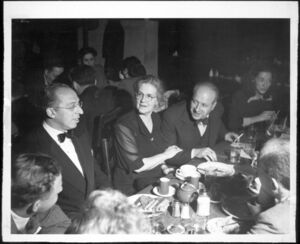
Website: https://www.loc.gov/collections/aaron-copland
The heterogeneity of this collection (782 items) represents the full array of Copland's life and activities. We go from photographs with his schoolmates in a Brooklyn second grade to retreats with distinguished colleagues in the late years of his life. Copland's essay of film music, prepared for a talk at Columbia University in 1940, which was based on his year of employment in Hollywood, offers a glimpse of the rapid pace of change in response to growing popularity of the medium.
Fux Online
Website: http://www.fux-online.at/cms_seite.php?content=0&menu=1
Fux Online is a growing compendium of information about Johann Joseph Fux (c. 1660-1741), Austria's much revered master of counterpoint. Fux wrote his Gradus ad Parnassum of 1725 in Latin. Only after his death did a German translation by L. CH. Mizler bring it to broader attention. The original work was dedicated to his employer, the Emperor Charles VI. The Gradus ad Parnassus (Steps to Mt. Parnassus, the home of the Nine Muses) is considered the fount of species counterpoint. It attracted such students as G. Ch. Wagenseil and J. D. Zelenka. The approach was strongly influential on composers of the later eighteenth century. It is not generally regarded as descriptive of sixteenth-century Roman practice, although it distills observable practices of that time. Fux Online complements that standing image of Fux with coverage of his sacred vocal music and introduces a new critical edition of Fux's music by Hollitzer Verlag, which will include 600 works.
Handel Reference Database
Website: http://ichriss.ccarh.org/HRD
The Handel Reference Database (HRD) provides a continuously updated version of the documentation that accompanied the Stanford doctoral thesis on the reception of the music of G. Fr. Handel by Ilias Chrissochoidis.
Lassus Manuscript Database
Website: https://lasso-handschriften.badw.de/metaopac/start.do?View=lasso
More than 470 prints of Lassus's compositions up to 1687, but many titles known from the prints cannot today be verified against surviving manuscripts. This inventory of manuscripts follows on from Horst Leuchtmann and Bernhold Schmid's inventory of printed works (Kassel, 2001) and attempts to clarify the status of both surviving and lost titles. It supports single-parameter and Boolean (multiple-criteria) searches.
Mozart Correspondence
Website: http://dme.mozarteum.at/DME/briefe/doclist.php
This online edition, based on the 1962 edition of Wilhelm Bauer and Erich Deutsch, contains 955 documents. Each letter is presented in parallel in a modern transcription and a photographic reproduction of the original. The resource is maintained by Salzburg Mozarteum and The Packard Humanities Institute.
Mozart Family: Letters and Documents (1755-1879)
Website: https://dme.mozarteum.at/briefe-dokumente/online-edition
The Salzburg Mozarteum, which houses the correspondence of Mozart's father, sons, widow, and other musicians is digitized in date order.
In Mozart's Words
Website: http://letters.mozartways.com
In Mozart’s Words provides multilingual access to an annotated version of the voluminous correspondence of Mozart and his family (a corpus of approximately 1,400 letters) that will be made available online on this website. The website offers (1) a univocal database of all references to people, places, and musical works contained in the letters, facilitating the systematic search of all cited occurrences, and (2) access to background materials such as reviews, newspapers, documents, objects, paintings, engravings, and books as a corollary to the historical-critical annotations. The texts are synonymous with those of Cliff Eisen's online edition of Mozart's correspondence (2011: ISBN 9780955787676).
Mozart: New Documents
Website: https://sites.google.com/site/mozartdocuments/home
The aim of this collaborative project, managed by Dexter Edge and David Black, is to bring documentation not reported in musicological literature to public attention. Some items have been retrieved from large repositories of digitized text. A chornological list of posted documents can be found here.
Ricordi Historical Archives: Verdi Correspondence and Memorabilia
Website: https://www.ricordi.com/en-US/Ricordi-Archive.aspx
As one example of its holding, the Verdi Letters Collection (1786 of 2092), which includes correspondence and scenery designs, pertains to Verdi and his dealings with Giovanni, Tito, and Giulio Ricordi. It includes negotiations with librettists and others concerning casting, staging, and other production details, 1849-1893. One letter (1897) is from Giacomo Puccini. Other holdings trace productions of Verdi's works across Europe and cite relatively recent stagings, sometimes with photographs of the productions.
Saramusic (Arabic manuscripts and texts on music)
Website: https://www.saramusik.org/auteurs/ Saramusic
The Saramusic website is in Arabic. The left-hand button on the homepage leads to an "Auteur" (author) listing, while the right-hand one produces a list of texts. The materials are carefully curated, with color-coding to distinguish different categories of information. The Google Translate tool (translate.google.com) is able to render the (paleo)graphical content easily, which speaks well for its careful preparation. Further information is available from Anas Ghrab (anas.ghrab@gmail.com).
Schenker Documents Online
Website: http://www.southampton.ac.uk/music/research/projects/schenker_documents_online_project.page
Schenker Documents Online (Southampton University) provides a scholarly edition of Heinrich Schenker's correspondence, teaching notes, and translations of materials in German that help to show the gestation and development of his ideas. It concentrates on the period 1925-1930.
Franz Schubert Online
Website: http://www.schubert-online.at
Schubert Online offers combined access to a total of 555 autograph scores, letters, and other documentation on Schubert. Much of the work was facilitated by the Vienna Science and Technology Fund [WWTF or Wiener Wissenschafts-, Forschungs- und Technologiefonds]. The holdings covered come from Vienna's City Hall [Rathaus], the Austrian National Library, the State Library of Berlin, and the National Library of Norway, with intellectual contributions from the Music and Psychology program in Cologne and the Musicology Institute at the University of Vienna. Full-text search is supported for the letters. Deutsch Numbers are used for the music manuscripts. In most cases copies of manuscripts must be ordered from the holding library.
Ludwig Senfl Online
Website: http://www.senflonline.com
The most important composer in Bavaria in the first half of the sixteenth century, Ludwig Senfl (c. 1490-1543) spent almost all his life in the Munich court chapel, first as a choirboy, then as a musician and composer. Polyphonic incipits in mensural notation are among the items that can be retrieved by genre, voicing, and so forth. Cross-linked to DIAMM.
Louis Spohr Correspondence
Website: https://www.spohr-briefe.de
Between 1803 and the end of his life, Louis (Ludwig) Spohr (1786-1859) was constantly in touch family members, composers, conductors, and other musicians. The Kassel University Library has digitized his correspondence. Spohr composed roughly 300 works (half did not carry opus numbers). They included symphonies, operas, Lieder, and other genres. A violinist and conductor, Spohr is credited with the invention of the chinrest, the conductor's baton, and rehearsal letters but is remembered partly for his influential Violinschule. His autobiography is unpublished. His self-portrait (c. 1830) is shown here.
Giuseppe Verdi Correspondence (Braidense Library)
Website: https://www.ricordi.com/it-IT/News/2017/01/Images-critical-editions.aspx
This archive contains high diverse materials documenting the lives of Bellini, Puccini, Verdi, and several other composers active in Milan in the nineteenth century. Among the featured items are Verdi's letters (1838–1883), especially those concerning the countess Clara Maffei and Verdi's wife, Giuseppina Strepponi. The materials were digitized and placed online for the Verdi centenary in 2013 by the Braidense National Library (in Milan). See also the Arrigo Boito Archives above.
Digitized Manuscripts and Early Printed Music
Danish National Digital Sheet Music Archive
Website: http://www.kb.dk/en/nb/samling/ma/digmus/index.html
The Danish National Digital Sheet Music Archive is a model operation. Note the frame at the left, which identifies all digitized music; a special collection for flute; another for guitar; and the entire Carl Nielsen Edition available for download. Although Danish music is well served, the site includes a great deal more, including eighteenth-century manuscripts, standard repertory in high-quality late nineteenth-century prints, and a special theater collection including opera libretti.
Darmstadt University and State Library Digital Manuscript Collection
Website: Darmstadt USL Digital
This collection is rich in musical autographs by Christoph Graupner (1683-1760), who served the Landgrave Ernst Ludwig of Hesse-Darmstadt (1667-1739) for decades and produced enormous quantities of music throughout his tenure. He was well informed about the music of his peers and often arranged their works for his court's use. Florian Heyerich maintains a complementary [www.graupner-digital.org Graupner website].
Early Music Online
Early Music Online is a digital repository of music in printed anthologies principally from the sixteenth century. Based on holdings in the British Library and related to one series of RISM listings, the digitized volumes of EMO include madrigals, sacred songs, music "concerted by voices and instruments," and pedagogical works.
National Library of Scotland
Website: http://digital.nls.uk/special-collections-of-printed-music/pageturner.cfm?id=97135481
These digitized sources provide access to digitized copies of the Inglis collection of printed music, memoirs, lyrics to Scottish folksongs, musical magazines, and Scottish keyboard music.
Singakademie Music Archives
The collection of mainly eighteenth-century vocal music belonging to Berlin's Singakademie since the time of Karl Friedrich Zelter was long dislodged by twentieth-century wars and politics. The institution's history is the focus of a project to digitize letters, documents, and materials on which prospective applications were tested. The Singakademie is also a participant in the Bach Digital and other projects related to music and musical culture of the eighteenth and nineteenth centuries.
Online Thematic Catalogues and Indices
The Bizet Catalogue
Website: http://digital.wustl.edu/bizet
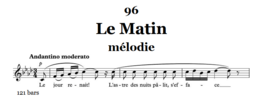
Every repertory has idiosyncrasies that make the adoption of a standard template ill-advised. Hugh Macdonald's Bizet Catalogue shows one of Bizet's idiosyncrasies through a listing of the composer's transcriptions of works by others (Gounod, Mozart, Saint-Saëns, et al.). The primary listing of works gives folio-by-folio detail of manuscripts for longer works with texts of underlying verses and notes on their authors, citations of self-borrowings, and much else.
Benjamin Britten Thematic Catalogue
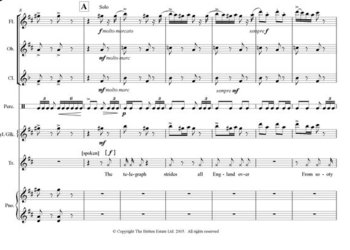
Website: http://www.brittenproject.org
The Britten Thematic Catalogue, an online only project based at the Britten-Pears Foundation, provides multiple access points for searching. Britten's career was extremely wide-ranging. His arrangements of music by Henry Purcell (54 titles) and of British folksongs (74 titles) filled much of his time in the 1940s and early '50s. The full gamut stretches from chamber music (134 items) mainly from the 1920s to his stage work Death in Venice (1973). Each work contains a detailed index with a graphical display and sound files.
Chambonnières: A Thematic Catalogue
Website: http://sscm-jscm.org/instrumenta/instrumenta-volumes/instrumenta-volume-1
Bruce Gustavson's Chambonnières: A Thematic Catalogue. The Complete Works of Jacques Champion de Chambonnières (1601/02–1672) appears as Vol. 1 in the Instrumenta series of the Society for Seventeenth-Century Music. The series is digital only and is dedicated to voluminous music bibliographies.
Frescobaldi Thematic Catalogue Online
Website: http://frescobaldi.music.duke.edu
This database, developed by Alexander Silbiger at Duke University, has a multi-faceted search interface. It is cross-linked to RISM IDs and has detailed source listings. (Content tends to vary slightly by source.) The general time-frame indicator gives a sense of the long tradition of recopying that followed the composer's works. Links to printed commentaries and modern editions are provided. Currently 906 works are included.
GWV - Graupner-Werke-Verzeichnis (Thematic Catalogue of the Works of Christoph Graupner)
Website: http://www.graupner-digital.org/gwv.php
This online catalog of works for Christoph Graupner (1683-1760) contains links to his digitized manuscripts at the Technische Universität in Darmstadt. After studies at the Thomas Schule, Leipzig, and a stint as cembalist of the Hamburg Opera orchestra (from 1705), Graupner was called to the service of Ernst Ludwig of Hesse-Darmstadt (1709). He remained there for the rest of his life. His numerous works (1,418 church cantatas, 24 secular cantatas, 113 symphonies, 44 solo concertos, 80 suites, miscellaneous chamber music, and eight operas) are largely preserved in the Darmstadt University and (Hessian) State Library. Links on the left lead to manuscript reproductions, those on the right to commercial recordings and editions. Florian Hayerick directs the project.
J.P.E. Hartmann Catalogue (Thematic-Bibliographic Catalogue of His Works)
Website: http://www.kb.dk/dcm/hartw/navigation.xq
Among his 590 compositions, Johan Peter Emilius Hartmann (1805-1900) demonstrated his mastery of all current genres (stage, choral, instrumental, organ, and vocal music) during his long lifetime. Although of German descent, he spent almost all of his life in Copenhagen. Louis Spohr and Christoph Ernst Friedrich Weyse were important influences. He was also acquainted with Fryderyk Chopin, Gioachino Rossini, and Luigi Cherubini. This presentation color-codes each genre so that as users pass down the list of his works, they can easily recognize changes of boundary without being trapped by them. Within each genre, listings are organized alphabetically.
Franz Liszt: Digital Liszt Sources and Works Catalog)
Website: https://www.uni-heidelberg.de/en/newsroom/franz-liszt-digital
This recently launched project to catalogue all Lizst (1811-1885), based at the University of Heidelberg, emphasizes resources in Dresden and Weimar, where the composer spent some periods of his life. Christiane Wiesenfeldt is the director. Liszt's father ws a musician in the Esterhazy court in Sopron (Hungary today, Austria then). He is remembered today for his many innovations in musical form and harmony and for his many friendship with composers and writers. Some early fruits of the project have been made available by RISM. See Lizst resources listed by RISM.
Catalogue of Carl Nielsen's Works

Website: http://www.kb.dk/dcm/cnw/navigation.xq
The Danish National Library has prepared this online catalogue of 414 pieces, including operas, symphonies, and concertos plus vocal, choral, and chamber pieces. Each entry includes musical incipits, lists of sources and sketches, citations for textual sources, and lists of performances.
In association with the Nielsen Catalogue, implemented by Axel Teich Geertinger, an editing tool for metadata used in similar projects has been developed by Sigfrid Lundberg and can be downloaded from GitHub. Based on MEI, the foundation of MerMEId was laid by Kristine Richts and Maya Hartwig. Further details about MerMEId and a sample implementation can be found at this site.
Johann Adolph Scheibe: A Catalogue of his Works
Website: http://www.kb.dk/dcm/schw/navigation.xq
The son of an organ-builder, Johann Adolph Scheibe (1708-1776) studied law in Leipzig prior to pursuing a career in music. During a short stint in Hamburg, where he met Johann Mattheson, Schiebe began his periodical Der Critische Musicus (1737-1740). It lapsed after his move (1739) to Copenhagen, where he served as court Kapellmeister first under the pious Christian VI, then under the more liberal Frederick V. Apart from his criticism, theoretical works, satires, and letters, Scheibe authored 80 instrumental pieces, a few dozen secular vocal works, a handful of stage pieces, songs, poems, text translations, and a few satires. This catalogue of holdings, produced by the Danish National Library, includes digitized images of them.
Printed music resources
Prices of Music at Breitkopf & Härtel
Website: https://dstrykowski.shinyapps.io/pricesofmusic
In a great wave of music publishing in the nineteenth century, Breitkopf & Härtel of Leipzig was a leader. This website offers titles of sheet-music and their prices as listed in the monthly supplement called the Intelligenz-blatt zu Algemeine musikalische Zeitung over the period 1798 to 1838. This data set contains 6,405 advertisements for the music of approximately nine hundred composers and arrangers. Details gathered from the publication lists include the issue number, date of advertisement, name of composer or arranger, title of publication (often with key and instrumentation), and price as quoted in Saxon thalers and groschen.
Verzeichnis deutscher Musikfrühdrucke / Catalogue of early German printed music
Website: https://vdm-maps.zgis.at
When it comes to offering multiple views of data (in this collected for cataloguing), the Verzeichnis/Catalogue of Early Printed music in German-speaking lands (1470-1550) offers an apt demonstration. Eight views, each focusing on a different aspect of the material, are presented. The charts are interactive, and by clicking on them further detail arrives in pop-ups.
Ethnomusicology
Images, sound files, and videos on the internet offer great scope for ethnomusicological study, but much of the material is limited to poorly documented materials with arbitrary labels. Only selected sites can be included here.
OSMIKON
This search engine (in German) for literature on world music concentrates on music from South, Central, and Eastern Europe but covers myriad other places (Bolivia, Bulgaria, Vietnam, Bollywood dance) and theoretical perspectives on a broad range of topics. It forms part of the Virtuelle Fachbibliothek Osteuropa (Virtual Library of Eastern Europe). Searches for the word "Musik" serve as an orientation.
Philippine Indigenous Instrument Sounds (Katunog)
Website: https://katunog.asti.dost.gov.ph
This database of sounds, hosted by the Department of Science and Technology of the Advanced Science and Technology Institute (DOST-ASTI), University of the Philippines (UP), provides photographs, descriptions of indigenous instruments and how they are played, together with sound samples synchronized with animated illustrations. The site provides substantial amounts of metadata and selected videos of performances.
UNC Middle Eastern Music
Website: http://guides.lib.unc.edu/c.php?g=9254&p=45825
The University of North Carolina offers top-down collections of selected repertories from Egyptian, Turkish, Iraqi, and classical Persian music. Each site varies from the others. Explanatory material concerning composers, instruments, styles, and cultural emphases are general to most. The Farabi site also discusses theoretical concepts in Persian classical music. The Turkish one contains many sound examples.
Tunisian Recordings (CMAM)
Website: http://phonotheque.cmam.tn/archives/full_access_items
The phonothèque of the Centre des Musiques Arabes et Méditérranéennes (CMAM) offers access to almost 2,500 recordings of Tunisian music in its Ennejma Ezzahra website. Dates of recordings, which are predominately from recent decades, are given in an accompanying database. Titles are given in Arabic script and in transliteration. The recording entity and the sponsor are also indicated.
Resources for Chronology
Music Bibliography in the German Democratic Republic
Website: http://digital.slub-dresden.de/werkansicht/dlf/2258/1/cache.off
Music Bibliography in the German Democratic Republic (Deutsche Demokratische Republik or DDR, 1949–1990) is an idiosyncratic subject but one which those engaged in music history of the later twentieth century may find compelling. The illustration accompanying this entry shows the full title of a typescript catalogue of new works (scores, writings on music theory, books, articles, and much miscellany) for the year 1975. This item can be found here.
Hofmeister XIX
Website: http://www.hofmeister.rhul.ac.uk/2008/index.html
Database of 330,000 records from the Hofmeister Monatsberichte, 1829-1900, listing music publications of the period. Compiled by Friedrich Hofmeister and published in Leipzig by Breitkopf & Härtel. Well indexed for quick searches.
Libretto Portals
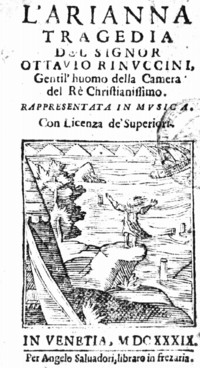
Corago Project
Website: http://corago.unibo.it
The Corago website contains multiple indices related to the history of opera. The libretto search engine is a comprehensive tool for locating information about librettos in catalogued collections. Hyperlinks to digitized librettos (see below) are inserted as appropriate. A database of productions continues up to present times. Clicking in the top row of the results orders results according to user preferences.
Corago is a collaborative project headed by Angelo Pompilio. Institutional cooperation is provided by almost two dozen institutions in Northern Italy. The two largest libretto collections included are the Corniati-Algarotti (12,000 librettos) listed separately below and that of the Museo Internazionale e Biblioteca della Musica (11,000 librettos) in Bologna. Corago is the central search-engine for digitized libretti in the Bologna collection, but other pertinent materials can be found here.
Corniani-Algarotti Libretto Collection
Website: http://www.braidense.it/cataloghi/catalogo_rd.php
Although the search form shows only four fields, the name field (nome) will accept almost any proper noun (surname of composer, librettist, scenographer, city, theater, etc.). Most sources are digitized and downloadable. This collection holds 9,000 libretti (in Italian) from the sixteenth through the nineteenth centuries. Some were published and used outside Italy. Most texts were for operas, but oratorio, cantata, and serenata texts can also be found.
Russian Opera Libretti
The Russian Opera Libretti collection at Princeton University contains scripts for operas published between 1815 and 1916. Most works are well known. Works set to music by Donisetti, Meyerbeer, Mussorgsky, Scriabin, Tchaikovsky, Verdi, and Wagner are included.
Albert Schatz Collection (Library of Congress)
Website: https://www.loc.gov/collections/albert-schatz/about-this-collection
The Rostock music dealer Albert Schatz (1839-1910) intended to write a history of opera based on primary sources. Although this goal was not realized, the donation of his sources and notes to the Library of Congress more than a century ago (1908) has long been a valuable offline resource. Scanned copies of more than 12,000 libretti, primarily representing Italian, French, and German prints of the seventeenth through nineteenth centuries, have now been placed online. The printed catalog of the collection by Oscar Sonneck is well known. Various filters can be found here.
VifaMusik Libretto Portal
Website: http://libretti.digitale-sammlungen.de/de/fs1/start/static.html
The new (2014) VifaMusik Libretto Portal searches across component collections held in the Bavarian State Library (5600 items), the Frankfurt University Library, and the Library of the German Institute in Rome (1500 titles). One can search by composer, librettist, and so forth. Since the term libretto referred to any small book, texts for oratorios, cantatas, serenatas, ballets, and so forth occur in some of the constituent collections.
Index to Opera and Ballet Sources Online
Website: https://atom.lib.byu.edu/obps/
Portals and Search Engines for Music
How does one search for musical content that cannot be located by metadata? These websites, each of which employs a different approach, will show you how.
Cantorales de la Biblioteca Nacional de Espana
Website: http://www2.bne.es/CANT_web/irBuscadorPentagrama.do?lang=es_ES
This search site for individual chants found in Canorales (choir books) of Spanish libraries can be searched by text or musical incipit. (Click on the musical staff and enter at least two notes to see how the music search works.) The advanced search (Busqueda avanzada) provides a dozen fields, including feast days.
Cantus Index
Website: http://cantusindex.org
The Cantus Index, managed at the University of Waterloo (CA), is a network of 11 international projects (as of 2016) that have adopted the data format and identifier system of the Cantus Manuscript Database. These projects are devoted the creation and distribution of electronic inventories of medieval chant manuscripts. With the Cantus Index as the “hub,” the Index provides a central catalogue of chant texts and melodies for the Office and Mass. Searches in Cantus Index of both texts and melodies return results in all partner databases. The projects currently searched include these separately listed repositories:
- Antiphonale Synopticum (Harald Buchinger, Universität Regensburg, DE)
- Cantus Manuscript Database (Debra Lacoste, University of Waterloo, CA)
- Cantus Planus in Polonia (Bartosz Izbicki, Warszawa, Poland)
- Cantus Ultimus (Ichiro Fujinaga, McGill University, Montréal, CA)
- Comparatio (Claire Maître, CNRS, Paris, FR)
- Fontes Cantus Bohemiae (Jan Koláček and David Eben, Prague, CZ)
- Gregorien.info (Inga Behrendt, Masaryk University, CZ)
- Hungarian Chant Database (Gàbor Kiss, Budapest, HU)
- Musica Hispanica (Carmen Julia Guttiérez, Universidad Complutense, Madrid, ES)
- Portuguese Early Music Database (Manuel Pedro Ferreira, Lisbon, PT)
- Slovakian Early Music Database (Eva Veselovskà, Bratislava, SK)
User contributions are welcomed.
Dutch Song Database and Search Engine (Nederlandse Liederenbank)
Website: http://www.liederenbank.nl/searchmusic/piano.php
The Dutch Song database (Nederlandse Liederenbank) lists 150,000 songs in Dutch and Flemish from the middle ages through the 20th century. It includes love songs, satirical songs, Beggar songs, psalms and other religious songs, folksongs, children's songs, holiday songs, and much else. Among the other searches supported, its melodic search engine is particularly effective.
Sources include sources for all these songs are songbooks, songsheets (broadsides), song manuscripts and fieldwork recordings. The Meertens Institute (Amsterdam) compiled the database, which is now maintained by the Centre for Documentation and Research on Dutch Song. The impetus for starting the project came from the Utrecht ensemble Camerata Trajectina, which has now donated its recordings to the website. In 2014 the project was awarded the Dutch Data Prize in Humanities and Social Sciences.
E-manuscripta
Website: http://www.e-manuscripta.ch
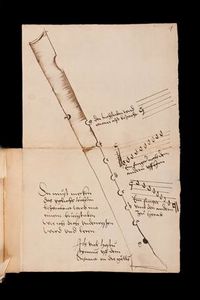
This comprehensive portal for materials in Swiss libraries serves scores, photographs, letters, pedagogical materials, and much else. The five-leaf recorder tutor (from a sixteenth-century manuscript) shown at the side represents its heterogeneity, which also extends to sixteenth-century part-books, organ tablatures, correspondence by Martin Luther, photographs of Ferruccio Busoni, and a thousand maps. It also supports user-generated transcriptions.
Europeana: Search Engine for European (Music) Sources
Website: http://www.europeana.eu
This umbrella site for European digitization projects covers a great deal besides music. To start, limit the search by an obvious word for music (musique, musica, Musik, etc.). This will give you an idea of how to further limit the search. Europeana is updated often. Among the items that should be visible are music prints, manuscripts, newspapers dedicated to music, sheet-music, audio files, etc. Since Europeana is an aggregation, it provides links back to the sponsoring libraries that hold the original sources. The site can be searched in many languages.
European History Primary Sources
Website: http://primary-sources.eui.eu/portal/virtuelle-fachbibliothek-osteuropa
The focus of his comprehensive site is the "history, language, literature, politics and culture of East, Central East and South East European countries and regions." It offers access both directly and indirectly through search engines. EHPS can also search across resources, a capability that other forms of access do not usually offer. It provides links to country-based websites. The music "topic" search produces random results among which are some that may not be familiar from other umbrella resources. The alternative Osmikon interface is in German.
Gallica
Website: http://gallica.bnf.fr
Gallica provides access to an enormous array of digitized materials from all periods of French history and many aspects of French musical life in addition to great quantities of non-musical material. Among its highlights are illuminated manuscripts containing the poetry (much of it set to music by Guillaume Machaut), manuscripts of the operas Francesco Cavalli composed for the wedding of Louis XIV (1660-62), a very large amount of music printed in France in the eighteenth and nineteenth centuries, and important documentation for theatrical history. Although the quantity of material is enormous, the search tools allow for precise articulation with distinctions between scores, manuscripts, recordings, press reports, and commentary. Gallica is, in addition, a national resourcce with links to materials in all French provinces.
Global Chant
Website: http://globalchant.org/about.php
Have you ever tried to identify a chant melody or to find all the settings of one text incipit? Global Chant will reduce the frustration. At the Search link you can enter the pitches on the virtual staff. Under Links you can pursue data at related sites. (Some not otherwise represented here are AISCGRE, Cantus Augusta, CURSUS, LIMVP, and Melodiarium Hymnolodicum Bohamiae.) At the Forum you can exchange information with other researchers. Jan Kolacek has developed this site in course of his graduate studies at Charles University, Prague.
Index to Opera and Ballet Sources Online
Website: http://atom.lib.byu.edu/obps
The Index to Opera and Ballet Sources Online is a combined database and meta-search engine with a growing list of detailed fields, many of which are sortable. It links titles to scores, libretti, and other artifacts. It can be searched with filters for language, theater, and many other parameters of musical works that were stages. The title index relied originally on aggregators (the Braidense Raccolta Drammatica, ViFaMusik, the Internet Culturale, et al.) for most of its contents but now includes the Internet Archive. The advance search tool at atom.lib.byu.edu/opbs/advanced allows one to search within individual aggregations.
The Internet Culturale
Website: http://www.internetculturale.it/opencms/opencms/it/main/esplora/index.html?tipo=collezione
An umbrella site for digitized materials in Italian libraries. The riches of Italy's collective Internet Culturale (cultural internet) are difficult to overstate. A vast span of different kinds of graphically reproduced material will be found here. All of it is accompanied by generous supplies of metadata from cataloguing records. While one may be able to find a specific item such as an opera, one may also discover on a different spoke a list of all the works in which the singer of an aria appeared. Users can create accounts to collect previous discoveries in one place.
OSMIKON
This search engine (in German) for literature on world music concentrates on music from South, Central, and Eastern Europe but covers myriad other places (Bolivia, Bulgaria, Vietnam, Bollywood dance) and theoretical perspectives on a broad range of topics. It forms part of the Virtuelle Fachbibliothek Osteuropa (Virtual Library of Eastern Europe). Searches for the word "Musik" serve as an orientation.
Machaut (Mirador) Viewer
Website: http://machautsociety.org/static_pages/mirador.html
The International Machaut Society takes good advantage of the open-source Mirador Viewer to enable users to compare IIIF-compliant digitized images of the music and poetry of the fourteenth-century French composer Guillaume Machaut. The tool (used in many projects outside the field of music) facilitates leafing through multiple sources on a single screen. A comprehensive (flat) listing, searchable via numerous drop-down menus, integrates additional digitized sources. The Society website contains links to further materials and projects pertinent to the composer.
Munich Digital Manuscript Collection
Website: http://www.digitale-sammlungen.de/index.html?c=sammlungen&kategorie_sammlung=1&l=de
The collection of digital materials grows so rapidly that any listing of individual collections within it is doomed to be incomplete. Several projects are cooperative. The historical foundation rests on the Middle Ages and Renaissance, with much emphasis is given to religious figures and documents (e.g. at Europeana Regia). A combined search engine (http://www.digital.collections.de) for all the digitized materials in the Bavarian State Library is currently under development.
MusicBrainz
Website: http://www.musicbrainz.org
The MusicBrainz Database is an open-source reference for recordings providing relational searches for artists, releases, recordings, works, labels, and connections between them. Users can annotate, tag, and rate individual items. This open-source database is downloadable. The host MetaBrainz Foundation offers a sliding scale of memberships progressing from academic to commercial.
Musiconn Score Search
Website: https://https://scoresearch.musiconn.de/ScoreSearch
The Musiconn Score Search is the latest in a series of note-search engines. It attempts to search manuscript and printed sources included in the ViFaMusik website. It is a very ambitious project, but the search mechanisms are works in progress. It currently (9/22) lacks enharmonic discrimination and does not anchor searches to any bar or voice. Some of the notation displayed is confused by ledger lines. When it works correctly, it may link the user to an exact location in an old print, which, because it is out-of-copyright, may be downloaded.
Musiekschatten (Music Treasures)
Website: https://www.muziekschatten.nl
This archive of Netherlands Radio sheet music (Hilversum NL) contains nearly 450,000 scores of classical, light, and popular music (including manuscripts) played on Dutch radio and television since the 1920's. All of the 65,000 digitised titles can be viewed online. The WWII and Salon music-collections can be downloaded in PDF-format, while other parts of the digitised collection can be downloaded only by members (at € 20 p.a.). (Most holdings are under copyright.) The website is based on Linked Open Data (https://data.muziekschatten.nl/som/) and is in Dutch. Good starting points are the general search page (https://www.muziekschatten.nl/search) and the genres page.
Open Music Library
Website: http://www.openmusiclibrary.org
(Closed 26 May 2020) Alexander Street's Open Music Music interleaved open-access and licensed-access materials (digitized scores, recordings, and basic descriptive materials) into a very large aggregation of third-party repositories. Even with restricted access to many recordings, the sheer size of the collection was impressive.
Peachnote Music n-Gram Viewer
Website: http://www.peachnote.com/#!nt=singleNoteAffine&npq=62+0+1+2+0+-2+-1+-2
This MIDI-based search system developed by Vladimir Vero plumbs a number of score aggregations, such as IMSLP to produce a general overview of short melodic phrases.
RISM: Répertoire International des Sources Musicales
RISM, founded in 1952, seeks to provide access to musical sources, both manuscript and in print. It increasingly includes writings on music theory and printed libretti. Now in its eighth decade, a major overhaul in 2022 offers a new working paradigm. Recent efforts have also focused on linking textual and musical content in searches. Additional details can be found in a dedicated issue of Fontes Artis Musicae. Search interfaces are offered in English, French, and German.
RISM user resources
RISM has these search tools:
- RISM Info gives news announcements and a central portal to pursue organizational information. Many important announcements of source discoveries have appeared here in recent years.
- RISM OPAC is the online catalogue for musical incipits from printed and manuscript sources. It now offers a combined catalogue based on dozens of separate national projects. In July 2023 it included citations to almost 1,500,000 musical sources. Several help guides are available.
- RISM Online enables word searches across all RISM properties including musical-incipit searches. Searches can be confined to holdings of one country. Word searches are useful for finding individual contributions to pastiches and other hand-to-classify works. RISM Online also reports
RISM Operations
RISM now has multiple administrative structures.
- RISM Info has branches for MUSCAT, the course-based catalogue, and working groups. MUSCAT is responsible for coordinating information of different kinds and from different national collections. Substantial contributions from France, Germany, Switzerland, and the United Kingdom formed the original core of the database. Roughly half of sources anticipated in the complete inventory are currently available for online access. Working groups, currently operating in 35 countries, identify and catalogue sources. Those interested in contributing to RISM's efforts may contact a local representative by looking here. Some working-group catalogues can still be found online.
- The RISM Editorial Center, or Zentralredaktion, in Frankfurt supports editorial groups and provides help with enabling software.
- The RISM Digital Center, established in 2021 in Bern, manages the development of MUSCAT and interfaces with servers in Berlin and Munich. The digital center, which is supported by the Swiss National Science Foundation, also develops and maintains Verovio, an open-source MEI score renderer as well as interfaces to other digital musical score formats such as Humdrum
RISM Musical Incipit Search and Online Digital Score Links
Website: RISM Advanced Incipit Search
Two of the most often used features of the RISM catalogue are its musical-incipit search tool (at the Advanced link shown above) and its link to manuscript scores digitized by holding libraries. Most of the online-source links come from sources in such places as Dresden and Berlin, with many more locations awaiting catalogue links. When it comes to finding sources of uncertain authorship, the incipit search has proved its worth many times over.
The incipit search tool, with its sliders for fuzzy searches, was modeled on the Themefinder search developed at CCARH in 1996–1999 by David Huron, Craig Sapp, and Andreas Kornstaedt. Laurent Pugin instituted to slider interface, and the graphical keyboard was introduced by the Munich RISM office. The integrated whole was implemented in MUSCAT in 2010, then subject to numerous tests, comparisons, and revisions.
Schoenberg Database of Manuscripts
Website: http://dla.library.upenn.edu/dla/schoenberg/index.html
This project of the Schoenberg Institute of Manuscript Studies at the University of Pennsylvania is for medieval studies what RISM is for music studies: It provides a comprehensive inventory of manuscripts up to the year 1600. Listings can currently be focused on any of 26 categories of description including date, place, language, library, provenance, liturgical use, vendor, artist, and many physical descriptors. Within each category searches can be narrowed by the same and similar terms. Although many of the items of musical relevance listed here may appear in DIAMM and other inventories, much of the information appears to be complementary. Although no links to digitized sources are given, the database has the inherent value of providing a rapid impression of the prevalence and/or spread of certain kinds of materials. As one example, almost 15,000 Books of Hours are listed. The advanced search feature is elegantly articulated to support with myriad text and numeric search combinations. The beta version has been online since August 2016. Periodic uploads are planned.
SIMSSA
Website: https://simssa.ca
The Single Interface for Music Score Searching and Analysis project (SIMSSA), based at McGill University, is teaching computers to recognize the musical symbols in digital images of musical scores. Scans of music prints and manuscripts are processed, and their contents (both text and music) are entered into a searchable format that can be studied, analyzed, and performed. Projects include:
- Cantus Ultimus shares with other McGill music projects a reliance on optical recognition of both text and music. Otherwise it builds on the digital infrastructure of the existing [http://cantus.uwaterloo.ca/ CANTUS database} one of the oldest and most important scholarly music databases in the world. It is also part of Cantus Index network (see under Databases). The title Cantus Ultimus signifies the amalgamation of tools and data a research environment in which manuscript music and text are fully searchable. At present the manuscript browsing interface enables searches by neume names, pitch names, and text within select prototype manuscripts.
- The searchable Liber Usualis, based on optical recognition of both text and music, is an invaluable reference in defining the chants appropriate to the specific feasts that define the liturgical year. Many of these chants were used pervasively in polyphonic compositions of the Renaissance, but identifying chants can be difficult.
- ELVIS: Electronic Locator of Vertical Interval Successions grows out of contrapuntal theories of the Renaissance, in which vertical sonorities (Vertical Interval Successions, or VIZ) between adjacent voices were emphasized. The VIZ component is a Python package that uses the music21 and pandas libraries to build a flexible and system for writing music-analysis programs. It operates on a database of pieces that extend well beyond the Renaissance. The search-form prototype allows users to check off features of the intended analysis.
Song Helix (repertory search)
Website: https://www.songhelix.com
Song Helix is a comprehensive art song database site for researching for vocal repertory (a) for a specific voice and (b) in as many manifestations as can be found online. These include scores, lyrics, digitized images, poetic themes, and audio renditions, accompanied by various metadata fields such as vocal range, original key, original language, and the contributing entity. Caveat lector: citations may lead to public-domain or commercial sources. Developed and maintained by the University of Utah.
Themefinder: Musical-incipit search
Website: http://www.themefinder.org
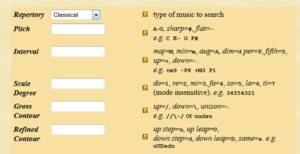
The Themefinder search engine was prototyped at CCARH in 1996 by David Huron, Andreas Kornstädt, and Walter B. Hewlett. A large number of Stanford University students including Unjung Kim and Leigh VanHandel plus visiting students including Bret Aarden participated in its early development. The search engine was originally developed to study user behavior. Over the intervening years it has been used for a large statistical study of search-efficiency. The current search engine was built and is maintained by Craig Stuart Sapp.
Themefinder contains several repertories, most of which are publicly viewable and searchable. The principal repertories are Folk, Classical, and Renaissance. Although more than 100,000 incipits and associated metadata are present in the database, users may select just one. "Hits" satisfying search-criteria can be collected on the Themefinder Clipboard and can be exported.
Incipits can be searched at five points on a continuing from the most specific to the fuzziest. Filter for meter, mode, and key may be used. MIDI files are available for each entry. Help menus are available at the website. Those interested in contributing an encoded repertory to Themefinder should describe the existing repertory and format in a query letter.
Related literature: "Search-Effectiveness Measures for Symbolic Music Queries in Very Large Databases" (Craig Stuart Sapp, Yi-Wen Liu, and Eleanor Selfridge-Field, ISMIR Proceedings 2004)
Vocal Music Instrumentation Index (VMII)
Website: https://www.vmii.org
Performers often wish they could easily locate selections featuring their chosen instrument.The information is elusive. Multimovement works usually have summary descriptions. Although the content here is textual only, performers can quickly locate appropriate repertory at the single-movement level. Currently more than 12,500 listings are included, with headings for specific instruments, composers, etc. Teachers and historians will also find this index to be very helpful. The European Early Music Network awarded this site its New Technology Prize.
World Digital Library
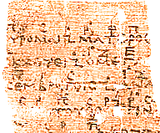
Website: http://www.wdl.org
This UNESCO-sponsored listing of digitized sources includes a number of significant musical works in single-item digitizations. The first chorus of Euripedes' Orestes (408 BCE, from the Austrian National Library) represents the oldest contribution found here. Although the source is necessarily deteriorated, vocal and instrumental symbols can be seen within it.
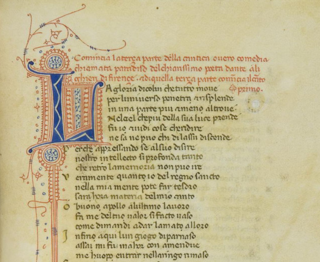
Other WDL holdings include numerous sacred vocal works from the Ars Nova and Renaissance, German operettas, and twentieth-century sheet music. More than 2,700 historical maps from all parts of the world, a handful of treatises on music and music theory (including later colored drawings of St. Jerome's "Instruments of Hieronymous" (before 420 CE), and a seventeenth-century manual on the Chinese zither (quin) are found among a lengthy list of other holdings useful to music scholars.
Resources for Music Theory
Center for the History of Music Theory and Literature (CHMTL)
Website: http://www.chmtl.indiana.edu
The Center for the History of Music Theory and Literature (CHTML) is a research center at the Jacobs School of Music at Indiana University. It maintains several searchable archives of texts pertinent to the history of music theory. While the TML is exclusively devoted to writings in Latin from antiquity to the seventeenth century, the rise of parallel efforts for digitizing the texts of music-theoretical writings in modern languages spawned several efforts now managed at CHTML. All projects have introductions and give clearly state principles of orthography. Current projects are listed below:
- Thesaurus Musicarum Latinarum(TML), begun in 1990 and extensively developed by Thomas Mathiesen at Indiana University, with the collaboration of many scholars in the US and abroad. Giuliano Di Bacco, who has headed the project since 2014, has introduced new faceted approaches to structuring the material and has integrated images. The version released in 2020 (subtitled Online Archive of Music Theory in Latin), contains a search bar in the masthead. (The TML was possibly the earliest database to be fully searchable in a single pass.) The lexicon of musical terminology up to c. 1600 extends to evidence from speech, literary references, music-theory manuscripts, and first lines of tracts. 950 texts; precise folio numbers in citations.
- Saggi musicali italiani (SMI) contains texts in Italian from the Renaissance through the nineteenth century. Founder and project director: Andreas Giger, Louisiana State University. 33 texts to date.
- The Traités en français sur la musique (TFM) covers the middle ages through the nineteenth century. Sources in French include items published in Belgium. Founder and director: Peter Slemon, University of Toronto. 160s texts to date.
- Treatises on Music in English (TME) concentrates on sources from the fourteenth through eighteenth centuries. Founder and director: Peter Lefferts, University of Nebraska, Lincoln.
Early Music Theory
Website: http://earlymusictheory.org
Early Music Theory subsumes the new digital edition of the works of Johannes Tinctoris. Twelve treatises are listed on the earlier Stoa site, and three are viewable.
German writings on music theory and musical institutions
This digitized collection (176 titles) from the Bavarian State Library emphasizes works printed between 1516 (Glareanus, Basel) and 1900. It includes a number of books related to individual theaters (mainly German).
Lexicon musicum Latinum
Website: http://www.lml.badw.de/info/index.htm
This lexicon of musical terminology up to c. 1600 extends to evidence of speech, literary references, music-theory manuscripts, and first lines of tracts.
Monuments of Partimenti
Website: http://web.at.northwestern.edu/music/gjerdingen/partimenti/index.htm

Robert Gjerdingen's online website for partimenti introduces the basic approach to improvisation and composition based on suggestive figured-bass sketches that survive, according to the seminal work of Giorgio Sanguinetti's The Art of Partimento (2012), in abundance from the eighteenth century. The website is still under development, but between the materials available here and the companion site linked to the book (above), users can form an elementary notion of the practice.
The Beginner's Guide is here. The Rule of the Octave indicates likely movement in the treble voice from note to note in relation to movement of the bass. An acquaintance with this practice enabled keyboard players to improvise music in the style of many eighteenth-century composers.
Peter van Tour maintains an incidental list of manuscript sources (c1700-1850) for partimenti in Uppsala University. Look here for further information. The search facility, which supported RISM sigla, note strings, and Gjerdingen numbers, is not currently operative.
Thesaurus Musicarum Italicarum (TMI)
Website: http://euromusicology.cs.uu.nl
Frans Wiering's Thesaurus Musicarum Italicarum, which is entirely separate from the TML, represented a second incarnation of his CD-ROM encodings of all the treatises of Gioseffo Zarlino (1995). The CD offered all the musical examples as MIDI and DARMS files as well as in modern notation. Its viability was undermined by the evolution of operating systems in the early 2000s. Other works of Italian music theory from the decades following Zarlino were encoded subsequently by students at Utrecht University.
Historical Audio and Video (Film)
The history of performed music is a compelling interest of a growing sector of musicology. Incremental changes in the retrospective reach of copyright in the several countries that were most active in early recording activities inhibit public access to exemplars. Work proceeds nonetheless. Only sites with accessible material are listed here.
Archives Sonores CREM-CNRS
Website: http://archives.crem-cnrs.fr/archives/fonds
This ethnomusicological archive, within the Musée de l'Homme, holds cylinders, 78s, vinyl disks, and various other formats in use for recording since 1900. Roughly two-thirds of its 30,000 documents contain sound. Five thousands of its recordings are classified as rare. The collection is fully catalogued. The Centre de Recherche en Ethnomusicologie (CREM), established in 2009, is physically located in l’Université de Paris Ouest in Nanterre (FR). A gateway to other sound-based projects is available here.
Berliner Gramophone Disc Collection (Archives at Yale)
Website: https://archives.yale.edu/repositories/6/resources/5878
This fully digitized collection of 732 flat-disc recordings made between 1892 and 1912 is well endowed with marches (many by John Philips Sousa) and other music of a military character plus numerous Russian, Polish, French, and German vocal items, and excerpts from Italian operas (chiefly by Giuseppe Verdi).
Center for the History and Analysis of Recorded Music (CHARM Archive)
Website: http://www.charm.rhul.ac.uk/sound/sound.html
The CHARM project based at Royal Holloway College, University of London, sponsored a wide array of projects related to investigating music history entirely through recordings. The 5,000 recordings available here, which were carefully provided today to researchers under the auspices of Kings College, London. They are available in a lossless format (FLAC). Among the main categories are "house conductors", "Cortot discoveries", and "Musicians of Britain and Ireland". Recently 2,000 sides of 78 rpm records from the Kings Sound Archive have been added to the pool.
CHARM
Website: https://www.charm.rhul.ac.uk/index.html
The CHARM archive, developed by Royal Holloway College (Surrey, UK) in the 1990s and early 2000s, put a total of 5,000 recording online. Its focus was on the understanding of music history through (recorded) performance. It forms part of the CNRS collection.
Classical Discography
Website: http://classical-discography.org/search.php?reset=on
This bibliographical database has the virtue of disclosing how many early recordings were made of the music of composers we consider to have been "rediscovered" in more recent times. It is also a worthy tool in showing changes of taste and of recording technology. Records have been culled from extensive research in record-company archives in the US and Europe, with particularly emphasis on 78 rpms not well documented elsewhere. Where company documentation is lacking, the compiler (Michael H. Gray) has consulted library catalogues and dealers' lists. Labels so far surveyed include Ariola-Eurodisc, Columbia (Europe and America), HMV (Europe and Japan), Deutsche Grammophon, RCA Victor, Philips, Telefunken/Teldec, Erato, Decca (USA and UK), Argo, Oiseau-Lyre, Vox, Westminster, Capitol, and many others. Links to Durbeck Archive (classical and choral music on LPs) and Francois Nouvion's Historical Tenors, and other parallel sites are provided.
Cylinder Preservation Project, UCSB
Website: http://cylinders.library.ucsb.edu/homewax.php
The Cylinder Preservation and Digitization Project at the University of California at Santa Barbara contains several spokes. A "vernacular" collection of wax cylinders made outside the confines of commercial companies number 650 items. Not all are musical. Recording was a novelty at the turn of the twentieth century, and barnyard sounds took their place beside the spoken voice, fiddles tunes, and dialogue from minstrel shows. The holding collection contains well of 3,200 cylinders, some of which are available for adoption from time to time.
DEKKMMA (Sound Archive of the Royal Museum for Central Africa)
Website: http://music.africamuseum.be/english/index.html
The Royal Museum for Central Africa holds an ethnomusicological sound archive. Its digitization is the goal of this project, which is based in Brussels, the site of the Museum. The audio collections dates of the era of the Belgian Kingdom in Central Africa. Generous quantities of metadata and contextual data are being provided with the digitized recordings. At the "Find recordings" tab users can define a region by its modern designation, while in the faceted search that appears after a region is selected, on can select items by tribe, by function, and by title.
The Edison Recorded Sound Archive
Website: http://www.nps.gov/edis/historyculture/requesting-an-audio-recording.htm
This collection, administered by the US National Park Service (Thomas Edison's lab is classified as a national historic park), holds 11,000 cylinder recordings and 38,000 disc recordings from the years 1898-1929. Some recordings have been reissued on CDs. In general users may request the copying of one recording at the time. No online access is currently provided from this site, but some materials can be found at other sites. The Archive is rich in related holdings, including black-and-white photographs of early performers (c. 5,000) and correspondence.
Three hundred forty-one silent films made by the Edison company between 1898 and 1912 can be found at the Library of Congress's Inventing Entertainment website.
The Emile Berliner Collection (Library of Congress)
Website: http://memory.loc.gov/ammem/berlhtml/berlhome.html
The inventor of the microphone and the disc recording, the legacy of Emile Berliner (1847-1929) includes 400 documents and 118 sound recordings in the Library of Congress. Like Edison, he experimented with film as well as audio recording. Digitization of this collection is in progress.
Gharamophone
Website: https://gharamophone.com
The Gharamohphone website seeks to preserve and make accessible North Africa's Jewish musical past, "one record at a time". The project is based in Montréal. Most recordings accessible at the site come from Morocco, Algeria, or Tunisia. According to the website, the name Gharamophone combines the Arabic “gharam” (غرام) –– meaning, “love,” “passion,” and “infatuation” in Arabic and which is the frequent subject of North African song –– and “gramophone,” the word which has long been nearly synonymous with the early twentieth century phonograph." Christopher Silver (McGill University) is the curator. The recent blogpost "Andalusian Music from the Magreb" [2] calls attention to its Andalusian connections.
The Glenn Gould Archive
Website: https://www.collectionscanada.gc.ca/glenngould/028010-3000-e.html
This tape archive (accessible via RealPlayer files) shows us the legendary pianist at work, with recordings made at home, while testing halls before concerts, and the like. Most come from 1970s and 80s.
The Global Jukebox
Website: http://theglobaljukebox.org
The heart of this project is rooted in a lifetime of song research by Alan Lomax (1915-2002). Over his long life he recorded music and interviews with folk musicians throughout the Western Hemisphere. He spent the 1950s based in London, where he assembled a multi-volume collection of "folk and primitive" music for Columbia Records. (His relocation enabled Lomax to escape the brunt of McCarthyite discrimination against prominent figures from the music world--including Aaron Copland and Leonard Bernstein. He was at various points under surveillance by Britain's MI5 and, in the US, by the CIA and the FBI. No charges were ever brought.)
In 2012 the Library of Congress agreed to make his 5,000 hours of sound recordings, 400,000 feet of film, 3,000 videotapes, and 5,000 photographs available for The Global Jukebox. Lomax has devoted the last two decades of his life to this project. In its current state the website has significant debts to long-time associates including Lomax's daughter Anna Lomax Wood and a team of specialists who provided technical support.
Using geospatial data The Global Jukebox will enable you to explore these recordings by place and by many other parameters. It is the first open-access evidence of this decades-long collection development. Under the auspices of the Association for Cultural Equity, which Lomaz founded, current researchers welcome contributions of metadata, especially song titles. An earlier collection of his work (1937) is housed at the University of Kentucky.
It was Lomax's intention to implement his work in cantometrics (1959) and choreometrics in a computer system (initiated by the musicologist Victor Grauer). Considering that 37 criteria were used for the initial version of the system, the system was highly ambitious. The implementation of choreometrics at this website accommodates 119 variables.
Historical Tenors
Website: http://www.historicaltenors.net
This website contains recordings but emphasizes information about tenors from all over the world. It is indexed by name and topic, with pages dedicated to comparison of rendering by multiple singers of the same arias.
Internet Archive 78RPMs
Website: https://archive.org/details/78rpm
Recordings mastered for 78 rpms (revolutions per minute) were produced prolifically from the 1920s into the 1950s. The Internet Archive collection includes cylinder recordings and 78s. It is searchable in several ways. The download statistics shows that the most popular holdings are songs sung by Enrico Caruso, Bill Murray, Edith Piaf, and Al Jolson. Current holdings number 13,200.
Ivey Collection of Electronic Music (Peabody Conservatory)
Website: https://streaming.peabody.jhu.edu/collections/1805
Jean Eichelberger Ivey organized the first electronic music studio at Peabody Conservatory in 1969. This streaming site, maintained by the Arthur Friedheim Library, offers full recordings of 234 works (predominately for reel-to-reel tape). Many are quite substantial. Associated documents in sound and text are also present.
Mirskey Collection of Salon Orchestra and Silent Film Music
Bronislaw ("Nek") Mirskey (1887-1927) was a Polish violinist and conductor who worked as music director at several movie theaters across the United States between 1914 and 1927. His efforts to improve the quality of musical accompaniment performed live for early silent film productions are an important part of the history of both music and cinema. His career as a cinema orchestra leader spanned stints in Dallas, Boston, New York, Washington, D.C., and elsewhere. This newly digitized collection at the University of Pittsburgh (3,500 items) is unusual in containing complete publication series of photoplay music and in retaining published instrumental parts (in addition to to piano scores).
The National Jukebox (US)
Website: http://www.loc.gov/jukebox
The National Jukebox, serving selected holding of the Library of Congress in Washington DC, certainly give the flavor of recording. Much of their material comes from the Victor Company (later RCA Victor) and the Berliner Company. It currently (2014) serves more than 10,000 works but remains a work in progress. A substantial range of popular and folk songs from c. 1900 reflects the great ethnic diversity of the U.S. in that era. Yet more than half the materials were recorded in Camden, NJ (the home of the Victor Company). Users add the works they want to hear to a playlist and listen to streamed examples (the best current workable solution to rights issues). Most available holdings are from the years 1900–1930.
New Zealand Pianola Site
Website: http://www.pianola.co.nz/index.asp
The New Zealand Pianola website is well-known to honky-tonk enthusiasts. Through painstaking research over many years, many hundreds of piano-roll performances have been captured in MIDI files of high quality. The user interface makes searches and launching sound files simple. The music comes mainly from the years 1900–1930. Zipped packages of files for individual years and special collections can be downloaded. At last reckoning more than 3500 files were available.
O'Neill Cylinder Recordings
Website: http://archives.irishfest.com/dunn-family-collection/Music.htm
Cylinder recordings (32) collected by Francis O'Neill of Chicago and forming part of the Dunn Family Collection within the Ward Irish Music Archives include tunes by uilleann pipers Patsy Touhey, James Early, and Bernard Delaney, as well as fiddlers Edward Cronin and John McFadden. They constitute the earliest known aural documentation of Irish traditional music as it was performed a century ago. Their Flash presentations here provide commentary on later performances of the pieces, as they found their way onto 78rpm records and other musical media. Bibliographical references to earlier printed version are also provided. Manuscript transcriptions of the music are reproduced as available.
Player Piano (Pianola) Project, Stanford University
Website: http://library.stanford.edu/projects/player-piano-project
The Player Piano Project, based in the Stanford Department of Music and Archive of Recorded Sound, investigates performance practice as captured in piano and organ roles of the late nineteenth and early twentieth centuries. The project is based on the Denis Condon Collection of Reproducing Pianos and Rolls, recently moved from Sydney (Australia) to Stanford. The collection contains 7,500 rolls, mainly for piano, and ten roll-playing instruments of diverse manufacturers (Ampico, Duo-Art, and Welty-Mignon). Cataloguing and instrument restoration are underway. Digitization methods are under development. A demo is shown in the project link above.
Russian Records
Website: http://www.russian-records.com/categories.php?cat_id=694&sessionid=og3ubh0u5a3ko8f9q56ioolb34
Russian Records hosts a tremendous, actively growing collection of labels produced in Russia from 1888 until recent times. Rich metadata makes it possible to isolate selections not only by label and year but also by the intended speed of rotation of the disc and other parameters of manufacture. Associated documentation is also provided. Upward of 15,000 items (10,000+ "major label" titles; 11,000+ pre-World War II Soviet titles) are listed, and all recordings have an associated sound file. The site also includes foreign labels, cylinder recordings, experimental works, and pirated labels from Aurora (1911) to Zolphone (1905). The sound file below contains a gypsy dance ("Le Manteau de Neige") by Mark Maryanovsky, arranged by René Cloereg, with violin soloist Pepito Sanchez (Saturn label, 78 rpm, n.d.).
Silent Film Sound and Music Archive
Website: http://www.sfsma.org
This archive of music for silent cinema and related film technologies for research and performance was established in 2014. It includes sheet music for silent film, instruction manuals for film accompanists, and a bibliography of resources on silent-film sound and music. A search box supports access by title, date, composer, arranger, mood, and other categories pertinent to film music. SFSMA, directed by Kendra Preston Leonard, is governed by a board of leading film-music scholars. It is affiliated with the American Theater Organ Society and the Wharton Studio Museum. All items in this collection are tagged using Dublin Core metadata and are downloadable via an Open Data Commons Attribution (ODC-By) License.
Robert Shaw Chorale
Website: https://archives.yale.edu/repositories/6/archival_objects/2685750
The Robert Shaw Chorale was especially renown in the post-war years. Their collection of test pressing, stored together with letters and other papers in the Gilmore Music Library at Yale University, is valuable for its accessibility and its concentration (1938-1953) on repertory that was taken to present America (patriotic and Broadway songs). It includes the Requiems of Luigi Cherubini and Johannes Brahms as well as J.S. Bach's B-Minor Mass. Gratuitous registration required.
Trachtman Roll Scanning
Website: http://www.trachtman.org/rollscans/RollListing.php
This collection of more than 8,000 piano rolls includes 2,368 that are publicly available as MIDI files. (The remainder cannot be distributed because of copyright restrictions.) The available rolls offer examples of Kansas City jazz, a significant number of classical titles (Balakirev, Brahms, Chopin, Delibes, Dvorak, Gounod, Liszt, Paderewski, Paganini, Rossini, Wagner), and substantial number of classics of ragtime and other popular styles of the early twentieth century.
ViFaMusik Audio Collections
Website: https://www.vifamusik.de/en/audiocollection/recordings-and-podcasts
This aggregation of web links for recordings has several component parts: choral music, folk and fiddle tunes, and ethnic repertories from all over the world. The archive of Chinese music [3] labeled in Mandarin and English is one of its many unusual entities. Numerous collections include auxiliary material--photographs, videos, podcasts, and descriptive material.
The Virtual Gramophone: Canadian Historical Sound Recordings
Website: https://www.collectionscanada.gc.ca/gramophone/028011-120-e.html
The Virtual Gramophone: Canadian Historical Sound Recordings gives comprehensive coverage to the history of Canadian contributions to the gramophone repertory. The repertories it covers are diverse. They include dance music of the 1920s, Quebeçois recordings of the 20s and 30s, popular music from New Brunswick, military music in Berliner recordings sold in Montreal in the first decade of the twentieth century, and other identifiable collections. The items consist predominately of 78s 50,000 items), with some cylinders (7,000). Listeners can select either RealAudio or MP3 files (downloadable). The database can be searched by voicing, instrumentation and many other parameters.
Historical Maps
AfricaMap
Website: http://worldmap.harvard.edu/africamap
While AfricaMap is mainly intended for modern socio-economic studies, the website includes historical maps and UNESCO World Heritage information, together with modern tribal, linguistic, and some colonization data. Some views are potentially useful for ethnomusicological and intercultural studies.
Bodleian Libraries Digital Collections (Maps)
Website: http://www.bodleian.ox.ac.uk/subjects-and-libraries/collections/digital
Among the Bodleian Library's digitized holdings are a number of historical maps from the far corners of the world as known in earlier centuries. Notable ones include:
- The Selden Map of China (c. 1659), a conserved image of MS Selden supra 105.
- The Gough Map (date undetermined), based on Gough Gen. Top 16, one of the earliest maps to identify Britain, can be evaluated from the linguistic properties of place names.
British Historical Maps
Website: http://www.nationalarchives.gov.uk/maps
The National Archives (UK) hosts a large collection of maps and also has links to parallel materials with similar content.
China Historical GIS
Website: http://www.fas.harvard.edu/~chgis/index.html
When the China Historical GIS (Graphical Information System) was founded at Harvard University in 2001, its ambition was to provide mapping coordinates and related information for more than two millennia--from 221 BCE (the time of unification) to 1911 CE (the end of the dynastic period). It collaborates with several other projects and responds to those requiring specific historical time-slices and finite geographical areas. Part of what China Historical GIS captures is the changing boundaries ("instances") of populations and linguistic groups.
Georeferencer
Website: http://showcase.iiif.io/showcase/georeferencer
Georeferencer is commercial software that is heavily used by research libraries to facilitate the overlay of scanned maps with modern identifications. The links above shows an application used by the British Library. Details of subscription options for individual researchers are shown here. It is useful for comparing maps of the same places in different historical timeframes.
Getty Thesaurus of Geographic Names
Website: http://www.getty.edu/research/tools/vocabularies/tgn
Anyone who has to reconcile place names on maps with place names in literary or historical sources (including composer biographers, opera libretti, and ordinary literature in battle-weary countries) will know the problem of names that are not the same. This Thesaurus of Geographic Names goes a long way in filling the gap. Since the TGN continues to evolve, please read the help guide and explore the hierarchy display before using the search box.
Munich Digitalization Center (Maps)
Website: http://www.digital-collections.de/index.html?c=sammlung&projekt=1352889503&l=en
This collection of almost 3,000 early maps ranges in date from 1500 to the early twentieth century. It covers all of Europe and beyond with a primary concentration on areas lying today in Germany, Austria, and the Low Countries.
Old Maps Online (OMO)
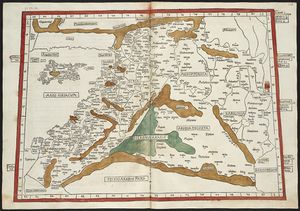
Website: http://www.oldmapsonline.org
Old Maps Online contains more than 400,000 maps. A collaboration of many national libraries, the project is currently maintained by volunteers in cooperation on the framework originally developed by Klokan Technologies GmbH. OMO accepts contributions of old maps. It includes atlases, globes, topographical maps, and other geographic paraphernalia. The graphical engine is designed to accommodate geo-referenced overlays on modern maps.
Pelagios (Graeco-Roman Antiquity)
Website: http://pelagios.org/maps/greco-roman
The Pelagios Project is an open framework for studies of antiquity. Its searchable digital map is invaluable for places that are rendered differently on modern maps. Plays and opera plots situated in Antiquity can be decoded quickly in the Graeco-Roman map shown here. Monuments, institutions, and roads are identified on the "Details" screen. Many additional sites (some related to Pelagios, some independent) exist elsewhere. We list a few here:
- Antiquity à la carte (University of North Carolina)
- Digital Atlas of Roman and Medieval Civilization (Harvard University)
David Rumsey Map Collection (Stanford University)
Website: http://www.davidrumsey.com
Contents: Eighteenth- and nineteenth-century maps of the Americas. All maps are geo-encoded to facilitate geospatial and past-time applications.
Perry-Castañeda Historical Maps (University of Texas)
Website: http://www.lib.utexas.edu/maps/historical/index.html
Notable for its spatial and historical spread as well as the detail with which the maps are specified chronologically. Many sources are scanned from maps printed in then nineteenth (or earlier) century. The link to Historical Maps on other Websites is comprehensive.
Early Newspapers
ANNO: Austrian Newspapers Online
Website: http://anno.onb.ac.at/cgi-content/anno
The ANNO collection of newspapers initially focused on collections found in Vienna and focused on nearby portions of the former Austrian Empire, but it has recently added significant quantities of materials from the extended reaches of the wider historical precincts of the Empire. One may find reproductions of the news from the Czech Republic and Moravia as well as issues from Bulgaria and other points east. These additions mainly date from the nineteenth and twentieth centuries.
Newspapers were published in Austria on Wednesdays and Saturdays, but like printed aggregations everywhere they incorporated reports from elsewhere as the news was received. (In most cases it was re-reported within two weeks.) Readers will be grateful for the calendars that introduce each year of the collection (e.g. for 1705) and also for the thumbnails of each page of every issue. Almost a century (1606–1703) remains to be added. The overall range of the Austrian materials is from 1568 to today, but for the earliest decades see the Fuggerzeitungen below.
"Chracas" Digitale: Il Diario di Roma
Website: http://scaffalidigitali.casanatense.it/Products/News
This "diary" of news flowing into Rome from all over Europe was introduced as the Diario d'Ungheria [the Diary of Hungary] in 1716. It initially emphasized military news. Its title shifted to the Diario ordinario in 1718 and continued under this title until 1808, when it became the Diario di Roma. In its second phase it devoted great attention to cultural news. Its rate of publication had reached three issues a week by 1721. Publication continued up to 1836. Digitization of all three series in the Biblioteca Casanatense, Rome, is now complete.
Die Fuggerzeitungen (The Fugger News Dispatches)
Website: http://fuggerzeitungen.univie.ac.at
The Fugger news dispatches of 1568–1605 (in manuscript) offer a fascinating portrait of early journalism. Placed online by the Historical Research Institute of the University of Vienna, they are viewable in several different frameworks, one of which shows geospatial aspects of news gathering and distribution. The printed ANNO series began immediately after the cessation of this series. Bibliographical details are subsumed in the Deutsche National Bibliothek.
Gazzetta di Mantova
Website: http://digilib.bibliotecateresiana.it/sfoglia_periodico2.php?tG=GAZZETTA%20DI%20MANTOVA
The digitized Gazzetta di Mantova (1665-1901) is a truly stupendous collection held in the Biblioteca Teresiana, Mantua. The Duchy of Mantua was rich in cultural trappings of many kinds--painting, improvised comedy, poetry, drama, sacred and secular music, and equestrian exercises. The Teresiana has also digitized its substantial Jewish holdings (28,000 items acquired from the local Hebrew community in 1930) including some works of music.
Gazzette bolognesi
Website: http://badigit.comune.bologna.it/Gazzette/gazzettedefault.asp
The printed Gazzette bolognesi have intended parallels with the Diario di Roma. Bologna was historically a papal state. It gathered the same news and valued it similarly, though occasionally with less emphasis on the affairs of cardinals. Because of larger page size the Gazzette could convey more news from more places. (The Gazzette initially had only four pages per issue.) This fully digitized series, from the Biblioteca dell'Archiginnasio, runs from 1645 through 1796.
Historic American Newspapers
Website: http://chroniclingamerica.loc.gov
The extensive repository of scanned newspapers (1690 to the present) in the Library of Congress is a rich resource for information that can be tied to particular place and date. At present (2017) almost 12 million pages have been scanned. A more complete search facility for identifying archived US newspapers is also available. Rich troves of biographical information and concert reviews can be found when precise delimiters are available.
Le Mercure galant
Website: http://gallica.bnf.fr/Search?ArianeWireIndex=index&p=1&lang=EN&q=%22Le+Mercure+galant%22&x=0&y=0
Many issues of Le Mercure and its analogues under various titles (Le Mercure de France et al.) can be found be searching the Bibiliothéque National's Gallica website (as above). Single installments accrue steadily but holes remain. Users must be aware of the periodical's complex history of changes and the inclusion of information that is not always accurate. A finding aid for digitized issues from 1678 to 1714 is here.

A detailed list of issues of the Mercure galant (1672-1710) with searchable diplomatic transcriptions is here. Many issues from subsequent years can be retrieved by date and title variant from Gallica.
A companion site ("Airs du Mercure galant"") within the NEUMA project is extracting songs that were printed on inserted leaves in many of the issue. See the example above.
Spanish Historical Newspaper Portal (Hemeroteca Digital)
Website: http://hemerotecadigital.bne.es/index.vm
One can filter in this search engine by the name of the series, by location, and by year (1683-2015). Few of the series listed are concerned with music or the arts, and a few that are (such as the Gaceta de Madrid) are not currently included. However, some specialized titles include the Gaceta musical de Barcelona and the Revista musical de Bilbao, both reporting on 20th-century events.
Music Magazines
Musical Magazines
Website: Musical Gazzettes
Almost 25,000 musical magazines published in Italy before the first world war have been digitized by the Centro internazionale di ricerca sui periodici musicali (The International Center for Research on Musical Periodicals) in Parma. Among their holdings the most prolific were Milan's Gazzetta musicale di Milano, London's Musical Standard, and Paris's Revue et gazette musicale. The best way to find them from this start site at the Internet Culturale is to use the filters for language and date of publication at the left.
The Phonographic Newspaper
Website: Phonographische Zeitschrift
The Phonographische Zeitschrift (Phonographic Newspaper) was published on poor-quality paper from 1900 to 1938. It was subtitled "a fact sheet for the music- and speech-making industry". Most issues available (2021) apart from those for five scattered years from which nothing survives.
Open-Access Music Journals
Website: Open-Access Music Journals
Matthew Franke's list of open-access music journals is quite comprehensive. Contributions can be sent to him at this address.
Large Humanities Digital Corpora
Deutsches Textarchiv (German Text Archive)
Website: http://www.deutschestextarchiv.de/list
This carefully executed project aims to put the classic printed literature in German online. Its holdings are far better curated than the same titles in Google Books and other aggregation gateways. Optically recognized text is shown side-by-side with the original image. Books are categorized by century (according to date of publication). Contains dramas (Goethe), treatises (Karl Marx), autobiographies (Otto von Bismark), lyrics (Brockes, Klopstock), novels (Jean Paul), legal writings, local history, travel literature, theology, satire, and a long list of short-run early newspapers. DTA holdings are TEI-complaint. The great strengths of the DTA include its internal search, its side-by-side view of original and recognized text, and its tiered metadata structures.
Collaborative Digital Libraries Gateway
Website: http://international.loc.gov/intldl/find/digital_collaborations.html
This Library of Congress gateway for international projects gives an overview of collaborative projects with an American component, currently including Brazil, France, the Netherlands, and Siberia.
Early English Books Online (EEBO)
Website: http://quod.lib.umich.edu/e/eebogroup
Early English Books Online offers a digitized image of every text published in English between 1483 and 1700. At its core it is commercial, but several universities support searches of the material. More than 60,000 texts are searchable at the University Michigan site linked above. Publication metadata is provided by the Text Creation Partnership.
European History Primary Sources
Website: http://primary-sources.eui.eu/search-options
European History Primary Sources, an umbrella site for digital projects and resources, offers a [Sources http://primary-sources.eui.eu/search-options free-text search] across all its textual resources, allows searches to be saved, and provides lists to [primary-sources.eui.eu/browse-repositories digitized resources] and national portals where available. Its geographical and cultural breadth (from Iceland to Turkey) is immense.
Medieval Nordic Text Archive (MNTA)
Website: http://www.menota.org/forside.xhtml
The MNTA is a TEI-compliant collection of writings in old Scandinavian languages. It offers users an appropriate text font and an encoding manual for those who wish to collaborate.
Oxford Text Archive (OTA)
Website: http://ota.ox.ac.uk
The OTA was begun on mainframe computers with the curated encoding of texts important for the study of the languages and literatures both early and modern. Its website contains numerous links to tools and related projects.
Perseus Digital Library
Website: http://www.perseus.tufts.edu/hopper
Perseus was originally developed under the direction of Gregory Crane with the aim of enabling students to explore the classical literature encoded by Packard Humanities Institute and the Thesaurus Linguae Graecae. It subsequently expanded to incorporate many other aspects of classical civilization, including graphical explanations of textual references, as for example here. It now extends to research in other languages and later periods. Its catalogue is online. A separate digital lexicon (e.g. this one, for Arabic-English translation), is available for each one.
Packard Humanities Institute Early Texts
Website: https://packhum.org
The Packard Humanities Institute has encoded and in some cases translated a large quantity of text from Roman antiquity and the Persian middle ages. Texts are indexed and are easily browsed and searched. They are available for personal use only. Musical references are incidental.
- PHI Latin Texts (200–c 600 CE)
- PHI Persian Literature in Translation
Rousseau Online
Website: http://www.rousseauonline.ch/tdm.php
Rousseau's writings contain countless items of interest. Here you can find the text of Pygmalion, Rousseau's Essay on Modern Music, his letters to Charles Burney and Messieur Raynal, the Dictionnaire de la Musique, and a host of miscellaneous writings from all periods of his life. The script is modern. ePub and PDF formats are both supported.
TextGrid Repository
Website: https://textgridrep.org
The TextGrid Repository, a virtual research environment for the humanities, contains metadata for a wide-ranging miscellany of verse, prose, drama, and other writings. It has been developed at the University of Göttingen. Verse is the largest category, with 118,000 items at present. The other three combined amount to roughly 66,000 items. The "grid" is formed by hyperlinked metadata. The objects themselves are in various other locations but will eventually be directly downloadable. Contributions of encoded texts are accepted. Please enquire first (https://textgrid.de/en/kontakt/).
Théâtre classique (Classic Theater)
Website: http://www.theatre-classique.fr
Théâtre classique (Classic Theater) is an umbrella website focused on French dramas from the sixteenth into the twentieth century. Full texts (1,500) and more than one hundred polemical and theoretical pieces are included. These are provided in HTML, PDF, and sometimes other formats. Representative authors include Thomas Corneille, Denis Diderot, Jean de La Fontaine, Pierre de Marivaux, Molière (Jean-Baptiste Poquelin), Jean Racine, Voltaire (François-Marie Arouet), and many other dramatists. All texts are TEI-compliant.
Materials can be located by place, date, author, and several other rubrics. Among its dependent sites, the Pièces des registres de la Comédie Française (1060) gives genre and exact date for the performances of the Comédie from its founding in 1680 up to the Revolution. This project is a collaboration with the Comédie Française Registers Project. It builds on the work of the the Calendrier Électronique des Spectacles sous l’Ancien Régime et sous la Révolution (listed separately under Structured Databases).
Update for 2021 from CCARH: The home URL can be difficult to connect with, but component parts, e.g. the biographical dictionary of authors, comic actors, and musicians, are consistently available. ARTFL, a similar but older project, offers access to its resources through university subscriptions.
Thesaurus Linguae Graecae (TLG)
Website: http://www.tlg.uci.edu
The TLG issues from a pioneering effort to develop tools for the computerized study of ancient Greek. This effort preceded the advent of personal computer by a decade. Because of the need for special fonts, the collection is still mainly distributed on CD-ROM. An abridged version of the TLG is now available without cost. Access to the full corpus requires a subscription. A searchable online version of the Liddell-Scott-Jones Greek-English Lexicon is also available online.
Austrian Music lexicon (Oesterreichisches Musiklexikon online [OEML])
Website: Austrian Music Lexicon/Oesterreichisches Musiklexikon online
A great diversity of materials and formats is included here. Most cover pages lead to lists and bibliographies. Each article has its own DOI (Digital Object Identifier). The full-text search is very useful but not always comprehensive. Some articles are tied to current concert life and contain links to online ticket sales.
Image Banks and Iconography
Beethoven (Life and Works)
Website: https://www.europeana.eu/en/galleries/life-and-works-of-beethoven
This gallery in Europeana takes a liberal view of its subjects in offering everything from a picture of an earhorn to depictions of his patrons, neighborhood associated with his life, and the final draft of the ninth symphony.
Bildpostkarten (Historical music postcards)
Website: https://bildpostkarten.uni-osnabrueck.de
This collection contains picture postcards from ca. 1880 to 1945 mostly with musical contents (portraits of composers and musicians, music making, scores, dance, illustrations of compositions etc.). Digitized and maintained at the University of Osnabrück by Prof. Dr. Dietrich Helms. Historical documentation by Prof. Dr. Sabine Giesbrecht.
The Digital Image Archive of Medieval Music (DIAMM)
Website: https://www.diamm.ac.uk
Originally a site for viewing images of rare manuscripts at various levels of resolution, DIAMM is increasingly an umbrella site for diverse projects in medieval music. The core textual database is organized by source location. Registered users may add their own comments about individual works. List and faceted search capabilities are currently being added. DIAMM now (2017) includes online registration. Some of the value in DIAMM comes from its extensive canvas of what exists (almost 50,000 item listings to date). roughly 2,000 have images, some of very high quality. Digital restoration has always been a key provision of the DIAMM mandate.
Digital Scriptorium
Website: http://bancroft.berkeley.edu/digitalscriptorium
This image database of medieval and renaissance manuscripts based at the University of California, Berkeley, includes holdings from many US libraries, with extensive folio-specific information about each source.
Early Music Sources: Iconography Database
Website: https://www.earlymusicsources.com/Iconography-database
Early Music Sources, a growing collection of sources, images, instructional materials, and videos, provides ready access to images showing early musicians in performance.
Iconoteca (Portraits of Musicians, Bologna)
Website: http://www.bibliotecamusica.it/cmbm/scripts/quadri/quadri.asp
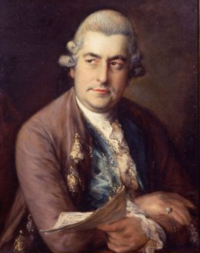
The collection of painted portraits of eighteenth-century composers and musicians that was begun by the Franciscan priest Padre Gio. Battista Martini (1706-84) attracted a much larger and more diverse repository of lithographs, photographs, and other graphical impressions of musicians and composers over time. These resources, numbering above 1,500 items, form a widely used source for printed books and concert programs. Martini also preserved more than 6,000 letters to and from musicians and others dealing with musical topics. The letters are also available online here, with corresponding numbers taken from Anne Schobelen's catalogue (New York, 1979). Through the letters it is often possible to date portraits accurately.
Index of Christian Art
Website: https://www.nypl.org/collections/articles-databases/index-christian-art
The New York Public LIbrary hosts Princeton University's aggregated Index of Christian Art, which contained more than 120,000 images from public and private collections in the English-speaking world plus additional indices, Roughly 100,000 are available to the public via fee-based institutional subscriptions. Holdings come from early centuries of Christianity to 1550.
Joconde (Musical Objects and Images)
Website: http://joconde.fr
Joconde, the French national database of museum holdings, includes generous search tools for musical holdings. (Enter "musique" in the search bar near the bottom of the frame.) Listings range from the widely seen to the obscure. Additional background can be found at this listing.
Joseph Muller Collection of Music and Other Portraits, New York
This collection of 6,422 portraits of musicians and composers, residing within the New York Public Library, was amassed by the private collector Joseph Muller (1877-1939). It is well known to those seeking illustrations for books and articles on musical subjects. Images date from the 16th to the early 20th century and include engravings, lithographs, and drawings. The collection also includes some portraits of political, literary, and intellectual figures. Prospective users will find that full citations for each item are given in several formats.
The Louvre Museum
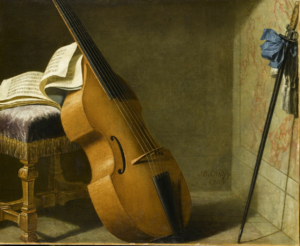
Website: https://collections.louvre.fr/en
In response to user interest in its website during lockdown, the Louvre Museum has made available almost 500,000 images (paintings, objects, literature, and several other categories of material). Categories containing items of musical interest include paintings of instruments, surviving parts of instruments (bridges, bows, etc.),
Manuscriptorium
Website: http://www.manuscriptorium.com/index.php
The National Library of the Czech Republic started this site to make available digital images of historical materials in its own collections and those of collaborators. its emphasis is on manuscripts, early prints, incubulae, and the like. In addition it is building research tools to support such endeavors. Manuscriptorium constitutes a subcategory of Europeana. Many of its holdings are conveyed in obsolete scripts, for which the site offers a useful character-identification lexicon called Gaiji. Its obviously later sheet-music collection has also been popular.
Medieval Manuscripts Online
Website: http://www.utm.edu/staff/bobp/vlibrary/mdmss.shtml
This list of links gives a broad international overview of the raw materials of medieval study and the heterogenity of these materials. The web interfaces are similarly varied and access to the sources is often indirect. Those who work on medieval subjects will find a lot of pick through here. There is inevitably some redundancy with several specifically musical resources listed above.
Prometheus Image Database
Website: http://prometheus-bildarchiv.de/copyright
The Prometheus Image Database is a German umbrella website for several dozen image repositories, all of which have made reproductions that are out-of-copyright and are freely available (at sizes up to 800 x 600) for research and teaching. More than 1.5 million images relating to cultural history are currently viewable. An institutional or individual sign-up with required for downloading. The images are predominantly associated with German, French, Italian, and Dutch subjects in art and archeology, past and present media, and the history of science and technology. Prometheus also offers guidance on the legal status of underlying works and photographic copies of them.
PRoMS (The Production of Reading of Musical Sources)
Website: http://proms.ac.uk
PRoMS, a UK collaboration involving six institutions, is focused on the physical details of polyphonic sources originating between 1435 and 1600. It builds on resources made available by DIAMM (UK), Manuscriptorium (CZ), and holding libraries in various countries. The sources are scattered throughout Western and Central Europe (Amiens to Zwickau in the alphabetical listing).
Emblems
Emblematica Online
Website: http://emblematica.grainger.illinois.edu
This umbrella project serves a growing number of library-based projects, which are here cited individually. Emblem books are rich resources for those interested in decoding visual information in early printed materials. The collective site currently (April 2014) lists 636 emblem books. Searches by title, text, and image are supported. There are two component parts. (1) The Herzog August Bibliothek (HAB) Emblem Books and (2) the University of Illinois Emblem Books.
The first makes available 636 emblems books, principally from the 17th and 18th centuries. It represents only a tiny fraction of the rich holdings of the Herzog August Bibliothek in Wolffenbüttel, which is particularly rich in seventeenth-century materials. August the Younger developed a three-tiered description system still in use today. Two noted figures--G. W. Leibniz (1691-1716) and G. E. Lessing (1770-1781) were later librarians. German materials are prevalent in the Illinois collection (as well as the German one).
Additional digitized emblem books from Duke University, the Getty Library, Glasgow University, and the University of Utrecht are in course of being uploaded. Each has a separate search page.
French Emblems at Glasgow
Website: http://www.emblems.arts.gla.ac.uk/french
This site hosts 27 browsable emblem books associated with 16th-century France. Eack book is linked to an alphabetical listing by author that enables rapid exploration. Some sources are bilaterally in Latin. A smaller collection of Italian emblem books is also held. This collection includes several important iconographical works by Andrea Alciati, whose influenced was substantial in France.
Medieval Legends with Music
The Carmina Burana
Website: http://daten.digitale-sammlungen.de/~db/0008/bsb00085130/images/index.html
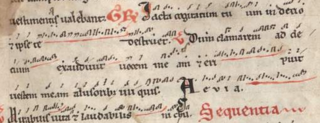
The 11th- to 12th-century collection of poetry and dramatic texts is rich in illustration and many of its texts contain cheironomic notation. Although found in a Benedictine abbey in Bavaria in 1803 and housed today in the Bavarian State Library, its origins point to compilation along the southern fringe of Austria, particularly Carinthia. Its Goliard sources come from Spain, the British Isles, France, and elsewhere in Europe. The texts are predominantly in medieval Latin, with some examples of Middle High German and Provençal. Musical settings of individual pieces are numerous following Carl Orff's 1936 presentation of 24 of the pieces (roughly one-tenth of the collection).
Songs of the Nibelungen
These poetic texts, considered to date from before 1280, display settings of the legends that inspired Richard Wagner. As is characteristic of those resources preserved for posterity in this period, the script is very carefully prepared, the vellum on which it is preserved obviously sturdy. Each Lied is illuminated by a carmine letter. The texts mention Sifriden (Siegfried), Prvnhilde (Brunhilde), Gvnther (Gunther), and others. The illustration shows the first three stanzas of "Wie Gvnther Sifriden zvo der hohzit bat" (No. 12 of 39). Later portions of the source contain religious songs (Klage).
Watermark Databases
Watermark examination provides a fundamental (analogue) method of sorting and ordering materials that are undated or lack a provenance. They are especially useful for clustering manuscripts by paper type. The combination of digital photography and tools for photographic editing can be combined with extensive existing research on paper-makers to shed new light on musical sources. The sites listed here include watermarks associated specifically with music manuscripts.
The Bernstein Consortium
Website: http://www.bernstein.oeaw.ac.at
The Bernstein Consortium offers a portal currently displaying 220,000 watermarks. Complementing the EU Memory of Paper project, it offers links to dozens of other websites with information and images of watermarks used from the middle ages onward. Relationships to music manuscripts are usually determined by the user,
WILC: Watermarks in Incuabula printed in the Low Countries (WILC)
Website: http://watermark.kb.nl/page
Many early printing presses operated in the Low Countries. This database lists more than 2,000 of them. It contains large numbers of beta radiographs from incunabla and forms part of the Bernstein project listed separately.
WZIS: Watermark Information System
Website: http://www.wasserzeichen-online.de/wzis/index.php

In contrast to discreet collections of watermarks reproduced online, WZIS is an information system linking graphical watermarks with details of the manuscripts in which they occur and, in some cases, the copyist responsible for the manuscript. Its system incorporates watermarks used throughout Europe andsprawls across many disciplines, eras, and venues. The project is based at the Landesarchiv of Baden-Württemberg. A graphical watermark lexicon called Piccard is under development at the Stuttgart Hauptstaatsarchiv. Related lexicons of makers and mills have also been developed. A textual search form is also available. Although we are aware of many other digital collections of watermarks, this one stands out for its tight coupling with music manuscripts, particularly in the large collections of the Berlin and Dresden state libraries, which are in turn linked to the RISM OPAC.
Copyright
Case Law: Fair Use Index (US)
Website: Fair Use Index (US)
The searchable Fair Use Index, operated by the U.S. Copyright Office, provides open access to judicial decisions under the U.S. provision for fair use, which is intentionally vague. Users may concentrate of decisions concerning diverse media and gain a notion of variably between different circuits (districts of the US).
Music Copyright Infringement Resource
Website: Music Copyright Infringement Resource
Charles Cronin's Music Copyright Infringement Resource, hosted by the Grould School of Law at the University of Southern California, enables anyone interested in music plagiarism and the grounds on which infringement cases are argued, to review arguments, decisions, and supporting media (page snippets and corresponding MIDI files). Cases from 1844 to the present are reviewed.
About
2014, 2015, 2017, 2021, 2022, 2023 Center for Computer Assisted Research in the Humanities, an affiliate of the Packard Humanities Institute, at Stanford University. Compilation and brief explanations are mainly by Eleanor Selfridge-Field with contributions by many colleagues including Ilias Chrissochoidis; Edmund Correia, Jr., David Day, Giuliano Di Bacco, Richard Freedman, Jan Koláček, Debra Lacoste, Jennifer Ward, the MEI community, and numerous project developers; design and technical implementation by Craig Stuart Sapp. DRM emphasizes open-access repositories. Many university libraries offer excellent links for licensed-access materials. Persistent URLs have been used where available. To report errors and oversights please use this link. Version 1.4.
